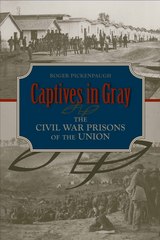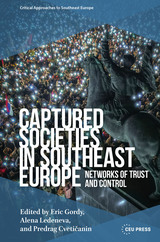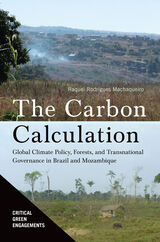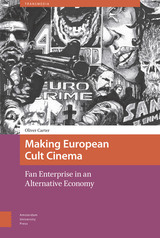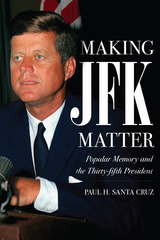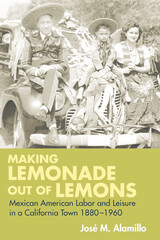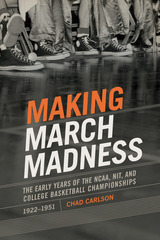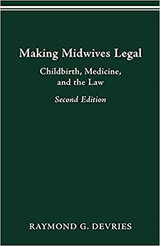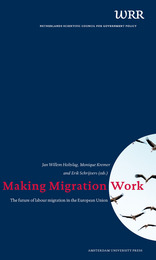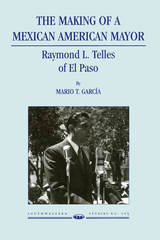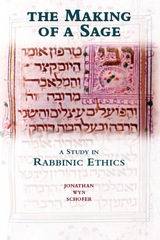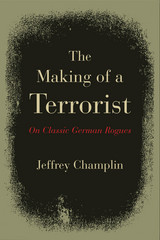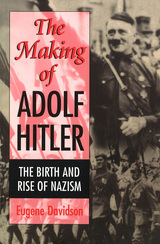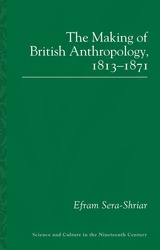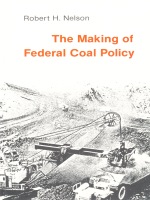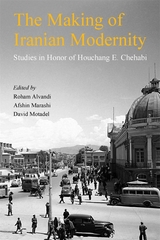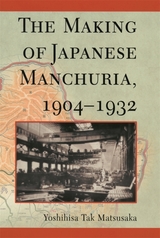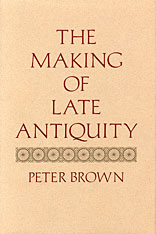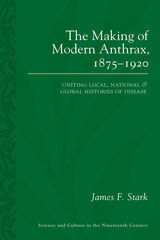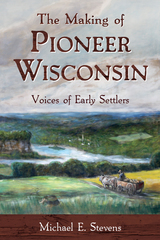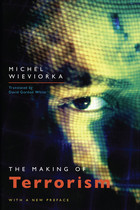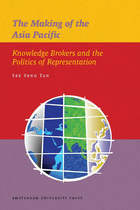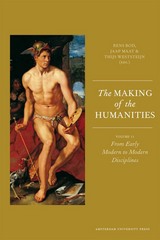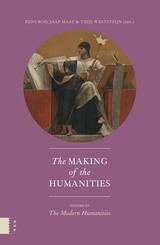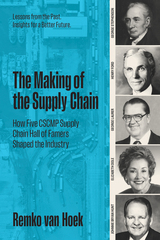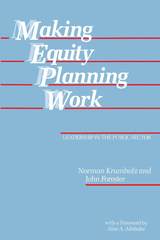 Making Equity Planning Work: Leadership in the Public Sector
Norman Krumholz and John Forester, foreword by Alan A. Altshuler
Temple University Press, 1990 Paul Davidoff book of the year award from the Associated Collegiate Schools of Planning, 1990
"No planner, I predict, will be able to consider his education complete during the next decade or so who has not grappled vicariously with the dilemmas Krumholz faced."
--Alan A. Altshuler, from the Foreword
From 1969 to 1979, Cleveland's city planning staff under Norman Krumholz's leadership conducted a unique experiment in equity oriented planning. Fighting to defend the public welfare while also assisting the city's poorest citizens, these planners combined professional competence and political judgment to bring pressing urban issues to the public's attention. Although frequently embroiled in controversy while serving three different mayors, the Cleveland planners not only survived, but accomplished impressive equity objectives. In this book, Norman Krumholz and John Forester provide the first detailed personal account of a sustained and effective equity-planning practice that influenced urban policy.
Krumholz describes the pragmatic equity-planning agenda that his staff pursued during the mayoral administrations of Carl B. Stokes, Ralph J. Perk, and Dennis J. Kucinich. He presents case studies illuminated with rich personal experience, of the Euclid Beach development, the Clark Freeway, and the tax-delinquency and land-banking project that resulted in a change in the State of Ohio's property law, among others. In the second part of the book, John Forester explores the implications of this experience and the lessons that can be drawn for planning, public management, and administrative practice more generally.
"Fascinating, illuminating war stories from the nation's most creative and progressive (ex)municipal planning director, capped by an intelligent and useful set of 'lessons.'"
--Chester W. Hartman, Fellow, Institute for Policy Studies, and Chair, Planner Network
"In this extraordinary book, Norman Krumholz and John Forester team up to enlighten those seeking a progressive approach to planning on how to interpret the Clevland experience. Krumholz provides an analytic chronicle of his role as Cleveland's planning director under three mayors and of his efforts to plan on behalf of the city's impoversithed majority. Forester examines the Cleveland story from the perspective of a planning theorist whose focus is how planning can serve people with relatively little political influence. Together the authors identify the opportunities that exist within the urban governmental structure. They conclude that planning and politics are not antithical and that an astute political strategy depends on sound professionalism. This well-written book is required reading for both students and practitioners of planning."
--Susan S. Fainstein, Rutgers University
"Norman Krumholz's story is one of the high points in the history of city planning and urban affairs in this country, and John Forester is one of its foremost interpreters of this history."
--Pierre Clavel, Cornell University
"Over and over again this book reveals the extraordinary levels of commitment, creativity, and effort that were needed and expended to divert the market-driven urban development process, however slightly, from its normal course--the reinforcement and reproduction of the status quo."
--APA Journal
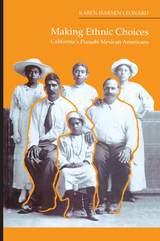 Making Ethnic Choices: California's Punjabi Mexican Americans
Karen Isaksen Leonard
Temple University Press, 1994 "[A] thoroughly original study that greatly expands our knowledge of how ethnic identities are formed. Leonard writes clearly and her inclusion of the voices of the Punjabi-Mexicans lends humor and depth to the history. This insightful study will be of interest to all scholars concerned with immigration and ethnicity and the history of California."
--The Journal of Asian Studies
This is a study of the flexibility of ethnic identity. In the early twentieth century, men from India's Punjab province came to California to work on the land. The new immigrants had few chances to marry. There were very few marriageable Indian women, and miscegenation laws and racial prejudice limited their ability to find white Americans. Discovering an unexpected compatibility, Punjabis married women of Mexican descent and these alliances inspired others as the men introduced their bachelor friends to the sisters and friends of their wives. These biethnic families developed an identity as "Hindus" but also as Americans. Karen Leonard has related theories linking state policies and ethnicity to those applied at the level of marriage and family life. Using written sources and numerous interviews, she invokes gender, generation, class, religion, language, and the dramatic political changes of the 1940s in South Asia and the United States to show how individual and group perceptions of ethnic identity have changed among Punjabi Mexican Americans in rural California.
"This is an extraordinary work. It is simultaneously an ethnography of early South Asian immigrant life in California, a model of fine-grained historical research using all manner of documents to reconstruct and interpret the migration flows, social structure, and family cycles of Punjabi men and their Mexican spouses, and a sophisticated examination of the complex role of 'identity' in their perceptions of themselves and their descendants.... In the midst of contemporary discussions about multi-culturalism, politically correctly positions, and valuing diversity, this book would be a fine place to begin a thoughtful consideration of the potential multiplicity of meanings ethnicity may have for human begins."
--Journal of American Ethnic History
"No other book has the scope or the vision of Karen Leonard's work. I expect this book to be consulted as a model of historical research for many years to come."
--James Freeman, San Jose State University
Making European Cult Cinema: Fan Enterprise in an Alternative Economy
Oliver Carter
Amsterdam University Press, 2018 Fans of cult films don't just watch the movies they love-they frequently engage with them in other, more creative ways as well. Making European Cult Cinema explores the ways in which that fandom could be understood as an alternative economy of fan enterprise, through a close look at how fans produce and distribute artifacts and commodities related to cult films. Built around interviews and ethnographic observations-and even the author's own fan enterprise-the book creates an innovative theoretical framework that draws in ideas from cultural studies and political economy to introduce the concept of an 'alternative economy' as a way to understand fan productions.
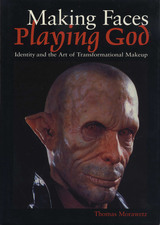 Making Faces, Playing God: Identity and the Art of Transformational Makeup
By Thomas Morawetz
University of Texas Press, 2001 Wearing a mask—putting on another face—embodies a fundamental human fantasy of inhabiting other bodies and experiencing other lives. In this extensively illustrated book, Thomas Morawetz explores how the creation of transformational makeup for theatre, movies, and television fulfills this fantasy of self-transformation and satisfies the human desire to become "the other." Morawetz begins by discussing the cultural role of fantasies of transformation and what these fantasies reveal about questions of personal identity. He next turns to professional makeup artists and describes their background, training, careers, and especially the techniques they use to create their art. Then, with numerous before-during-and-after photos of transformational makeups from popular and little-known shows and movies, ads, and artist's demos and portfolios, he reveals the art and imagination that go into six kinds of mask-making—representing demons, depicting aliens, inventing disguises, transforming actors into different (older, heavier, disfigured) versions of themselves, and creating historical or mythological characters.
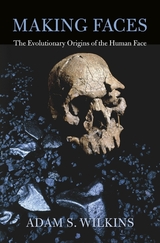 Making Faces: The Evolutionary Origins of the Human Face
Adam S. Wilkins
Harvard University Press, 2017 Humans possess the most expressive faces in the animal kingdom. Adam Wilkins presents evidence ranging from the fossil record to recent findings of genetics, molecular biology, and developmental biology to reconstruct the fascinating story of how the human face evolved. Beginning with the first vertebrate faces half a billion years ago and continuing to dramatic changes among our recent human ancestors, Making Faces illuminates how the unusual characteristics of the human face came about—both the physical shape of facial features and the critical role facial expression plays in human society.
Offering more than an account of morphological changes over time and space, which rely on findings from paleontology and anthropology, Wilkins also draws on comparative studies of living nonhuman species. He examines the genetic foundations of the remarkable diversity in human faces, and also shows how the evolution of the face was intimately connected to the evolution of the brain. Brain structures capable of recognizing different individuals as well as “reading” and reacting to their facial expressions led to complex social exchanges. Furthermore, the neural and muscular mechanisms that created facial expressions also allowed the development of speech, which is unique to humans.
In demonstrating how the physical evolution of the human face has been inextricably intertwined with our species’ growing social complexity, Wilkins argues that it was both the product and enabler of human sociality.
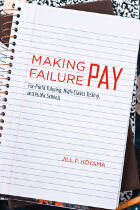 Making Failure Pay: For-Profit Tutoring, High-Stakes Testing, and Public Schools
Jill P. Koyama
University of Chicago Press, 2010 A little-discussed aspect of the No Child Left Behind Act (NCLB) is a mandate that requires failing schools to hire after-school tutoring companies—the largest of which are private, for-profit corporations—and to pay them with federal funds. Making Failure Pay takes a hard look at the implications of this new blurring of the boundaries between government, schools, and commerce in New York City, the country’s largest school district.
As Jill P. Koyama explains in this revelatory book, NCLB—a federally legislated, state-regulated, district-administered, and school-applied policy—explicitly legitimizes giving private organizations significant roles in public education. Based on her three years of ethnographic fieldwork, Koyama finds that the results are political, problematic, and highly profitable. Bringing to light these unproven, unregulated private companies’ almost invisible partnership with the government, Making Failure Pay lays bare the unintended consequences of federal efforts to eliminate school failure—not the least of which is more failure.
 Making Fathers Pay: The Enforcement of Child Support
David L. Chambers
University of Chicago Press, 1979 A couple with children divorce. A court orders the father to pay child support, but the father fails to pay. This pattern repeats itself thousands of times every year in nearly every American state.
Making Fathers Pay is David L. Chambers's study of the child-support collection process in Michigan, the state most successful in inducing fathers to pay. He begins by reporting the perilous financial problems of divorced mothers with children, problems faced even by mothers who work full time and receive child support. The study then examines the characteristics of fathers who do and do not pay support and the characteristics of collections systems that work.
Chambers's findings are based largely on records of fathers' support payments in twenty-eight Michigan counties, some of which jail hundreds of men for nonpayment every year. Chambers finds that in places well organized to collect support, jailing nonpayers seems to produce higher payments from men jailed and from men not jailed, but only at a high social cost. He also raises grave doubts about the fairness of the judicial process that leads to jail. While Chambers's total sample includes 12,000 men, he interweaves through his text moving interviews with members of one family caught in the painful predicaments that men, women, and children face upon separation.
To increase support for children at lower social costs, Chambers advocates a national system of compulsory deductions from the wages of non-custodial parents who earn more than enough for their own subsistence.
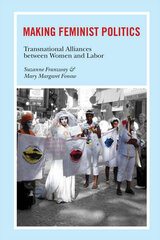 Making Feminist Politics: Transnational Alliances between Women and Labor
Suzanne Franzway and Mary Margaret Fonow
University of Illinois Press, 2011 In this timely and detailed examination of the intersections of feminism, labor politics, and global studies, Suzanne Franzway and Mary Margaret Fonow reveal the ways in which women across the world are transforming labor unions in the contemporary era. Situating specific case studies within broad feminist topics, Franzway and Fonow concentrate on union feminists mobilizing at multiple sites, issues of wages and equity, child care campaigns, work-life balance, and queer organizing, demonstrating how unions around the world are broadening their focuses from contractual details to empowerment and family and feminist issues. By connecting the diversity of women's experiences around the world both inside and outside the home and highlighting the innovative ways women workers attain their common goals, Making Feminist Politics lays the groundwork for recognition of the total individual in the future of feminist politics within global union movements.
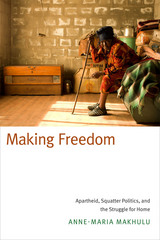 Making Freedom: Apartheid, Squatter Politics, and the Struggle for Home
Anne-Maria Makhulu
Duke University Press, 2015 In Making Freedom Anne-Maria Makhulu explores practices of squatting and illegal settlement on the outskirts of Cape Town during and immediately following the end of apartheid. Apartheid's paradoxical policies of prohibiting migrant Africans who worked in Cape Town from living permanently within the city led some black families to seek safe haven on the city's perimeters. Beginning in the 1970s families set up makeshift tents and shacks and built whole communities, defying the state through what Makhulu calls a "politics of presence." In the simple act of building homes, squatters, who Makhulu characterizes as urban militants, actively engaged in a politics of "the right to the city" that became vital in the broader struggles for liberation. Despite apartheid's end in 1994, Cape Town’s settlements have expanded, as new forms of dispossession associated with South African neoliberalism perpetuate relations of spatial exclusion, poverty, and racism. As Makhulu demonstrates, the efforts of black Capetonians to establish claims to a place in the city not only decisively reshaped Cape Town's geography but changed the course of history.
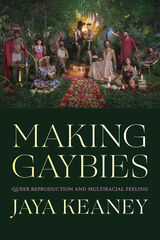 Making Gaybies: Queer Reproduction and Multiracial Feeling
Jaya Keaney
Duke University Press, 2023 In Making Gaybies Jaya Keaney explores queer family making as a site of racialized intimacy. Drawing on interviews with queer families in Australia, Keaney traces the lived experiences of choice and constraint as these families seek to craft likeness with their future children and tell stories of chosen family made through love. Queer family building often involves multiracial and multicultural encounters, as intending parents take part in the global fertility industry. Keaney follows queer family making through reproductive technologies and highlights the confines of varied transnational reproductive markets and policies as well as changing formations of race, gender, sexuality, and kinship. Whether sharing the story of white gay men choosing Indian and Thai egg donors to make their surrogate-born children’s ethnicities visually distinct from their own or that of an Aboriginal lesbian and her white partner choosing a Cherokee donor from the United States to articulate a global Indigeneity, Keaney foregrounds the entwinement of reproduction, race, and affect. By focusing on queer family making, Keaney demonstrates how reproduction fosters a queer multiracial imaginary of kinship.
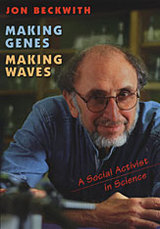 Making Genes, Making Waves: A Social Activist in Science
Jon Beckwith
Harvard University Press, 2002 In 1969, Jon Beckwith and his colleagues succeeded in isolating a gene from the chromosome of a living organism. Announcing this startling achievement at a press conference, Beckwith took the opportunity to issue a public warning about the dangers of genetic engineering. Jon Beckwith's book, the story of a scientific life on the front line, traces one remarkable man's dual commitment to scientific research and social responsibility over the course of a career spanning most of the postwar history of genetics and molecular biology.
A thoroughly engrossing memoir that recounts Beckwith's halting steps toward scientific triumphs--among them, the discovery of the genetic element that turns genes on--as well as his emergence as a world-class political activist, Making Genes, Making Waves is also a compelling history of the major controversies in genetics over the last thirty years. Presenting the science in easily understandable terms, Beckwith describes the dramatic changes that transformed biology between the late 1950s and our day, the growth of the radical science movement in the 1970s, and the personalities involved throughout. He brings to light the differing styles of scientists as well as the different ways in which science is presented within the scientific community and to the public at large. Ranging from the travails of Robert Oppenheimer and the atomic bomb to the Human Genome Project and recent "Science Wars," Beckwith's book provides a sweeping view of science and its social context in the latter half of the twentieth century.
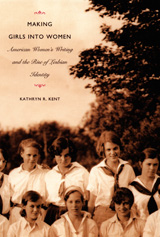 Making Girls into Women: American Women's Writing and the Rise of Lesbian Identity
Kathryn R. Kent
Duke University Press, 2003 Making Girls into Women offers an account of the historical emergence of "the lesbian" by looking at late-nineteenth- and early-twentieth-century women's writing. Kathryn R. Kent proposes that modern lesbian identity in the United States has its roots not just, or even primarily, in sexology and medical literature, but in white, middle-class women’s culture. Kent demonstrates how, as white women's culture shifted more and more from the home to the school, workplace, and boarding house, the boundaries between the public and private spheres began to dissolve. She shows how, within such spaces, women's culture, in attempting to mold girls into proper female citizens, ended up inciting in them other, less normative, desires and identifications, including ones Kent calls "protolesbian" or queer. Kent not only analyzes how texts represent queer erotics, but also theorizes how texts might produce them in readers. She describes the ways postbellum sentimental literature such as that written by Harriet Beecher Stowe, Louisa May Alcott, and Emma D. Kelley eroticizes, reacts against, and even, in its own efforts to shape girls’ selves, contributes to the production of queer female identifications and identities. Tracing how these identifications are engaged and critiqued in the early twentieth century, she considers works by Djuna Barnes, Gertrude Stein, Marianne Moore, and Elizabeth Bishop, as well as in the queer subject-forming effects of another modern invention, the Girl Scouts. Making Girls into Women ultimately reveals that modern lesbian identity marks an extension of, rather than a break from, nineteenth-century women’s culture.
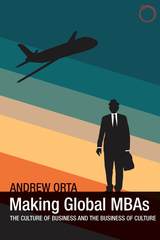 Making Global MBAs: The Culture of Business and the Business of Culture
Andrew Orta
HAU, 2018 A generation of aspiring business managers has been taught to see a world of difference as a world of opportunity. In Making Global MBAs, Andrew Orta provocatively examines the culture of contemporary business education, and the ways MBA programs participate in the production of the worldview of global capitalism through the production of the business subjects who will be managing it.
Based upon extensive field research at a set of leading US business schools, this groundbreaking ethnography shows how the culture of MBA training provides a window onto contemporary understandings of capitalism in the context of globalization. Orta details the rituals of MBA life and the ways MBA curricula cultivate at once habits of fast-paced technical competence and “softer” qualities and talents thought to be essential to unlocking the value of international cultural difference, while managing its risks. Making Global MBAs is an essential guide for prospective managers, for practitioners working internationally, and for students of globalization and of the contemporary business and politics of cultural differences.
 Making Good: How Young People Cope with Moral Dilemmas at Work
Wendy Fischman, Becca Solomon, Deborah Schutte, and Howard Gardner
Harvard University Press, 2005 You're young, ambitious, entering the field of your dreams; you're on your own, the competition is fierce--and then you see your chance: the big story, the big role, the big discovery. But you'll have to cut a few corners, bend the rules, cheat a bit. What choices will you make?
After studying more than a hundred young people launching their careers, these longtime researchers of "good work"--work that is both skillful and honorable--find unsettling answers. Although young workers know what it takes to do good work, they don't always feel they can follow the ethical route. "Later, when I'm successful," is their implicit promise.
Making Good explores the choices confronting young workers who join the ranks of three dynamic professions--journalism, science, and acting--and looks at how the novices navigate moral dilemmas posed by a demanding, frequently lonely, professional life. The authors also uncover striking comparisons between these young professionals and the veterans in their fields--most notably, older workers recall inspiring models and mentors, while today's beginners see themselves as on their own. With extensive insights into how young workers view their respective domains, the nature of their ambitions, the sacrifices they are willing to make, and the lines they are prepared to cross, this study will prove instructive to young employees and employers alike, as well as to those who wish to understand the shifting moral and social character of the working world.
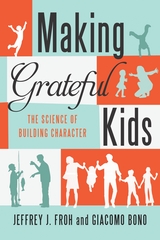 Making Grateful Kids: The Science of Building Character
Jeffrey Froh
Templeton Press, 2014 If there was a new wonder drug on the market that got kids to behave better, improve their grades, feel happier, and avoid risky behaviors, many parents around the world would be willing to empty their bank accounts to acquire it. Amazingly, such a product actually does exist. It’s not regulated by the FDA, it has no ill side-effects, and it’s absolutely free and available to anyone at any time. This miracle cure is gratitude. Over the past decade, science has shown that gratitude is one of the most valuable and important emotions we possess, and it is a virtue that anyone can cultivate. In fact, researchers have developed many different methods people can use to foster an attitude of gratitude, and the science shows that many of them really work. In Making Grateful Kids, two of the leading authorities on gratitude among young people, Jeffrey J. Froh and Giacomo Bono, introduce their latest and most compelling research, announce groundbreaking findings, and share real-life stories from adults and youth to show parents, teachers, mentors, and kids themselves how to achieve greater life satisfaction through gratitude. Most importantly perhaps, they expand on this groundbreaking research to offer practical and effective common-sense plans that can be used in day-to-day interactions between kids and adults to enhance success and wellbeing. Their unique, scientifically-based approach for producing grateful youth works whether these kids are very young elementary school students or troubled teenagers. Not only does the purposeful practice of gratitude increase their happiness, but the research indicates that grateful kids also report more self-discipline, fulfilling relationships, and engagement with their schools and communities when compared to their less grateful counterparts. After reading Making Grateful Kids, parents, teachers, and anyone who works with youth will be able to connect more meaningfully with kids so that all parties can focus on the things that matter most and, in turn, create a more cooperative and thriving society.
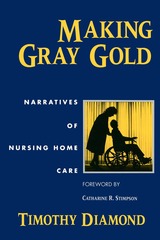 Making Gray Gold: Narratives of Nursing Home Care
Timothy Diamond
University of Chicago Press, 1992 This first hand report on the work of nurses and other caregivers in a nursing home is set powerfully in the context of wider political, economic, and cultural forces that shape and constrain the quality of care for America's elderly. Diamond demonstrates in a compelling way the price that business-as-usual policies extract from the elderly as well as those whose work it is to care for them.
In a society in which some two million people live in 16,000 nursing homes, with their numbers escalating daily, this thought-provoking work demands immediate and widespread attention.
"[An] unnerving portrait of what it's like to work and live in a nursing home. . . . By giving voice to so many unheard residents and workers Diamond has performed an important service for us all."—Diane Cole, New York Newsday
"With Making Gray Gold, Timothy Diamond describes the commodification of long-term care in the most vivid representation in a decade of round-the-clock institutional life. . . . A personal addition to the troublingly impersonal national debate over healthcare reform."—Madonna Harrington Meyer, Contemporary Sociology
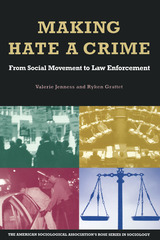 Making Hate A Crime: From Social Movement to Law Enforcement
Valerie Jenness
Russell Sage Foundation, 2001 Violence motivated by racism, anti-Semitism, misogyny, and homophobia weaves a tragic pattern throughout American history. Fueled by recent high-profile cases, hate crimes have achieved an unprecedented visibility. Only in the past twenty years, however, has this kind of violence—itself as old as humankind—been specifically categorized and labeled as hate crime. Making Hate a Crime is the first book to trace the emergence and development of hate crime as a concept, illustrating how it has become institutionalized as a social fact and analyzing its policy implications. In Making Hate a Crime Valerie Jenness and Ryken Grattet show how the concept of hate crime emerged and evolved over time, as it traversed the arenas of American politics, legislatures, courts, and law enforcement. In the process, violence against people of color, immigrants, Jews, gays and lesbians, women, and persons with disabilities has come to be understood as hate crime, while violence against other vulnerable victims-octogenarians, union members, the elderly, and police officers, for example-has not. The authors reveal the crucial role social movements played in the early formulation of hate crime policy, as well as the way state and federal politicians defined the content of hate crime statutes, how judges determined the constitutional validity of those statutes, and how law enforcement has begun to distinguish between hate crime and other crime. Hate crime took on different meanings as it moved from social movement concept to law enforcement practice. As a result, it not only acquired a deeper jurisprudential foundation but its scope of application has been restricted in some ways and broadened in others. Making Hate a Crime reveals how our current understanding of hate crime is a mix of political and legal interpretations at work in the American policymaking process. Jenness and Grattet provide an insightful examination of the birth of a new category in criminal justice: hate crime. Their findings have implications for emerging social problems such as school violence, television-induced violence, elder-abuse, as well as older ones like drunk driving, stalking, and sexual harassment. Making Hate a Crime presents a fresh perspective on how social problems and the policies devised in response develop over time. A Volume in the American Sociological Association's Rose Series in Sociology
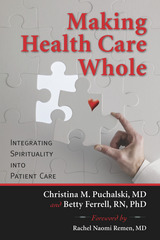 Making Health Care Whole: Integrating Spirituality into Patient Care
Christina Puchalski
Templeton Press, 2021 In the last fifteen years, the field of palliative care has experienced a surge in interest in spirituality as an important aspect of caring for seriously ill and dying patients. While spirituality has been generally recognized as an essential dimension of palliative care, uniformity of spiritual care practice has been lacking across health care settings due to factors like varying understandings and definitions of spirituality, lack of resources and practical tools, and limited professional education and training in spiritual care. In order to address these shortcomings, more than forty spiritual and palliative care experts gathered for a national conference to discuss guidelines for incorporating spirituality into palliative care. Their consensus findings form the basis of Making Health Care Whole. This important new resource provides much-needed definitions and charts a common language for addressing spiritual care across the disciplines of medicine, nursing, social work, chaplaincy, psychology, and other groups. It presents models of spiritual care that are broad and inclusive, and provides tools for screening, assessment, care planning, and interventions. This book also advocates a team approach to spiritual care, and specifies the roles of each professional on the team. Serving as both a scholarly review of the field as well as a practical resource with specific recommendations to improve spiritual care in clinical practice, Making Health Care Whole will benefit hospices and palliative care programs in hospitals, home care services, and long-term care services. It will also be a valuable addition to the curriculum at seminaries, schools of theology, and medical and nursing schools.
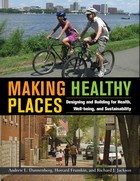 Making Healthy Places: Designing and Building for Health, Well-being, and Sustainability
Edited by Andrew L. Dannenberg, Howard Frumkin, and Richard J. Jackson
Island Press, 2011 The environment that we construct affects both humans and our natural world in myriad ways. There is a pressing need to create healthy places and to reduce the health threats inherent in places already built. However, there has been little awareness of the adverse effects of what we have constructed-or the positive benefits of well designed built environments.
This book provides a far-reaching follow-up to the pathbreaking Urban Sprawl and Public Health, published in 2004. That book sparked a range of inquiries into the connections between constructed environments, particularly cities and suburbs, and the health of residents, especially humans. Since then, numerous studies have extended and refined the book's research and reporting. Making Healthy Places offers a fresh and comprehensive look at this vital subject today.
There is no other book with the depth, breadth, vision, and accessibility that this book offers. In addition to being of particular interest to undergraduate and graduate students in public health and urban planning, it will be essential reading for public health officials, planners, architects, landscape architects, environmentalists, and all those who care about the design of their communities.
Like a well-trained doctor, Making Healthy Places presents a diagnosis of--and offers treatment for--problems related to the built environment. Drawing on the latest scientific evidence, with contributions from experts in a range of fields, it imparts a wealth of practical information, with an emphasis on demonstrated and promising solutions to commonly occurring problems.
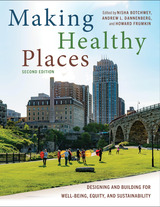 Making Healthy Places, Second Edition: Designing and Building for Well-Being, Equity, and Sustainability
Edited by Nisha Botchwey, Andrew L. Dannenberg, and Howard Frumkin
Island Press, 2022 The first edition of Making Healthy Places offered a visionary and thoroughly researched treatment of the connections between constructed environments and human health. Since its publication over 10 years ago, the field of healthy community design has evolved significantly to address major societal problems, including health disparities, obesity, and climate change. Most recently, the COVID-19 pandemic has upended how we live, work, learn, play, and travel.
In Making Healthy Places, Second Edition: Designing and Building for Well-Being, Equity, and Sustainability, planning and public health experts Nisha D. Botchwey, Andrew L. Dannenberg, and Howard Frumkin bring together scholars and practitioners from across the globe in fields ranging from public health, planning, and urban design, to sustainability, social work, and public policy. This updated and expanded edition explains how to design and build places that are beneficial to the physical, mental, and emotional health of humans, while also considering the health of the planet.
This edition expands the treatment of some topics that received less attention a decade ago, such as the relationship of the built environment to equity and health disparities, climate change, resilience, new technology developments, and the evolving impacts of the COVID-19 pandemic.
Drawing on the latest research, Making Healthy Places, Second Edition imparts a wealth of practical information on the role of the built environment in advancing major societal goals, such as health and well-being, equity, sustainability, and resilience.
This update of a classic is a must-read for students and practicing professionals in public health, planning, architecture, civil engineering, transportation, and related fields.
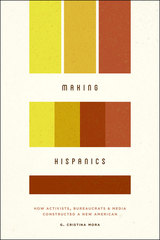 Making Hispanics: How Activists, Bureaucrats, and Media Constructed a New American
G. Cristina Mora
University of Chicago Press, 2014 How did Puerto Ricans, Mexicans, and Cubans become known as “Hispanics” and “Latinos” in the United States? How did several distinct cultures and nationalities become portrayed as one? Cristina Mora answers both these questions and details the scope of this phenomenon in Making Hispanics. She uses an organizational lens and traces how activists, bureaucrats, and media executives in the 1970s and '80s created a new identity category—and by doing so, permanently changed the racial and political landscape of the nation.
Some argue that these cultures are fundamentally similar and that the Spanish language is a natural basis for a unified Hispanic identity. But Mora shows very clearly that the idea of ethnic grouping was historically constructed and institutionalized in the United States. During the 1960 census, reports classified Latin American immigrants as “white,” grouping them with European Americans. Not only was this decision controversial, but also Latino activists claimed that this classification hindered their ability to portray their constituents as underrepresented minorities. Therefore, they called for a separate classification: Hispanic. Once these populations could be quantified, businesses saw opportunities and the media responded. Spanish-language television began to expand its reach to serve the now large, and newly unified, Hispanic community with news and entertainment programming. Through archival research, oral histories, and interviews, Mora reveals the broad, national-level process that led to the emergence of Hispanicity in America.
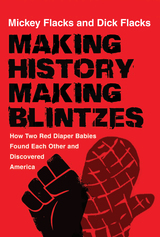 Making History / Making Blintzes: How Two Red Diaper Babies Found Each Other and Discovered America
Flacks, Mickey
Rutgers University Press, 2018 Making History/Making Blintzes is a chronicle of the political and personal lives of progressive activists Richard (Dick) and Miriam (Mickey) Flacks, two of the founders of Students for a Democratic Society (SDS). As active members of the Civil Rights movement and the anti-Vietnam War movement in the 1960s, and leaders in today’s social movements, their stories are a first-hand account of progressive American activism from the 1960s to the present.
Throughout this memoir, the couple demonstrates that their lifelong commitment to making history through social activism cannot be understood without returning to the deeply personal context of their family history—of growing up “Red Diaper babies” in 1950s New York City, using folk music as self-expression as adolescents in the 1960s, and of making blintzes for their own family through the 1970s and 1980s. As the children of immigrants and first generation Jews, Dick and Mickey crafted their own religious identity as secular Jews, created a critical space for American progressive activism through SDS, and ultimately, found themselves raising an “American” family.
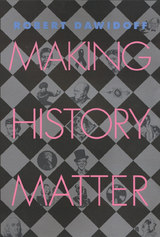 Making History Matter
Robert Dawidoff
Temple University Press, 2000 This collection of Robert Dawidoff's essays and journalism is peopled by the likes of the Founding Fathers, Fred Astaire, Henry and William James, Sophie Tucker, Trent Lott, and Cole Porter. Drawing together this unlikely cast of characters, Dawidoff probes into the role of outsider groups as well as intellectual and political elites in the formation of American culture.
As a scholar of intellectual and cultural history, Dawidoff takes the stance that historians ought to take an active role in our democratic culture, informing and participating in public discourse. He argues for a broad reach when it comes to cultural expression, resisting the polarization of formal intellectual history and folk or commercial popular culture. In his view, Ralph Waldo Emerson and Katherine Hepburn are equally worthy topics for a historian's consideration, provided that they are treated with equal seriousness of purpose and analytic rigor. In "The Gay Nineties" section that closes the book, he traces key events in the continual struggle for gay and lesbian civil rights and takes on such unresolved issues as safer sex, needle exchange programs to control HIV transmission, and the public controversy around the portrayal of gay and lesbian television characters.
Divided into sections that deal with the patriarchs of American political and intellectual culture, expressive culture, and a historian's public voice, this book is a model of engaged and engaging writing. Accessible and witty, Making History Matter will appeal to general and academic readers interested in American history as well as gay and lesbian political and cultural issues.
 Making History Matter: Kuroita Katsumi and the Construction of Imperial Japan
Lisa Yoshikawa
Harvard University Press, 2017 Making History Matter explores the role history and historians played in imperial Japan’s nation and empire building from the 1890s to the 1930s. As ideological architects of this process, leading historians wrote and rewrote narratives that justified the expanding realm. Learning from their Prussian counterparts, they highlighted their empiricist methodology and their scholarly standpoint, to authenticate their perspective and to distinguish themselves from competing discourses. Simultaneously, historians affirmed imperial myths that helped bolster statist authoritarianism domestically and aggressive expansionism abroad. In so doing, they aligned politically with illiberal national leaders who provided funding and other support necessary to nurture the modern discipline of history. By the 1930s, the field was thriving and historians were crucial actors in nationwide commemorations and historical enterprises.
Through a close reading of vast, multilingual sources, with a focus on Kuroita Katsumi, Yoshikawa argues that scholarship and politics were inseparable as Japan’s historical profession developed. In the process of making history matter, historians constructed a national past to counter growing interwar liberalism. This outlook—which continues as the historical perspective that the Liberal Democratic Party leadership embraces—ultimately justified the Japanese aggressions during the Asia-Pacific Wars.
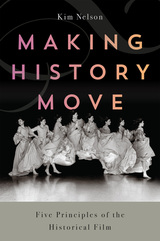 Making History Move: Five Principles of the Historical Film
Kim Nelson
Rutgers University Press, 2024 Making History Move: Five Principles of the Historical Film builds upon decades of scholarship investigating history in visual culture by proposing a methodology of five principles to analyze history in moving images in the digital age. It charts a path to understanding the form of history with the most significant impact on public perceptions of the past. The book develops insights across these fields, including philosophical considerations of film and history, to clarify the form and function of history in moving images. It addresses the implications of the historical film on public historical consciousness, presenting criteria to engage and assess the truth status of depictions of the past. Each chapter offers a detailed aspect of this methodology for analyzing history in moving images. Together, they propose five principles to organize past and future scholarship in this vital, interdisciplinary field of study.
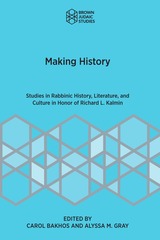 Making History: Studies in Rabbinic History, Literature, and Culture in Honor of Richard L. Kalmin
Carol Bakhos
SBL Press, 2024 Essays in this volume honor Richard L. Kalmin, one of the leading scholars of rabbinic literature. Volume contributors explore a variety of topics related to Kalmin’s wide-ranging work from the development of the Talmud to rabbinic storytelling, from the transmission of tales across geographic and cultural boundaries to ancient Jewish and Iranian interactions. Many of the essays reflect current trends in how scholars use ancient Jewish literary sources to address questions of historical import. Contributors include Carol Bakhos, Beth A. Berkowitz, Noah Bickart, Robert Brody, Joshua Cahan, Shaye J. D. Cohen, Steven D. Fraade, Shamma Friedman, Alyssa M. Gray, Judith Hauptman, Christine Hayes, Catherine Hezser, Marc Hirshman, David Kraemer, Marjorie Lehman, Kristen Lindbeck, Jonathan S. Milgram, Chaim Milikowsky, Michael L. Satlow, Marcus Mordecai Schwartz, Seth Schwartz, Burton L. Visotzky, and Sarah Wolf.
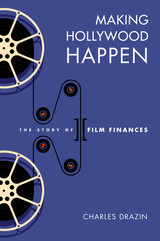 Making Hollywood Happen: Seventy Years of Film Finances
Charles Drazin
University of Wisconsin Press, 2022 Filmmaking is a business—someone has to pay the bills. For much of the industry’s history, that role was shouldered by the studios. The rise of independent filmmakers then led to the rise of independent financiers. But what happens if bad weather closes down a production or a director’s vision pays no heed to the limitations of time and money?
Enter Film Finances. The company was founded in London in 1950 to insure against the risk that a film would exceed its original budget or not be completed on time. Its pioneering development of the “completion guarantee”—the financial instrument that provides the essential security for investors to support independent filmmaking—ultimately led to the creation of many thousands of films, including some of the most celebrated ever made: Moulin Rouge (1953), Dr. No (1962), The Outsiders (1982), Pulp Fiction (1994), Slumdog Millionaire (2008), La La Land (2016), and more.
Film Finances’s role in filmmaking was little known outside the industry until 2012, when it opened its historical archive to scholars. Drawing on these previously private documents as well as interviews with its executives, Making Hollywood Happen tells the company’s story through seven decades of postwar cinema history and chronicles the growth of the international independent film industry. Focusing on a business that has operated at the meeting point between money and art for more than seventy years, this lavishly illustrated book goes to the heart of how the movie business works.
 Making Home in Havana
Pietropaolo, Vincenzo
Rutgers University Press, 2002 Havana is a city that rarely fails to captivate. But much of the unique beauty and culture of this historic city is rapidly disappearing. As Cuban society finds itself at a crossroads, Havana is more than ever a city on the edge, for although frozen in time as a consequence of Fidel Castro’s revolution, it has certainly not been well preserved. Time, climate, and neglect have eroded a rare architectural legacy, making the need to document this heritage even more pressing than ever before. Making Home in Havana is an elegant book of photographs and testimonies, recording, questioning, and evoking the meaning of place — in particular, the meaning of home. The combination of fine photography and the words of residents of former palaces, humble apartments, and other dwellings offer us an irresistible portrait of Havana that might otherwise be lost forever. Vincenzo Pietropaolo and Cecelia Lawless have made numerous visits to Havana in order to fully understand and convey the essence of what home means to the inhabitants of the dwellings of the El Vedado and Centro Habana neighborhoods. Together, they—and we—explore how a building becomes a home through its human history as well as its architectural features. With some renovation already underway in colonial Havana, they concentrate on largely unexplored and unrecognized sections that continue to fall into ruin. The intimacy of their connection with the buildings and people offers us a rare combination of documentary realism and high art. Buildings and people speak their histories to us in classic humanistic style. Residents of Havana tell their stories of lifelong efforts to turn decay into beauty, while the photographer’s evocative pictures enable us to feel exactly what they are talking about — a creation of time and space called home.
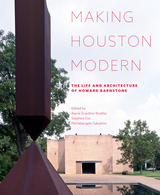 Making Houston Modern: The Life and Architecture of Howard Barnstone
By Barrie Scardino Bradley, Stephen Fox, and Michelangelo Sabatino
University of Texas Press, 2020 Complex, controversial, and prolific, Howard Barnstone was a central figure in the world of twentieth-century modern architecture. Recognized as Houston’s foremost modern architect in the 1950s, Barnstone came to prominence for his designs with partner Preston M. Bolton, which transposed the rigorous and austere architectural practices of Ludwig Mies van der Rohe to the hot, steamy coastal plain of Texas. Barnstone was a man of contradictions—charming and witty but also self-centered, caustic, and abusive—who shaped new settings that were imbued, at once, with spatial calm and emotional intensity. Making Houston Modern explores the provocative architect’s life and work, not only through the lens of his architectural practice but also by delving into his personal life, class identity, and connections to the artists, critics, collectors, and museum directors who forged Houston’s distinctive culture in the postwar era. Edited by three renowned voices in the architecture world, this volume situates Barnstone within the contexts of American architecture, modernism, and Jewish culture to unravel the legacy of a charismatic personality whose imaginative work as an architect, author, teacher, and civic commentator helped redefine architecture in Texas.
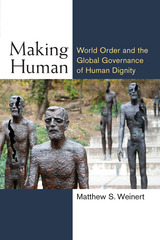 Making Human: World Order and the Global Governance of Human Dignity
Matthew S. Weinert
University of Michigan Press, 2015 Differences between human beings have long been used to justify a range of degrading, exclusionary, and murderous practices that strip people of their humanity and dignity. While considerable scholarship has been devoted to such dehumanization, Matthew S. Weinert asks how we might conceive its reverse—humanization, or what it means to “make human.” Weinert proposes an account of making human centered on five mechanisms: reflection, recognition, resistance, replication of dominant mores, and responsibility. Examining cases such as the UN Security Council’s engagements with crises and the International Court of Justice’s grappling with Kosovo’s unilateral declaration of independence, he illustrates the distinct and contingent ways these mechanisms have been deployed. Theoretically, the cases evince a complex, evolving relationship between state-centric and human-centric views of society, ultimately revealing the normative potentialities of both. Though the case studies concern specific human relations issues on an international level, Weinert argues in favor of starting from the shared problem of being human and of living in a world in which the humanity of countless groups has been demeaned or denied. Working outward from that point, he proposes, we obtain a more pragmatically grounded understanding of the social construction of the human being.
 Making Dead Birds: Chronicle of a Film
Robert Gardner
Harvard University Press, 2007 Robert Gardner’s classic Dead Birds is one of the most highly acclaimed and controversial documentary films ever made. This detailed and candid account of the process of making Dead Birds, from the birth of the idea through filming in New Guinea to editing and releasing the finished film, is more than the chronicle of a single work. It is also a thoughtful examination of what it meant to record the moving and violent rituals of warrior-farmers in the New Guinea highlands and to present to the world a graphic story of their behavior as a window onto our own. Letters, journals, telegrams, newspaper clippings, and over 50 images are assembled to recreate a vivid chronology of events. Making Dead Birds not only addresses the art and practice of filmmaking, but also explores issues of representation and the discovery of meaning in human lives.
Gardner led a remarkable cast of participants on the 1961 expedition. All brought back extraordinary bodies of work. Probably most influential of all was Dead Birds, which marked a sea change in nonfiction filmmaking. This book takes the reader inside the creative process of making that landmark film and offers a revealing look into the heart and mind of one of the great filmmakers of our time.
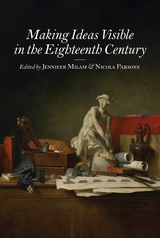 Making Ideas Visible in the Eighteenth Century
Jennifer Milam
University of Delaware Press, 2022 This volume considers how ideas were made visible through the making of art and visual experience occasioned by reception during the long eighteenth century. The event that gave rise to the collection was the 15th David Nichol Smith Seminar in Eighteenth-Century Studies, which launched a new Australian and New Zealand Society of Eighteenth-Century Studies. Two strands of interest are explored by the individual authors. The first four essays work with ideas about material objects and identity formation, suggesting how the artist's physical environment contributes to the sense of self, as a practicing artist or artisan, as an individual patron or collector, or as a woman or religious outsider. The last four essays address the intellectual work that can be expressed through or performed by objects. Through a consideration of the material formation of concepts, this book explores questions that are implicated by the need to see ideas in painted, sculpted, illustrated, and designed forms. In doing so, it introduces new visual materials and novel conceptual models into traditional accounts of the intellectual history of the Enlightenment.
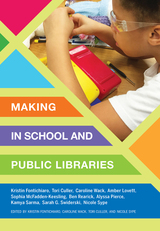 Making in School and Public Libraries
Edited by Kristin Fontichiaro, Caroline Wack, Tori Culler, and Nicole Sype
Michigan Publishing, 2020 Whether you are just beginning your library’s maker efforts or are recalibrating a few years into your work, Making in School and Public Libraries is designed to help you grow your makerspace in a way that is engaging, affordable, and sustainable. Building on eight years of makerspace activities in the Michigan Makers and Making in Michigan Libraries project, the authors share their experiences creating or co-creating makerspace spaces and activities with for a wide band of interests, materials, tools, age groups, communities, budgets, and needs. Readers will gain practical insights about how to - Define goals and target audiences
- Customize programs to meet community needs
- Equip a makerspace
- Document activities
- Assess achievements and areas for growth
- Engage makers in a variety of technology and hands-on activities, including robots, 3D printing, sewing, cardboard challenges, knitting and crochet, design thinking, and zines
The authors’ experiences include co-creating one of the nation’s first school library makerspaces; establishing after-school maker programs with elementary and middle school learners; co-designing one-off and ongoing maker events for community-building in diverse public libraries; engaging with senior citizens in a low-income Senior Summer Camp pilot; and state, national, and international workshops for teachers, librarians, and youth mentors.
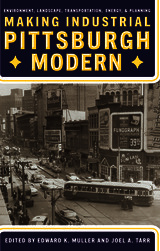 Making Industrial Pittsburgh Modern: Environment, Landscape, Transportation, and Planning
Joel Tarr and Edward Muller
University of Pittsburgh Press, 2019
Pittsburgh’s explosive industrial and population growth between the mid-nineteenth century and the Great Depression required constant attention to city-building. Private, profit-oriented firms, often with government involvement, provided necessary transportation, energy resources, and suitable industrial and residential sites. Meeting these requirements in the region’s challenging hilly topographical and riverine environment resulted in the dramatic reshaping of the natural landscape. At the same time, the Pittsburgh region’s free market, private enterprise emphasis created socio-economic imbalances and badly polluted the air, water, and land. Industrial stagnation, temporarily interrupted by wars, and then followed deindustrialization inspired the formation of powerful public-private partnerships to address the region’s mounting infrastructural, economic, and social problems. The sixteen essays in Making Industrial Pittsburgh Modern examine important aspects of the modernizing efforts to make Pittsburgh and Southwestern Pennsylvania a successful metropolitan region. The city-building experiences continue to influence the region’s economic transformation, spatial structure, and life experience.
 Making Institutions Work in Peru: Democracy, Development and Inequality Since 1980
Edited by John Crabtree
University of London Press, 2006 The 2006 Peruvian elections are an appropriate moment to reflect on Alejandro Toledo's term as president and on the broader agenda for building a more inclusive and democratic government. In a country of extreme social inequality, such an aspiration represents an enormous challenge. The sudden collapse of the which Fujimori regime --which had dominated Peru for the 1990s --and Toledo's election victory in 2001 seemed to provide an opportunity for institutional reform and rebuilding. The impetus proved short-lived, as the new president's popularity sank to unprecedented levels and public support for Peru's democratic institutions continued to hemorrhage. This book suggests that the challenges of institutional development run very deep and are not peculiar to any one government. Institutional change in Peru is part of a much wider process of transformation from an oligarchic society.
Contributors include Paulo Drino (University of Manchester), Cynthia Sanborn (Centro de Investigaciones, Universidad del Pacifico, Lima), Carlos Monge (Participacion Ciudadana, Lima), Fernando Rospigliosi (Instituto de Estudios Peruanos, Lima), Pedro Franck (Departamento de Economia, Universidad Catolica, Lima), Fernando Eguren (Centro Peruano de Ciencias Sociales, Lima), Rosemary Thorp (Queen Elizabeth House/St Antony's College, Oxford), Eduardo Dargent (University of Texas,Austin), Coletta Youngers (Washington Office on Latin America,Washington D.C.), Francisco Durand (University of Texas, San Antonio), Jose Tavara (Departamento de Economia, Universidad Catolica, Lima, and OSIPTEL), and Richard Webb (Instituto Cuanto and Central Bank of Peru).
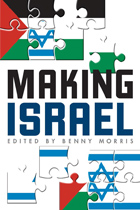 Making Israel
Benny Morris, Editor
University of Michigan Press, 2007 Benny Morris is the founding father of the New Historians, a group of Israeli scholars who have challenged long-established perceptions about the origins of the Israeli-Palestinian conflict. Their research rigorously documented crimes and atrocities committed by the Israeli armed forces, including rape, torture, and ethnic cleansing. With Making Israel, Morris brings together the first collection of translated articles on the New History by leading Zionist and revisionist Israeli historians, providing Americans with a firsthand view of this important debate and enabling a better understanding of how the New Historians have influenced Israelis' awareness of their own past. "The study of Israeli history, society, politics, and economics over the past two decades has been marked by a fierce and sometimes highly personal debate between 'traditionalists'---scholars who generally interpreted Israeli history and society within the Zionist ethos---and 'revisionists'---scholars who challenged conventional Zionist narratives of Israeli history and society. Making Israel brings together traditionalists and revisionists who openly and directly lay out their key insights about Israel's origins. It also introduces multidisciplinary perspectives on Israel by historians and sociologists, each bringing into the debate its own jargon, its own epistemology and methodology, and its own array of substantive issues. This is essential reading for anybody who wants to understand the different interpretations of Israeli society and perhaps the central debate among students of modern Israel."
---Zeev Maoz, Professor of Political Science at the University of California, Davis, and Distinguished Fellow at the Interdisciplinary Center, Herzliya "Israel's 'new historians' have done a great service to their country, and to all who care about the Arab-Israeli conflict. By challenging myths, reexamining evidence, and asking truly important questions about the past they help to confront the present with honesty and realism. This book provides a sampling of the best of what these courageous voices have to offer."
---William B. Quandt, University of Virginia Benny Morris is Professor of Middle East history at Ben-Gurion University in Beersheba, Israel, and is the author of Righteous Victims: A History of the Zionist-Arab Conflict, 1881-1999.
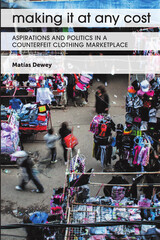 Making It at Any Cost: Aspirations and Politics in a Counterfeit Clothing Marketplace
By Matías Dewey
University of Texas Press, 2020 La Salada is South America’s largest marketplace for fraudulently labeled clothing, a sprawling and dangerous bazaar on the fringes of Buenos Aires where counterfeit goods are bought and sold, armed thieves roam the nearby streets, and corrupt police and politicians turn a blind eye to widespread unlawful behaviors. Despite conditions traditionally considered inhospitable to economic growth—including acute interpersonal distrust, pervasive personal insecurity, and rampant violence—business in La Salada is booming under an established order completely detached from the state. Matías Dewey dives deep into the world of La Salada to examine how market exchanges function outside the law and how agreements and norms develop in the economy for counterfeit clothing. Drawing on seven months of ethnographic research and more than a hundred interviews, Dewey argues that aspirations for a better future shape garment workers’ everyday practices, from their home-based sweatshops to the market stalls. The book unearths a new configuration of garment production and commercialization detached from global supply chains, submerged in the shadows of informality and illegality, and rooted in aspiration and opportunity.
 Making It Explicit: Reasoning, Representing, and Discursive Commitment
Robert B. Brandom
Harvard University Press, 1994 What would something unlike us--a chimpanzee, say, or a computer--have to be able to do to qualify as a possible knower, like us? To answer this question at the very heart of our sense of ourselves, philosophers have long focused on intentionality and have looked to language as a key to this condition. Making It Explicit is an investigation into the nature of language--the social practices that distinguish us as rational, logical creatures--that revises the very terms of this inquiry. Where accounts of the relation between language and mind have traditionally rested on the concept of representation, this book sets out an alternate approach based on inference, and on a conception of certain kinds of implicit assessment that become explicit in language. Making It Explicit is the first attempt to work out in detail a theory that renders linguistic meaning in terms of use--in short, to explain how semantic content can be conferred on expressions and attitudes that are suitably caught up in social practices.
At the center of this enterprise is a notion of discursive commitment. Being able to talk--and so in the fullest sense being able to think--is a matter of mastering the practices that govern such commitments, being able to keep track of one's own commitments and those of others. Assessing the pragmatic significance of speech acts is a matter of explaining the explicit in terms of the implicit. As he traces the inferential structure of the social practices within which things can be made conceptually explicit, the author defines the distinctively expressive role of logical vocabulary. This expressive account of language, mind, and logic is, finally, an account of who we are.
 Making it Home: Place in Canadian Literature
Deborah Keahey
University of Manitoba Press, 1998 Traditional approaches to Prairie literature have focussed on the significance of "the land" in attempts to make a place into a home. The emphasis on the importance of landscape as a defining feature ignores the important roles played by other influences brought to the land such as history, culture, gender, ethnicity, religion, community, family, and occupation. Deborah Keahey considers over 70 years of Canadian Prairie literature, including poetry, autobiography, drama, and fiction. The 17 writers range from the well-established, like Martha Ostenso and Robert Kroetsch, to newer writers, like Ian Ross and Kelly Rebar. Through their works, she asks whether the Prairies are a physical or a political creation, whether "home" is made by what you bring with you, or what you find when you arrive, and she incorporates the influences and effects far beyond landscape to understand what guides the "home-making" process of both the writers and their creations. Her study acknowledges that "home" is a complicated concept, and making a place into a home place is a complicated process. Informed by current linguistic, feminist, postcolonial, and cultural theory, Keahey explores these concepts in depth and redefines our understanding of place, home, and the relationship between them.
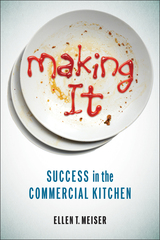 Making It: Success in the Commercial Kitchen
Ellen T. Meiser
Rutgers University Press, 2025 The restaurant industry is one of the few places in America where workers from lower-class backgrounds can rise to positions of power and prestige. Yet with over four million cooks and food-preparation workers employed in America’s restaurants, not everyone makes it to the high-status position of chef. What factors determine who rises the ranks in this fiercely competitive pressure-cooker environment?
Making It explores how the career path of restaurant workers depends on their accumulation of kitchen capital, a cultural asset based not only on their ability to cook but also on how well they can fit into the workplace culture and negotiate its hierarchical structures. After spending 120 hours working in a restaurant kitchen and interviewing fifty chefs and cooks from fine-dining establishments and greasy-spoon diners across the country, sociologist Ellen Meiser discovers many strategies for accumulating kitchen capital. For some, it involves education and the performance of expertise; others climb the ranks by controlling their own emotions or exerting control over coworkers. Making It offers a close and personal look at how knowledge, power, and interpersonal skills come together to determine who succeeds and who fails in the high-pressure world of the restaurant kitchen.
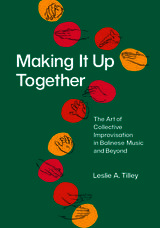 Making It Up Together: The Art of Collective Improvisation in Balinese Music and Beyond
Leslie A. Tilley
University of Chicago Press, 2019 Most studies of musical improvisation focus on individual musicians. But that is not the whole story. From jazz to flamenco, Shona mbira to Javanese gamelan, improvised practices thrive on group creativity, relying on the close interaction of multiple simultaneously improvising performers. In Making It Up Together, Leslie A. Tilley explores the practice of collective musical improvisation cross-culturally, making a case for placing collectivity at the center of improvisation discourse and advocating ethnographically informed music analysis as a powerful tool for investigating improvisational processes.
Through two contrasting Balinese case studies—of the reyong gong chime’s melodic norot practice and the interlocking drumming tradition kendang arja—Tilley proposes and tests analytical frameworks for examining collectively improvised performance. At the micro-level, Tilley’s analyses offer insight into the note-by-note decisions of improvising performers; at the macro-level, they illuminate larger musical, discursive, structural, and cultural factors shaping those decisions. This multi-tiered inquiry reveals that unpacking how performers play and imagine as a collective is crucial to understanding improvisation and demonstrates how music analysis can elucidate these complex musical and interactional relationships.
Highlighting connections with diverse genres from various music cultures, Tilley’s examinations of collective improvisation also suggest rich potential for cross-genre exploration. The surrounding discussions point to larger theories of communication and interaction, creativity and cognition that will be of interest to a range of readers—from ethnomusicologists and music theorists to cognitive psychologists, jazz studies scholars, and improvising performers. Setting new parameters for the study of improvisation, Making It Up Together opens up fresh possibilities for understanding the creative process, in music and beyond.
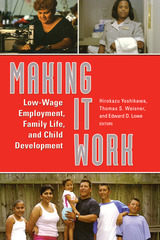 Making It Work: Low-Wage Employment, Family Life, and Child Development
Hirokazu Yoshikawa
Russell Sage Foundation, 2006 Low-skilled women in the 1990s took widely different paths in trying to support their children. Some held good jobs with growth potential, some cycled in and out of low-paying jobs, some worked part time, and others stayed out of the labor force entirely. Scholars have closely analyzed the economic consequences of these varied trajectories, but little research has focused on the consequences of a mother's career path on her children's development. Making It Work, edited by Hirokazu Yoshikawa, Thomas Weisner, and Edward Lowe, looks past the economic statistics to illustrate how different employment trajectories affect the social and emotional lives of poor women and their children. Making It Work examines Milwaukee's New Hope program, an experiment testing the effectiveness of an anti-poverty initiative that provided health and child care subsidies, wage supplements, and other services to full-time low-wage workers. Employing parent surveys, teacher reports, child assessment measures, ethnographic studies, and state administrative records, Making It Work provides a detailed picture of how a mother's work trajectory affects her, her family, and her children's school performance, social behavior, and expectations for the future. Rashmita Mistry and Edward D. Lowe find that increases in a mother's income were linked to higher school performance in her children. Without large financial worries, mothers gained extra confidence in their ability to parent, which translated into better test scores and higher teacher appraisals for their children. JoAnn Hsueh finds that the children of women with erratic work schedules and non-standard hours—conditions endemic to the low-skilled labor market—exhibited higher levels of anxiety and depression. Conversely, Noemi Enchautegui-de-Jesus, Hirokazu Yoshikawa, and Vonnie McLoyd discover that better job quality predicted lower levels of acting-out and withdrawal among children. Perhaps most surprisingly, Anna Gassman-Pines, Hirokazu Yoshikawa, and Sandra Nay note that as wages for these workers rose, so did their marriage rates, suggesting that those worried about family values should also be concerned with alleviating poverty in America. It is too simplistic to say that parental work is either "good" or "bad" for children. Making It Work gives a nuanced view of how job quality, flexibility, and wages are of the utmost importance for the well-being of low-income parents and children.
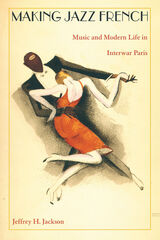 Making Jazz French: Music and Modern Life in Interwar Paris
Jeffrey H. Jackson
Duke University Press, 2003 Between the world wars, Paris welcomed not only a number of glamorous American expatriates, including Josephine Baker and F. Scott Fitzgerald, but also a dynamic musical style emerging in the United States: jazz. Roaring through cabarets, music halls, and dance clubs, the upbeat, syncopated rhythms of jazz soon added to the allure of Paris as a center of international nightlife and cutting-edge modern culture. In Making Jazz French, Jeffrey H. Jackson examines not only how and why jazz became so widely performed in Paris during the 1920s and 1930s but also why it was so controversial. Drawing on memoirs, press accounts, and cultural criticism, Jackson uses the history of jazz in Paris to illuminate the challenges confounding French national identity during the interwar years. As he explains, many French people initially regarded jazz as alien because of its associations with America and Africa. Some reveled in its explosive energy and the exoticism of its racial connotations, while others saw it as a dangerous reversal of France’s most cherished notions of "civilization." At the same time, many French musicians, though not threatened by jazz as a musical style, feared their jobs would vanish with the arrival of American performers. By the 1930s, however, a core group of French fans, critics, and musicians had incorporated jazz into the French entertainment tradition. Today it is an integral part of Parisian musical performance. In showing how jazz became French, Jackson reveals some of the ways a musical form created in the United States became an international phenomenon and acquired new meanings unique to the places where it was heard and performed.
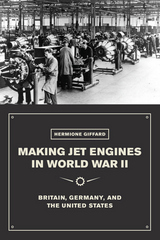 Making Jet Engines in World War II: Britain, Germany, and the United States
Hermione Giffard
University of Chicago Press, 2016 Our stories of industrial innovation tend to focus on individual initiative and breakthroughs. With Making Jet Engines in World War II, Hermione Giffard uses the case of the development of jet engines to offer a different way of understanding technological innovation, revealing the complicated mix of factors that go into any decision to pursue an innovative, and therefore risky technology.
Giffard compares the approaches of Britain, Germany, and the United States. Each approached jet engines in different ways because of its own war aims and industrial expertise. Germany, which produced more jet engines than the others, did so largely as replacements for more expensive piston engines. Britain, on the other hand, produced relatively few engines—but, by shifting emphasis to design rather than production, found itself at war's end holding an unrivaled range of designs. The US emphasis on development, meanwhile, built an institutional basis for postwar production. Taken together, Giffard's work makes a powerful case for a more nuanced understanding of technological innovation, one that takes into account the influence of the many organizational factors that play a part in the journey from idea to finished product.
 Making, Keeping, and Losing Friends: How Campuses Shape College Students' Networks
Janice M. McCabe
University of Chicago Press, 2025 Draws attention to the importance of support networks for students as they make, keep, and lose friends throughout college and beyond.
We’re all familiar with the sentiment that “college is the best time of your life.” Along with a newfound sense of freedom, students have a unique opportunity to forge lifelong friendships at a point in life when friendship is particularly important. Why is it, then, that so many college students are falling victim to what the US Surgeon General termed an “epidemic of loneliness and isolation”? How do different aspects of college life help or hinder students’ ability to form deep connections?
In Making, Keeping, and Losing Friends: How Campuses Shape College Students’ Networks, sociologist Janice M. McCabe shows that the way a college is structured—whether students live in dorms or commute, study abroad or stay close to campus, have plentiful common areas for clubs to meet or not—can either encourage or hinder the making of meaningful friendships. Based on interviews with 95 students on three distinct campuses—a small private college (Dartmouth College), a large public university (University of New Hampshire), and a non-residential community college (Manchester Community College)—McCabe captures a wide range of experiences and discovers how features of the campuses make it easier or harder for students to make and keep friends. She shows how and why, across all three institutions, some students thrive in deep and lasting friendships with their peers.
As McCabe’s research reveals, we need to look at the structures of students’ networks, the institutions they attend, and the importance of their identities in these places if we are to truly uncover and address the loneliness epidemic facing today’s young adults.
 Making Kin not Population: Reconceiving Generations
Edited by Adele Clarke and Donna Haraway
Prickly Paradigm Press, 2018 As the planet’s human numbers grow and environmental concerns proliferate, natural scientists, economists, and policy-makers are increasingly turning to new and old questions about families and kinship as matters of concern. From government programs designed to fight declining birth rates in Europe and East Asia, to controversial policies seeking to curb population growth in countries where birth rates remain high, to increasing income inequality transnationally, issues of reproduction introduce new and complicated moral and political quandaries.
Making Kin Not Population ends the silence on these issues with essays from leading anti-racist, ecologically-concerned, feminist scholars. Though not always in accord, these contributors provide bold analyses of complex issues of intimacy and kinship, from reproductive justice to environmental justice, and from human and nonhuman genocides to new practices for making families and kin. This timely work offers vital proposals for forging innovative personal and public connections in the contemporary world.
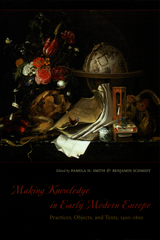 Making Knowledge in Early Modern Europe: Practices, Objects, and Texts, 1400 - 1800
Edited by Pamela H. Smith and Benjamin Schmidt
University of Chicago Press, 2008 The fruits of knowledge—such as books, data, and ideas—tend to generate far more attention than the ways in which knowledge is produced and acquired. Correcting this imbalance, Making Knowledge in Early Modern Europe brings together a wide-ranging yet tightly integrated series of essays that explore how knowledge was obtained and demonstrated in Europe during an intellectually explosive four centuries, when standard methods of inquiry took shape across several fields of intellectual pursuit.
Composed by scholars in disciplines ranging from the history of science to art history to religious studies, the pieces collected here look at the production and consumption of knowledge as a social process within many different communities. They focus, in particular, on how the methods employed by scientists and intellectuals came to interact with the practices of craftspeople and practitioners to create new ways of knowing. Examining the role of texts, reading habits, painting methods, and countless other forms of knowledge making, this volume brilliantly illuminates the myriad ways these processes affected and were affected by the period’s monumental shifts in culture and learning.
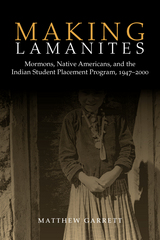 Making Lamanites: Mormons, Native Americans, and the Indian Student Placement Program, 1947-2000
Matthew Garrett
University of Utah Press, 2016 Winner of the Juanita Brooks Prize in Mormon Studies
From 1947 to 2000, some 50,000 Native American children left the reservations to live with Mormon foster families. While some dropped out of the Indian Student Placement Program (ISPP), for others the months spent living with LDS families often proved more penetrating than expected.
The ISPP emerged in the mid-twentieth century, championed by Apostle Spencer W. Kimball, aligned with the then national preferences to terminate tribal entities and assimilate indigenous people. But as the paradigm shifted to self-determination, critics labeled the program as crudely assimilationist. Some ISPP students like Navajo George P. Lee fiercely defended the LDS Church before native peers and Congress, contending that it empowered Native people and instilled the true Indian identity; meanwhile Red Power activists organized protests in Salt Lake City, denouncing LDS colonization. As a new generation of church leaders quietly undercut the Indian programs, many of its former participants felt a sense of confusion and abandonment as Mormon distinctions for Native people faded in the late twentieth century.
Making Lamanites traces this student experience within contested cultural and institutional landscapes to reveal how and why many of these Native youth adopted a new notion of Indianness.
Winner of the Francis Armstrong Madsen Best Book Award from the Utah Division of State History.
Making Lemonade out of Lemons: Mexican American Labor and Leisure in a California Town 1880-1960
José M. Alamillo
University of Illinois Press, 2006 Out of the “lemons” handed to Mexican American workers in Corona, California--low pay, segregated schooling, inadequate housing, and racial discrimination--Mexican men and women made “lemonade” by transforming leisure spaces such as baseball games, parades, festivals, and churches into politicized spaces where workers voiced their grievances, debated strategies for advancement, and built solidarity. Using oral history interviews, extensive citrus company records, and his own experiences in Corona, José Alamillo argues that Mexican Americans helped lay the groundwork for civil rights struggles and electoral campaigns in the post-World War II era.
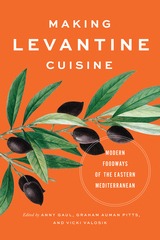 Making Levantine Cuisine: Modern Foodways of the Eastern Mediterranean
Edited by Anny Gaul, Graham Auman Pitts, and Vicki Valosik
University of Texas Press, 2021 Melding the rural and the urban with the local, regional, and global, Levantine cuisine is a mélange of ingredients, recipes, and modes of consumption rooted in the Eastern Mediterranean. Making Levantine Cuisine provides much-needed scholarly attention to the region’s culinary cultures while teasing apart the tangled histories and knotted migrations of food. Akin to the region itself, the culinary repertoires that constitute Levantine cuisine endure and transform—are unified but not uniform. This book delves into the production and circulation of sugar, olive oil, and pistachios; examines the social origins of kibbe, Adana kebab, shakshuka, falafel, and shawarma; and offers a sprinkling of family recipes along the way. The histories of these ingredients and dishes, now so emblematic of the Levant, reveal the processes that codified them as national foods, the faulty binaries of Arab or Jewish and traditional or modern, and the global nature of foodways. Making Levantine Cuisine draws from personal archives and public memory to illustrate the diverse past and persistent cultural unity of a politically divided region.
 Making Life Work: Freedom and Disability in a Community Group Home
Jack Levinson
University of Minnesota Press, 2010 Group homes emerged in the United States in the 1970s as a solution to the failure of the large institutions that, for more than a century, segregated and abused people with intellectual and developmental disabilities. Yet community services have not, for the most part, delivered on the promises of rights, self-determination, and integration made more than thirty years ago, and critics predominantly portray group homes simply as settings of social control. Making Life Work is a clear-eyed ethnography of a New York City group home based on more than a year of field research. Jack Levinson shows how the group home needs the knowledgeable and voluntary participation of residents and counselors alike. The group home is an actual workplace for counselors, but for residents group home work involves working on themselves to become more autonomous. Levinson reveals that rather than being seen as the antithesis of freedom, the group home must be understood as representing the fundamental dilemmas between authority and the individual in contemporary liberal societies. No longer inmates but citizens, these people who are presumed—rightly or wrongly—to lack the capacity for freedom actually govern themselves. Levinson, a former group home counselor, demonstrates that the group home depends on the very capacities for independence and individuality it cultivates in the residents. At the same time, he addresses the complex relationship between services and social control in the history of intellectual and developmental disabilities, interrogating broader social service policies and the role of clinical practice in the community.
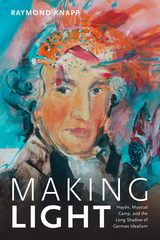 Making Light: Haydn, Musical Camp, and the Long Shadow of German Idealism
Raymond Knapp
Duke University Press, 2018 In Making Light Raymond Knapp traces the musical legacy of German Idealism as it led to the declining prestige of composers such as Haydn while influencing the development of American popular music in the nineteenth century. Knapp identifies in Haydn and in early popular American musical cultures such as minstrelsy and operetta a strain of high camp—a mode of engagement that relishes both the superficial and serious aspects of an aesthetic experience—that runs antithetical to German Idealism's musical paradigms. By considering the disservice done to Haydn by German Idealism alongside the emergence of musical camp in American popular music, Knapp outlines a common ground: a humanistically based aesthetic of shared pleasure that points to ways in which camp receptive modes might rejuvenate the original appeal of Haydn's music that has mostly eluded audiences. In so doing, Knapp remaps the historiographical modes and systems of critical evaluation that dominate musicology while troubling the divide between serious and popular music.
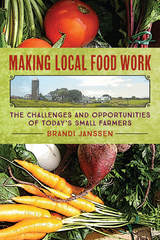 Making Local Food Work: The Challenges and Opportunities of Today's Small Farmers
Brandi Janssen
University of Iowa Press, 2017 When it comes to local food, it takes more than “knowing your farmer.” Brandi Janssen takes on some of the myths about how the local food system works and what it needs to thrive. Advocates claim that small biodiverse farms will fundamentally change farming, rural communities, and the American diet. For many, simply by knowing our farmers we become champions of a new way of eating that revolutionizes our economy and society. But that argument ignores the fact that if local food is to succeed, it requires many of the trappings of conventional food production, including processors, middle men, inspectors, and regulators.
By listening to and working alongside people trying to build a local food system in Iowa, Janssen uncovers the complex realities of making it work. Although the state is better known for its vast fields of conventionally grown corn and soybeans, it has long boasted a robust network of small, diverse farms, community supported agriculture enterprises, and farmers’ markets. As she picks tomatoes, processes wheatgrass, and joins a parents’ committee trying to buy local lettuce for a school lunch, Janssen asks how small farmers and CSA owners deal with farmers’ market regulations, neighbors who spray pesticides on crops or lawns, and sanitary regulations on meat processing and milk production. How can they meet the needs of large buyers like school districts? Who does the hard work of planting, weeding, harvesting, and processing? Is local food production benefitting rural communities as much as advocates claim?
In answering these questions, Janssen displays the pragmatism and level-headedness one would expect of the heartland, much like the farmers and processors profiled here. It’s doable, she states, but we’re going to have to do more than shop at our local farmers’ market to make it happen. This book is an ideal introduction to what local food means today and what it might be tomorrow.
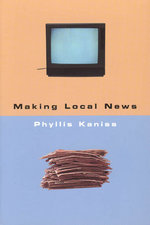 Making Local News
Phyllis Kaniss
University of Chicago Press, 1991 Why do crimes and accidents earn more news coverage than development and policy issues affecting thousands of people? Filled with revealing interviews with both journalists and city officials, Making Local News is the first comprehensive look at how the economic motives of media owners, professional motives of journalists, and the strategies of media-wise politicians shape the news we see and hear, thereby influencing urban policy.
"Making Local News by Phyllis Kaniss . . . is significant. . . . If we can continue to get smarter about that which journalism leaves out or distorts in its coverage of politics, we may eventually get smarter about politics itself."—Mitchell Stephens, The Philadelphia Inquirer View
"A convincing analysis of the factors and forces which color how and why local issues do, or do not, become newsworthy." —Michael H. Ebner, Journal of Interdisciplinary History
"This work serves as a reminder of the importance of a medium that is often overlooked until economic realities threaten its very existence." —Choice
"Kaniss is truly a pioneer in the study of local news."—Susan Herbst, Contemporary Sociology
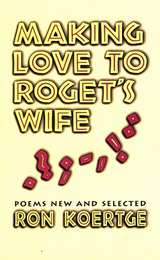 Making Love to Roget's Wife: Poems New and Selected
Ron Koertge
University of Arkansas Press, 2001 In plain, unpretentious language, with brutal honesty, Ron Koertge can meld violence, love, human ugliness, joy, and modern depravity into a short lyric that makes us laugh out loud or socks us in the gut. His images arrive in giant clown shoes—cigars the size of Florida, the plastic man’s counter-length arms—or neatly packaged in carefully observed detail, as he writes of the “black little hearts” of ants or an ape’s “dark and leathery breast.” Through every poem, there runs a constant and sincere humanity, a voice that laughs at itself, often goads us a bit, but always stuns and enlightens us when we dis – cover something of ourselves gambling with the crowd at the racetrack, driving from the parking lot of the Mexican restaurant, or shambling with the distraught parent leaving the hospital. In Making Love to Roget’s Wife, Ron Koertge offers his best work from twenty-three years and a dozen earlier collections. With twenty-five new poems, and over eighty from previous books, this selection reawakens us to the presence of a superbly honed comic voice.
 Making Love with the Land: Essays
Joshua Whitehead
University of Minnesota Press, 2024 A moving and deeply personal excavation of Indigenous beauty and passion in a suffering world
The novel Jonny Appleseed established Joshua Whitehead as one of the most exciting and important new literary voices on Turtle Island, winning both a Lambda Literary Award and Canada Reads 2021. In Making Love with the Land, his first nonfiction book, Whitehead explores the relationships between body, language, and land through creative essay, memoir, and confession. In prose that is evocative and sensual, unabashedly queer and visceral, raw and autobiographical, Whitehead writes of an Indigenous body in pain, coping with trauma. Deeply rooted within, he reaches across the anguish to create a new form of storytelling he calls “biostory”—beyond genre, and entirely sovereign. Through this narrative perspective, Making Love with the Land recasts mental health struggles and our complex emotional landscapes from a nefarious parasite on his (and our) well-being to kin, even a relation, no matter what difficulties they present to us. Whitehead ruminates on loss and pain without shame or ridicule but rather highlights waypoints for personal transformation. Written in the aftermath of heartbreak, before and during the pandemic, Making Love with the Land illuminates this present moment in which both Indigenous and non-Indigenous people are rediscovering old ways and creating new ones about connection with and responsibility toward each other and the land. Intellectually audacious and emotionally compelling, Whitehead shares his devotion to the world in which we live and brilliantly—even joyfully—maps his experience on the land that has shaped stories, histories, and bodies from time immemorial.
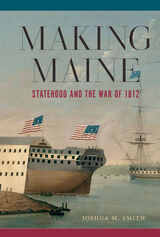 Making Maine: Statehood and the War of 1812
Joshua M. Smith
University of Massachusetts Press, 2022 Honorable mention for U.S. Maritime History, John Lyman Book Awards
After the Revolutionary War ended, the new American nation grappled with a question about its identity: Were the states sovereign entities or subordinates to a powerful federal government? The War of 1812 brought this vexing issue into sharp relief, as a national government intent on waging an unpopular war confronted a populace in Massachusetts that was vigorously opposed to it. Maine, which at the time was part of Massachusetts, served as the battleground in this political struggle. Joshua M. Smith recounts an innovative history of the war, focusing on how it specifically affected what was then called the District of Maine. Drawing on archival materials from the United States, Britain, and Canada, Smith exposes the bitter experience of Maine’s citizens during that conflict as they endured multiple hardships, including starvation, burdensome taxation, smuggling, treason, and enemy occupation. War’s inherent miseries, along with a changing relationship between regional and national identities, gave rise to a statehood movement that rejected a Boston-centric worldview in favor of a broadly American identity.
 Making Manhood: Growing Up Male in Colonial New England
Anne S. Lombard
Harvard University Press, 2003 Countering our image of early Anglo-American families as dominated by harsh, austere patriarchs, Anne Lombard challenges long-held assumptions about the history of family life by casting a fresh look at the experience of growing up male in seventeenth- and eighteenth-century New England. Drawing upon sources ranging from men's personal writings to court records to medical literature, Lombard finds that New England's Puritan settlers and their descendants shared a distinctive ideal of manhood that decisively shaped the lives of boys and men.
At its core was a suspicion of emotional attachments between men and women. Boys were taken under their father's wing from a young age and taught the virtues of reason, responsibility, and maturity. Intimate bonds with mothers were discouraged, as were individual expression, pride, and play. The mature man who moderated his passions and contributed to his family and community was admired, in sharp contrast to the young, adventurous, and aggressive hero who would emerge after the American Revolution and embody our modern image of masculinity.
Lombard writes with empathy and sensitivity of colonial life and the ways in which it interacted not only with male experience but also with the larger political history of eighteenth-century America.
Making March Madness: The Early Years of the NCAA, NIT, and College Basketball Championships, 1922-1951
Chad Carlson
University of Arkansas Press, 2017 Throughout the NCAA Tournament’s history, underdogs, Cinderella stories, and upsets have captured the attention and imagination of fans. Making March Madness is the story of this premiere tournament, from its early days in Kansas City, to its move to Madison Square Garden, to its surviving a point-shaving scandal in New York and taking its games to different sites across the country.Chad Carlson’s analysis places college basketball in historical context and connects it to larger issues in sport and American society, providing fresh insights on a host of topics that readers will find interesting, illuminating, and thought provoking.
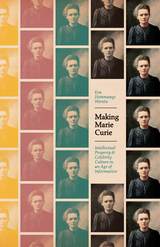 Making Marie Curie: Intellectual Property and Celebrity Culture in an Age of Information
Eva Hemmungs Wirtén
University of Chicago Press, 2015 In many ways, Marie Curie represents modern science. Her considerable lifetime achievements—the first woman to be awarded a Nobel Prize, the only woman to be awarded the Prize in two fields, and the only person to be awarded Nobel Prizes in multiple sciences—are studied by schoolchildren across the world. When, in 2009, the New Scientist carried out a poll for the “Most Inspirational Female Scientist of All Time,” the result was a foregone conclusion: Marie Curie trounced her closest runner-up, Rosalind Franklin, winning double the number of Franklin’s votes. She is a role model to women embarking on a career in science, the pride of two nations—Poland and France—and, not least of all, a European Union brand for excellence in science.
Making Marie Curie explores what went into the creation of this icon of science. It is not a traditional biography, or one that attempts to uncover the “real” Marie Curie. Rather, Eva Hemmungs Wirtén, by tracing a career that spans two centuries and a world war, provides an innovative and historically grounded account of how modern science emerges in tandem with celebrity culture under the influence of intellectual property in a dawning age of information. She explores the emergence of the Curie persona, the information culture of the period that shaped its development, and the strategies Curie used to manage and exploit her intellectual property. How did one create and maintain for oneself the persona of scientist at the beginning of the twentieth century? What special conditions bore upon scientific women, and on married women in particular? How was French identity claimed, established, and subverted? How, and with what consequences, was a scientific reputation secured?
In its exploration of these questions and many more, Making Marie Curie provides a composite picture not only of the making of Marie Curie, but the making of modern science itself.
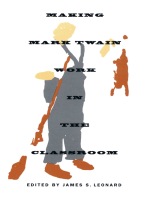 Making Mark Twain Work in the Classroom
James S. Leonard, ed.
Duke University Press, 1999 How does one teach Mark Twain’s Huckleberry Finn, a book as controversial as it is central to the American literary canon? This collection of essays edited by James S. Leonard offers practical classroom methods for instructors dealing with the racism, the casual violence, and the role of women, as well as with structural and thematic discrepancies in the works of Mark Twain. The essays in Making Mark Twain Work in the Classroom reaffirm the importance of Twain in the American literature curriculum from high school through graduate study. Addressing slavery and race, gender, class, religion, language and ebonics, Americanism, and textual issues of interest to instructors and their students, the contributors offer guidance derived from their own demographically diverse classroom experiences. Although some essays focus on such works as A Connecticut Yankee in King Arthur’s Court and The Innocents Abroad, most discuss the hotly debated Adventures of Huckleberry Finn, viewed alternately in this volume as a comic masterpiece or as evidence of Twain’s growing pessimism—but always as an effective teaching tool. By placing Twain’s work within the context of nineteenth-century American literature and culture, Making Mark Twain Work in the Classroom will interest all instructors of American literature. It will also provoke debate among Americanists and those concerned with issues of race, class, and gender as they are represented in literature. Contributors. Joseph A. Alvarez, Lawrence I. Berkove, Anthony J. Berret, S.J., Wesley Britton, Louis J. Budd, James E. Caron, Everett Carter, Jocelyn Chadwick-Joshua, Pascal Covici Jr., Beverly R. David, Victor Doyno, Dennis W. Eddings, Shelley Fisher Fishkin, S. D. Kapoor, Michael J. Kiskis, James S. Leonard, Victoria Thorpe Miller, Stan Poole, Tom Reigstad, David E. E. Sloane, David Tomlinson
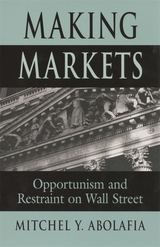 Making Markets: Opportunism and Restraint on Wall Street
Mitchel Y. Abolafia
Harvard University Press, 1996 In the wake of million-dollar scandals brought about by Michael Milken, Ivan Boesky, and their like, Wall Street seems like the province of rampant individualism operating at the outermost extremes of self-interest and greed. But this, Mitchel Abolafia suggests, would be a case of missing the real culture of the Street for the characters who dominate the financial news.
Making Markets, an ethnography of Wall Street culture, offers a more complex picture of how the market and its denizens work. Not merely masses of individuals striving independently, markets appear here as socially constructed institutions in which the behavior of traders is suspended in a web of customs, norms, and structures of control. Within these structures we see the actions that led to the Drexel Burnham and Salomon Brothers debacles not as bizarre aberrations, but as mere exaggerations of behavior accepted on the Street.
Abolafia looks at three subcultures that coexist in the world of Wall Street: the stock, bond, and futures markets. Through interviews, anecdotes, and the author’s skillful analysis, we see how traders and New York Stock Exchange “specialists” negotiate the perpetual tension between short-term self-interest and long-term self-restraint that marks their respective communities—and how the temptation toward excess spurs market activity. We also see the complex relationships among those market communities—why, for instance, NYSE specialists resent the freedoms permitted over-the-counter bond traders and futures traders. Making Markets shows us that what propels Wall Street is not a fundamental human drive or instinct, but strategies enacted in the context of social relationships, cultural idioms, and institutions—a cycle that moves between phases of unbridled self-interest and collective self-restraint.
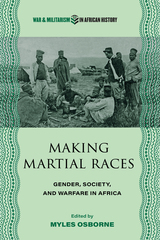 Making Martial Races: Gender, Society, and Warfare in Africa
Myles Osborne
Ohio University Press, 2024 A central organizing category in colonial Africa, “martial race” was a notion debated and negotiated between African men and women and the European officials who sought to control them. European colonizers in Africa required the service of local soldiers and military auxiliaries to uphold their power. These African men were initially engaged by the expeditions of European surveyors and explorers during the late nineteenth century, then quickly pressed into service in the notorious campaigns of pacification. Two world wars further expanded both the numbers of African soldiers in European employ and the roles they played; many of these men would continue their jobs into the era of decolonization in the 1960s and 1970s. Colonial administrators and military planners often chose their recruits based on the notion of “martial race”—a label that denoted peoples supposedly possessing an inborn aptitude for warfare and fighting. But the notion always obscured more than it revealed: few Europeans could agree on which “races”—or ethnic groups—were “martial,” and in any case, the identities of those groups changed continuously. Nevertheless, this belief remained a fundamental, guiding principle of the European presence in colonial Africa. The concept of “martial race” remains an awkward and ill-fitting Eurocentric category until African contributions, perspectives, and agencies are considered. “Martial race” was never a label neatly affixed by European administrators; rather, African peoples both contested its terms and shaped its contours. This book therefore takes as its starting point the idea of martial race and recasts it as a zone in which African men and women negotiated with their European counterparts, as well as with one another. The contributors to this volume take a broad approach to the topic, one that minimizes divisions between the precolonial, colonial, and postcolonial eras, and thinks through how cultural practices and notions of warfare and martial traditions shifted and were transformed from one period into another. These scholars’ research touches on a wide variety of subjects, including efforts to think about culture and martial race; the intersection of ethnic identity and the creation of “tribes” with colonial martial race theory; the connection between colonial ethnography and constructions of martial subjectivities; the role of gender in shaping martial notions; the contribution of women to creating or disputing martial identities; the idea of martial race as it intersected with slavery; warring traditions and economies of honor as avenues for staking claims to martial genealogies; and claims to special status by veterans of anticolonial revolutionary wars.
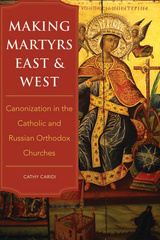 Making Martyrs East and West: Canonization in the Catholic and Russian Orthodox Churches
Cathy Caridi
Northern Illinois University Press, 2015 For centuries, Catholics in the Western world and the Orthodox in Russia have venerated certain saints as martyrs. In many cases, both churches recognize as martyrs the same individuals who gave their lives for Jesus Christ. On the surface, it appears that while the external liturgical practices of Catholics and Russian Orthodox may vary, the fundamental theological understanding of what it means to be a martyr, and what it means to canonize a saint, are essentially the same. But are they?
In Making Martyrs East and West, Caridi examines how the practice of canonization developed in the West and in Russia, focusing on procedural elements that became established requirements for someone to be recognized as a saint and a martyr. She investigates whether the components of the canonization process now regarded as necessary by the Catholic Church are fundamentally equivalent to those of the Russian Orthodox Church, and vice versa, while exploring the possibility that the churches use the same terminology and processes, but in fundamentally different ways that preclude the acceptance of one church’s saints by the other.
Caridi examines official church documents and numerous canonization records, collecting and analyzing information from several previously untapped medieval Russian sources. Her highly readable study is the first to focus on the historical documentation on canonization specifically for juridical significance. It will appeal to scholars of religion and church history, as well as ecumenicists, liturgists, canonists, and those interested in East-West ecumenical efforts.
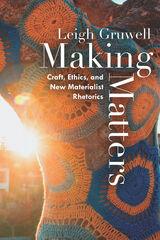 Making Matters: Craft, Ethics, and New Materialist Rhetorics
Leigh Gruwell
Utah State University Press, 2022 Craft is a process-oriented practice that takes seriously the relationships between bodies—both human and nonhuman—and makes apparent how these relationships are mired in and informed by power structures. Making Matters introduces craft agency, a feminist vision of new materialist rhetorics that enables scholars to identify how power circulates and sometimes stagnates within assemblages of actors and provides tools to rectify that uneven distribution.
To recast new materialist rhetorics as inherently crafty, Leigh Gruwell historicizes and locates the concept of craft both within rhetorical history as well as in the disciplinary history of writing studies. Her investigation centers on three specific case studies: craftivism, the fibercraft website Ravelry, and the 2017 Women’s March. These instances all highlight how a material, ecological understanding of rhetorical agency can enact political change.
Craft agency models how we humans might work with and alongside things—nonhuman, sometimes digital, sometimes material—to create more equitable relationships. Making Matters argues that craft is a useful starting point for addressing criticisms of new materialist rhetorics not only because doing so places rhetorical action as a product of complex relationships between a network of human and nonhuman actors, but also because it does so with an explicitly activist agenda that positions the body itself as a material interface.
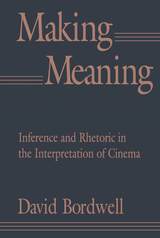 Making Meaning: Inference and Rhetoric in the Interpretation of Cinema
David Bordwell
Harvard University Press, 1989 David Bordwell’s new book is at once a history of film criticism, an analysis of how critics interpret film, and a proposal for an alternative program for film studies. It is an anatomy of film criticism meant to reset the agenda for film scholarship. As such Making Meaning should be a landmark book, a focus for debate from which future film study will evolve.
Bordwell systematically maps different strategies for interpreting films and making meaning, illustrating his points with a vast array of examples from Western film criticism. Following an introductory chapter that sets out the terms and scope of the argument, Bordwell goes on to show how critical institutions constrain and contain the very practices they promote, and how the interpretation of texts has become a central preoccupation of the humanities. He gives lucid accounts of the development of film criticism in France, Britain, and the United States since World War II; analyzes this development through two important types of criticism, thematic-explicatory and symptomatic; and shows that both types, usually seen as antithetical, in fact have much in common. These diverse and even warring schools of criticism share conventional, rhetorical, and problem-solving techniques—a point that has broad-ranging implications for the way critics practice their art. The book concludes with a survey of the alternatives to criticism based on interpretation and, finally, with the proposal that a historical poetics of cinema offers the most fruitful framework for film analysis.
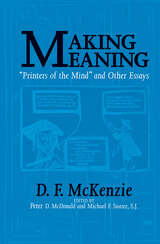 Making Meaning: "Printers of the Mind" and Other Essays
D. F. McKenzie
University of Massachusetts Press, 2002 The greatest bibliographer of our time, was how historian Robert Darnton described D. F. McKenzie. Yet until now many of McKenzie's major essays, scattered in specialist journals and inaccessible publications, have circulated mainly in tattered photocopies. This volume, edited by two of McKenzie's former students, brings together for the first time a wide range of his writings on bibliography, the book trade, and the "sociology of texts." Selected by the author himself before his sudden death in 1999, the essays range from the material transmission of Shakespeare's plays in the seventeenth century to the connections among oral, manuscript, and print cultures.
Making Meaning reflects McKenzie's virtuosity as a traditional bibliographer and reveals how his thought-provoking scholarship made him a driving force in the genesis and development of the new interdisciplinary field of book history. His refusal to recognize the traditional boundary between bibliography and literary history re-energized the study of the social, political, economic, and cultural aspects of book production and reception.
The editors' introduction and headnotes situate McKenzie's innovative and controversial thinking in the debates of his time.
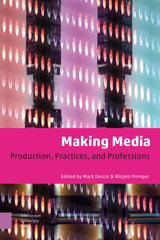 Making Media: Production, Practices, and Professions
Mark Deuze
Amsterdam University Press, 2019 'Making Media' uncovers what it means and what it takes to make media, focusing on the lived experience of media professionals within the global media, including rich case studies of the main media industries and professions: television, journalism, social media entertainment, advertising and public relations, digital games, and music. This carefully edited volume features 35 authoritative essays by 53 researchers from 14 countries across 6 continents, all of whom are at the cutting edge of media production studies.
The book is particularly designed for use in coursework on media production, media work, media management, and media industries.
Specific topics highlighted:
the history of media industries and production studies; production studies as a field and a research method; changing business models, economics, and management; global concentration and convergence of media industries and professions; the rise and role of startups and entrepreneurship; freelancing in the digital age; the role of creativity and innovation; the emotional quality of media work; diversity and inequality in the media industries.
Open Uva Course
The University of Amsterdam has a open course around the book. The course offers a review of the key readings and debates in media production studies.
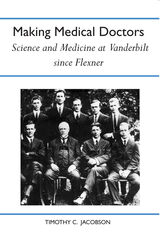 Making Medical Doctors: Science and Medicine at Vanderbilt since Flexner
Timothy C. Jacobson
University of Alabama Press, 1987 A study of the union of science and medicine in a particularly illustrative institutional setting
Making Medical Doctors is not a conventional institutional history, but rather a study of the union of science and medicine in a particularly illustrative institutional setting. Its general subject is the institution where science and medicine most dramatically came together: the modern medical school and medical center. Its particular subject is the medical school and center of Vanderbilt University, which was rebuilt in the 1920s as a model for medical education and research. Making Medical Doctors also explores the intellectual and financial sources of institutional development: the worlds of Abraham Flexner, Frederick T. Gates, and Henry S. Pritchett, three foundation masters of the early 20th century. It examines closely the vanished medical world of that generation of doctors who reached the height of their influence in the period between the two world wars and describes how they actually did medicine, surgery, and science.
The convergence of science and medicine in the 19th and 20th centuries produced what we know today as modern medicine. The balance of power and interdependence between science and medicine have changed vastly from the 1920s and 1930s, as Vanderbilt’s story clearly illustrates.
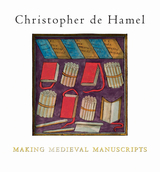 Making Medieval Manuscripts
Christopher de Hamel
Bodleian Library Publishing, 2017 Many beautiful illuminated manuscripts survive from the Middle Ages and can be seen in libraries and museums throughout Europe. But who were the skilled craftsmen who made these exquisite books? What precisely is parchment? How were medieval manuscripts designed and executed? What were the inks and pigments, and how were they applied? Examining the work of scribes, illuminators, and bookbinders, this lavishly illustrated account tells the story of manuscript production from the early Middle Ages through to the high Renaissance. Each stage of production is described in detail, from the preparation of the parchment, pens, paints, and inks to the writing of the scripts and the final decoration of the manuscript. Christopher de Hamel’s engaging text is accompanied by a glossary of key technical terms relating to manuscripts and illumination, providing an invaluable introduction for anyone interested in studying medieval manuscripts today.
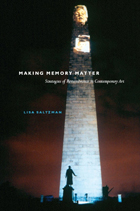 Making Memory Matter: Strategies of Remembrance in Contemporary Art
Lisa Saltzman
University of Chicago Press, 2006 In an ancient account of painting’s origins, a woman traces the shadow of her departing lover on the wall in an act that anticipates future grief and commemoration. Lisa Saltzman shows here that nearly two thousand years after this story was first told, contemporary artists are returning to similar strategies of remembrance, ranging from vaudevillian silhouettes and sepulchral casts to incinerated architectures and ghostly processions.
Exploring these artists’ work, Saltzman demonstrates that their methods have now eclipsed painting and traditional sculpture as preeminent forms of visual representation. She pays particular attention to the groundbreaking art of Krzysztof Wodiczko, who is known for his projections of historical subjects; Kara Walker, who creates powerful silhouetted images of racial violence in American history; and Rachel Whiteread, whose work centers on making casts of empty interior spaces. Each of the artists Saltzman discusses is struggling with the roles that history and memory have come to play in an age when any historical statement is subject to question and doubt. In identifying this new and powerful movement, she provides a framework for understanding the art of our time.
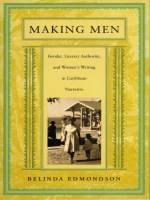 Making Men: Gender, Literary Authority, and Women’s Writing in Caribbean Narrative
Belinda Edmondson
Duke University Press, 1998 Colonialism left an indelible mark on writers from the Caribbean. Many of the mid-century male writers, on the eve of independence, looked to England for their models. The current generation of authors, many of whom are women, have increasingly looked—and relocated—to the United States. Incorporating postcolonial theory, West Indian literature, feminist theory, and African American literary criticism, Making Men carves out a particular relationship between the Caribbean canon—as represented by C. L. R. James and V. S. Naipaul, among others—and contemporary Caribbean women writers such as Jean Rhys, and Jamaica Kincaid, Paule Marshall, and Michelle Cliff, who now live in the United States.
Discussing the canonical Caribbean narrative as it reflects national identity under the domination of English cultural authority, Belinda Edmondson focuses particularly on the pervasive influence of Victorian sensibilities in the structuring of twentieth-century national identity. She shows that issues of race and English constructions of masculinity not only are central to West Indian identity but also connect Caribbean authorship to the English literary tradition. This perspective on the origins of West Indian literary nationalism then informs Edmondson’s search for female subjectivity in current literature by West Indian women immigrants in America. Making Men compares the intellectual exile of men with the economic migration of women, linking the canonical male tradition to the writing of modern West Indian women and exploring how the latter write within and against the historical male paradigm in the continuing process of national definition.
With theoretical claims that invite new discourse on English, Caribbean, and American ideas of exile, migration, race, gender identity, and literary authority, Making Men will be informative reading for those involved with postcolonial theory, African American and women’s studies, and Caribbean literature.
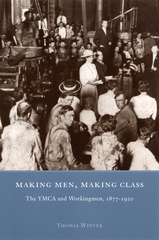 Making Men, Making Class: The YMCA and Workingmen, 1877-1920
Thomas Winter
University of Chicago Press, 2002 During the late nineteenth and early twentieth centuries, the United States transformed from an essentially agrarian society into an urban, industrialized economy. In Making Men, Making Class, Thomas Winter explores the impact of these profound changes on constructions of manhood, using the YMCA's new efforts to reach out to railroad and industrial workers as a case study.
Starting in the 1870s, the leaders ("secretaries") of the YMCA sought to reduce political radicalism and labor unrest by instilling new ideals of manliness among workers. By involving workingmen in a range of activities on the job and off, the YMCA hoped to foster team spirit, moral conduct, and new standards of manhood that would avoid conflict and instead encourage cooperation along the lines of a Christian, pious manliness. In their efforts to make better men, the secretaries of the YMCA also crafted new ideals of middle-class manliness for themselves that involved a sense of mission and social purpose. In doing so, they ended up "making" class, too, as they began to speak a language of manhood structured by class differences.
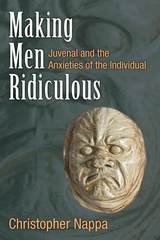 Making Men Ridiculous: Juvenal and the Anxieties of the Individual
Christopher Nappa
University of Michigan Press, 2018 Writing during the reign of emperors Trajan and Hadrian, Juvenal drew on Roman legend and the history of preceding imperial dynasties as a means of scrutinizing cultural upheavals in the Rome of his day. Tacky foreigners, the nouveaux riches, women who don’t know their place, bloodthirsty—even crazy—emperors and their (often worse) wives confront the reader at every turn, along with bad poets, corrupt aristocrats, gladiators, whores, false philosophers, sad-sack men in the street, and slaves. Juvenal’s poetry set the tone, and often the topics, for satirists throughout the centuries of European literature.
In his sixteen verse satires, Juvenal presents speakers who decry the breakdown in traditional Roman values and the status of Roman men as they are confronted by upstart foreigners, devious and deviant women, class traitors, the power of the imperial household, and even the body itself. The satirist castigates vice and immorality even as he revels in describing them. This book locates Juvenal’s targets among the matrices of birth, wealth, class, gender, and ethnicity and walks carefully through a number of his most arresting vignettes in order to show not only what, but how, he satirizes. Moreover, the analysis shows that Juvenal’s portraits sometimes escape his grasp, and, as often as not, he ends up undermining the voice with which he speaks and the values he claims to hold dear. Individual chapters look at the satirist himself, rebellious bodies, disgraced aristocrats, uppity (even murderous) wives, and the necessary but corrupting power of money. The conclusion considers the endurance of both the targets and the rhetoric behind them in the modern world.
Making Men Ridiculous will interest scholars and advanced students of ancient satire, later European satire, imperial Roman culture and literature, and class, gender, and sexuality in the ancient world.
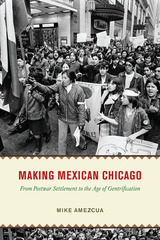 Making Mexican Chicago: From Postwar Settlement to the Age of Gentrification
Mike Amezcua
University of Chicago Press, 2022 Winner of the Immigration and Ethnic History Society’s First Book Award: an exploration of how the Windy City became a postwar Latinx metropolis in the face of white resistance.
Though Chicago is often popularly defined by its Polish, Black, and Irish populations, Cook County is home to the third-largest Mexican-American population in the United States. The story of Mexican immigration and integration into the city is one of complex political struggles, deeply entwined with issues of housing and neighborhood control. In Making Mexican Chicago, Mike Amezcua explores how the Windy City became a Latinx metropolis in the second half of the twentieth century.
In the decades after World War II, working-class Chicago neighborhoods like Pilsen and Little Village became sites of upheaval and renewal as Mexican Americans attempted to build new communities in the face of white resistance that cast them as perpetual aliens. Amezcua charts the diverse strategies used by Mexican Chicagoans to fight the forces of segregation, economic predation, and gentrification, focusing on how unlikely combinations of social conservatism and real estate market savvy paved new paths for Latinx assimilation. Making Mexican Chicago offers a powerful multiracial history of Chicago that sheds new light on the origins and endurance of urban inequality.
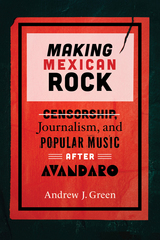 Making Mexican Rock: Censorship, Journalism, and Popular Music after Avándaro
Andrew J. Green
Vanderbilt University Press, 2024 The history of Mexican rock is one of censorship. A number of cultural histories recount how rock was repressed, censored, and marginalized by Mexico’s single-party regime in the twentieth century, often focusing on the authoritarian crackdown that followed a mediatized moral panic after the Avándaro Festival of 1971. The popular 2020 Netflix documentary Break It All, for example, positions Mexican rock as a potent expression of resistance in the late twentieth century, forging a strong association with Mexico’s transition away from authoritarian rule and toward neoliberal democracy.
Yet in light of the failures of successive democratically elected governments in Mexico, these histories are worth critically revisiting and updating. What stories about music censorship can be told after Mexico’s transition to multi-party democracy? Placing history and ethnography into dialogue, Making Mexican Rock explores historical and recent experiences of censorship and repression against popular music, focusing on the independent rock scene (or “escena independiente”) in Mexico City.
Informed by the so-called new censorship theory, ethnomusicologist Andrew J. Green challenges historical accounts that equate acts of censorship with state activity. The open-ended account of censorship assumed here helps us to understand, instead, how conceptions of censorship and expressive freedom transformed toward the end of single-party rule; how practices of policing live rock adapted to neoliberal securitization; and how histories of rock censorship have been invoked by those seeking to construct and protect emergent music scenes. Making Mexican Rock thus both decenters histories of music censorship from the state, and extends them into the country’s recent history.
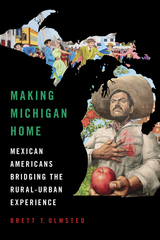 Making Michigan Home: Mexican Americans Bridging the Rural-Urban Experience
Brett T. Olmsted
University of Illinois Press, 2025 Mexicanos in Michigan and across the Midwest share a common experience: living as largely invisible outsiders as they struggled to build vibrant communities in places that wanted their labor but not their presence. Brett Olmsted ranges from the 1920s to the 1970s as he analyzes how Mexicanos sought to transcend social, cultural, economic, and political exclusion. Never numerous in any one area, Mexican Americans pursued inclusion via leisure spaces and labor unionism. Activities like celebrations, sports, movies, and music encouraged Mexicanos to claim physical and social space, connect with Michigan’s other Mexicano communities, and construct their own sense of identity. Mexicano workers, meanwhile, embraced interethnic union activism to address racism in job placement and promotion. Olmsted also examines how the state’s Mexicanos adapted to Michigan’s dual economy and found advantages in moving back-and-forth between rural and urban areas. In-depth and innovative, Making Michigan Home spotlights the state’s overlooked Mexicanos and their distinctive experiences within the Latina/o/x Studies Midwest.
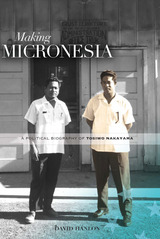 Making Micronesia: A Political Biography of Tosiwo Nakayama
David L. Hanlon
University of Hawaii Press, 2014 Why are islanders so lavishly generous with food and material possessions but so guarded with information? Why do these people, unfailingly polite for the most part, laugh openly when others embarrass themselves? What does a smile mean to an islander? What might a sudden lapse into silence signify? These questions are common in encounters with an unfamiliar Pacific Island culture. Making Sense of Micronesia is intended for westerners who find themselves in contact with Micronesians—as teachers, social workers, health-care providers, or simply as friends—and are puzzled by their island ways. It is for anyone struggling to make sense of cultural exchanges they don’t quite understand.
The author focuses on the guts of island culture: the importance of the social map, the tension between the individual and social identity, the ways in which wealth and knowledge are used, the huge importance of respect, emotional expression and its restraints, island ways of handling both conflict and intimacy, the real but indirect power of women. Far from a theoretical exposition, the book begins and ends with the real-life behavior of islanders. Each section of every chapter is introduced by a vignette that illustrates the theme discussed. The book attempts to explain island behavior, as curious as it may seem to outsiders at times, against the over-riding pattern of values and attitudes that have always guided island life.
Even as the author maps the cultural terrain of Micronesia, he identifies those areas where island logic and the demands of the modern world conflict: the “dilemmas of development.” In some cases, changes are being made; in others, the very features of island culture that were highly functional in the past may remain so even today. Overall, he advocates restraint—in our judgments on island practices, in our assumption that many of these are dysfunctional, and in leading the charge for “development” before understanding the broader context of the culture we are trying to convert.
Making Migration Work: The Future of Labour Migration in the European Union
Edited by Jan Willem Holtslag, Monique Kremer, and Erik Schrijvers
Amsterdam University Press, 2013 Largely because of the European Union’s two-phase expansion in 2004 and 2007, labor migration across the continent has changed significantly in recent years. Notably, the EU’s policy of open borders has enabled a growing stream of workers to leave new member states in search of higher wages. As a result, the nature, scale, and direction of migration flows have changed dramatically. Making Migration Work explores how policy can—and should—address these changes. In the process, this timely volume considers the future trajectory of a phenomenon that has become an increasingly sensitive political issue in many European nations.
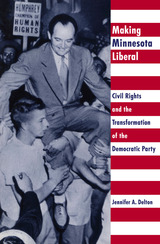 Making Minnesota Liberal: Civil Rights And The Transformation Of The Democratic Party
Jennifer A. Delton
University of Minnesota Press, 2002 The surprising story of how Minnesota politicians helped redirect the course of American politics.
How did a largely white state like Minnesota become a springboard for leadership in civil rights? Why did it produce a generation of liberals-Hubert Humphrey, Walter Mondale, Donald Fraser, Orville Freeman, and Eugene McCarthy-whose ideals transformed the Democratic Party?
In Making Minnesota Liberal, Jennifer A. Delton delves into the roots of Minnesota politics for the answer, tracing the change from the regional, third-party, class-oriented politics of the Farmer-Labor Party to the national, two-party, pluralistic liberalism of the Democratic-Farmer-Labor Party (DFL). While others have examined how anticommunism and the Cold War shaped this transformation, Delton takes a new approach, showing the key roles played by antiracism and the civil rights movement. In telling this story, Delton contributes to our understanding not only of Minnesota's political history but also of the relationship between antiracism and American politics in the twentieth century.
Making Minnesota Liberal combines political history with a discussion of the symbolic role played by race in political battles between whites. Delton recounts the creation of Minnesota's Farmer-Labor Party, its merger with the Democrats, and the acrimonious battle for control of the DFL just after World War II. She argues that the Humphrey liberals won this battle in part because antiracism activities enabled previously antagonistic groups, divided by ethnicity, religion, and class, to unify around a common cause.
Delton contends that although liberal Minnesotans' concern for racial justice was genuine, it also provided them with national political relevance and imbued their bid for power with a sense of morality. Ultimately the language of tolerance and diversity that emerged from antiracism prepared Minnesotans for Humphrey's vision of a pluralistic and state-centered liberalism, which eventually became the model for Democratic politics nationwide. Making Minnesota Liberal is an absorbing and trenchant account of a key moment in American history, one that continues to resonate in our time.
Jennifer A. Delton is assistant professor of history at Skidmore College.
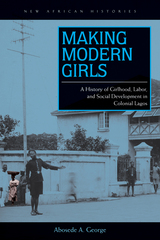 Making Modern Girls: A History of Girlhood, Labor, and Social Development in Colonial Lagos
Abosede A. George
Ohio University Press, 2014 Winner of the 2015 Aidoo-Snyder Book Prize for outstanding book on African women's experiences. (African Studies Association)
Honorable Mention, New York African Studies Association Book Prize In Making Modern Girls, Abosede A. George examines the influence of African social reformers and the developmentalist colonial state on the practice and ideology of girlhood as well as its intersection with child labor in Lagos, Nigeria. It draws from gender studies, generational studies, labor history, and urban history to shed new light on the complex workings of African cities from the turn of the twentieth century through the nationalist era of the 1950s.
The two major schemes at the center of this study were the modernization project of elite Lagosian women and the salvationist project of British social workers. By approaching children and youth, specifically girl hawkers, as social actors and examining the ways in which local and colonial reformers worked upon young people, the book offers a critical new perspective on the uses of African children for the production and legitimization of national and international social development initiatives.
Making Modern Girls demonstrates how oral sources can be used to uncover the social history of informal or undocumented urban workers and to track transformations in practices of childhood over the course of decades. George revises conventional accounts of the history of development work in Africa by drawing close attention to the social welfare initiatives of late colonialism and by highlighting the roles that African women reformers played in promoting sociocultural changes within their own societies.
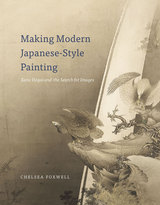 Making Modern Japanese-Style Painting: Kano Hogai and the Search for Images
Chelsea Foxwell
University of Chicago Press, 2015 The Western discovery of Japanese paintings at nineteenth-century world’s fairs and export shops catapulted Japanese art to new levels of international popularity. With that popularity, however, came criticism, as Western writers began to lament a perceived end to pure Japanese art and a rise in westernized cultural hybrids. The Japanese response: nihonga, a traditional style of painting that reframed existing techniques to distinguish them from Western artistic conventions. Making Modern Japanese-Style Painting explores the visual characteristics and social functions of nihonga and traces its relationship to the past, its viewers, and emerging notions of the modern Japanese state.
Chelsea Foxwell sheds light on interlinked trends in Japanese nationalist discourse, government art policy, American and European commentary on Japanese art, and the demands of export. The seminal artist Kano Hogai (1828–88) is one telling example: originally a painter for the shogun, his art eventually evolved into novel, eerie images meant to satisfy both Japanese and Western audiences. Rather than simply absorbing Western approaches, nihonga as practiced by Hogai and others broke with pre-Meiji painting even as it worked to neutralize the rupture.
By arguing that fundamental changes to audience expectations led to the emergence of nihonga—a traditional interpretation of Japanese art for a contemporary, international market—Making Modern Japanese-Style Painting offers a fresh look at an important aspect of Japan’s development into a modern nation.
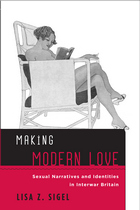 Making Modern Love: Sexual Narratives and Identities in Interwar Britain
Lisa Z. Sigel
Temple University Press, 2012 After the Great War, British men and women grappled with their ignorance about sexuality and desire. Seeking advice and information from doctors, magazines, and each other, they wrote tens of thousands of letters about themselves as sexual subjects. In these letters, they disclosed their uncertainties, their behaviors, and the role of sexuality in their lives. Their fascinating narratives tell how people sought to unleash their imaginations and fashion new identities. Making Modern Love shows how readers embraced popular media—self-help books, fetish magazines, and advice columns—as a source of information about sexuality and a means for telling their own stories. From longings for transcendent marital union to fantasies of fetish-wear, cross-dressing, and whipping, men and women revealed a surprising range of desires and behaviors (queer and otherwise) that have been largely disregarded until now. Lisa Sigel mines these provocative narratives to understand how they contributed to new subjectivities and the development of modern sexualities.
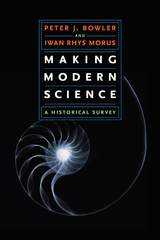 Making Modern Science: A Historical Survey
Peter J. Bowler and Iwan Rhys Morus
University of Chicago Press, 2005 The development of science, according to respected scholars Peter J. Bowler and Iwan Rhys Morus, expands our knowledge and control of the world in ways that affect-but are also affected by-society and culture. In Making Modern Science, a text designed for introductory college courses in the history of science and as a single-volume introduction for the general reader, Bowler and Morus explore both the history of science itself and its influence on modern thought.
Opening with an introduction that explains developments in the history of science over the last three decades and the controversies these initiatives have engendered, the book then proceeds in two parts. The first section considers key episodes in the development of modern science, including the Scientific Revolution and individual accomplishments in geology, physics, and biology. The second section is an analysis of the most important themes stemming from the social relations of science-the discoveries that force society to rethink its religious, moral, or philosophical values. Making Modern Science thus chronicles all major developments in scientific thinking, from the revolutionary ideas of the seventeenth century to the contemporary issues of evolutionism, genetics, nuclear physics, and modern cosmology.
Written by seasoned historians, this book will encourage students to see the history of science not as a series of names and dates but as an interconnected and complex web of relationships between science and modern society. The first survey of its kind, Making Modern Science is a much-needed and accessible introduction to the history of science, engagingly written for undergraduates and curious readers alike.
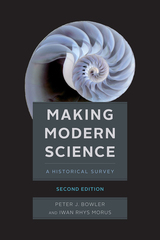 Making Modern Science, Second Edition
Peter J. Bowler and Iwan Rhys Morus
University of Chicago Press, 2020 In this new edition of the top-selling coursebook, seasoned historians Peter J. Bowler and Iwan Rhys Morus expand on their authoritative survey of how the development of science has shaped our world. Exploring both the history of science and its influence on modern thought, the authors chronicle the major developments in scientific thinking, from the revolutionary ideas of the seventeenth century to contemporary issues in genetics, physics, and more.
Thoroughly revised and expanded, the second edition draws on the latest research and scholarship. It also contains two entirely new chapters: one that explores the impact of computing on the development of science, and another that shows how the West used science and technology as tools for geopolitical expansion. Designed for entry-level college courses and as a single-volume introduction for the general reader, Making Modern Science presents the history of science not as a series of names and dates, but as an interconnected and complex web of relationships joining science and society.
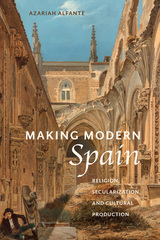 Making Modern Spain: Religion, Secularization, and Cultural Production
Azariah Alfante
Bucknell University Press, 2024 In this elegantly written study, Alfante explores the work of select nineteenth-century writers, intellectuals, journalists, politicians, and clergy who responded to cultural and spiritual shifts caused by the movement toward secularization in Spain. Focusing on the social experience, this book probes the tensions between traditionalism and liberalism that influenced public opinion of the clergy, sacred buildings, and religious orders. The writings of Cecilia Böhl de Faber (Fernán Caballero), Gustavo Adolfo Bécquer, Benito Pérez Galdós, and José María de Pereda addressed conflicts between modernizing forces and the Catholic Church about the place of religion and its signifiers in Spanish society. Foregrounding expropriation (government confiscation of civil and ecclesiastical property) and exclaustration (the expulsion of religious communities), and drawing on archival research, the history of disentailment, cultural theory, memory studies, and sociology, Alfante demonstrates how Spain’s liberalizing movement profoundly influenced class mobility and faith among the populace.
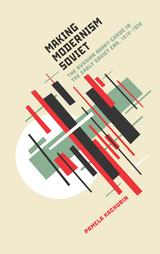 Making Modernism Soviet: The Russian Avant-Garde in the Early Soviet Era, 1918-1928
Pamela Kachurin
Northwestern University Press, 2013 Making Modernism Soviet provides a new understanding of the ideological engagement of Russian modern artists such as Kazimir Malevich, Alexander Rodchenko, and Vera Ermolaeva with the political and social agenda of the Bolsheviks in the chaotic years immediately following the Russian Revolution. Focusing on the relationship between power brokers and cultural institutions under conditions of state patronage, Pamela Kachurin lays to rest the myth of the imposition of control from above upon a victimized artistic community. Drawing on extensive archival research, she shows that Russian modernists used their positions within the expanding Soviet arts bureaucracy to build up networks of like-minded colleagues. Their commitment to one another and to the task of creating a socially transformative visual language for the new Soviet context allowed them to produce some of their most famous works of art. But it also contributed to the "Sovietization" of the art world that eventually sealed their fate.
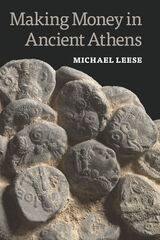 Making Money in Ancient Athens
Michael Leese
University of Michigan Press, 2021 Given their cultural, intellectual, and scientific achievements, surely the Greeks were able to approach their economic affairs in a rational manner like modern individuals? Since the nineteenth century, many scholars have argued that premodern people did not behave like modern businesspeople, and that the “stagnation” that characterized the economy prior to the Industrial Revolution can be explained by a prevailing noneconomic mentality throughout premodern (and nonwestern) societies. This view, which simultaneously extols the “sophistication” of the modern West, relegates all other civilizations to the status of economic backwardness. But the evidence from ancient Athens, which is one of the best-documented societies in the premodern world, tells a very different story: one of progress, innovation, and rational economic strategies. Making Money in Ancient Athens examines in the most comprehensive manner possible the voluminous source material that has survived from Athens in inscriptions, private lawsuit speeches, and the works of philosophers like Aristotle and Plato. Inheritance cases that detail estate composition and investment choices, and maritime trade deals gone wrong, provide unparalleled glimpses into the specific factors that influenced Athenians at the level of the economic decision-making process itself, and the motivations that guided the specific economic transactions attested in the source material. Armed with some of the most thoroughly documented case studies and the richest variety of source material from the ancient Greek world, Michael Leese argues that the evidence overwhelmingly demonstrates that ancient Athenians achieved the type of long-term profit and wealth maximization and continuous reinvestment of profits into additional productive enterprise that have been argued as unique to (and therefore responsible for) the modern industrial-capitalist system.
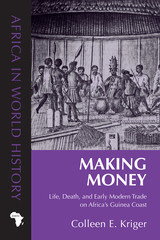 Making Money: Life, Death, and Early Modern Trade on Africa’s Guinea Coast
Colleen E. Kriger
Ohio University Press, 2017 A new era in world history began when Atlantic maritime trade among Africa, Asia, Europe, and the Americas opened up in the fifteenth century, setting the stage for massive economic and cultural change. In Making Money, Colleen Kriger examines the influence of the global trade on the Upper Guinea Coast two hundred years later—a place and time whose study, in her hands, imparts profound insights into Anglo-African commerce and its wider milieu. A stunning variety of people lived in this coastal society, struggling to work together across deep cultural divides and in the process creating a dynamic creole culture. Kriger digs further than any previous historian of Africa into the records of England’s Royal African Company to illuminate global trade patterns, the interconnectedness of Asian, African, and European markets, and—most remarkably—the individual lives that give Making Money its human scale. By inviting readers into the day-to-day workings of early modern trade in the Atlantic basin, Kriger masterfully reveals the rich social relations at its core. Ultimately, this accessible book affirms Africa’s crucial place in world history during a transitional period, the early modern era.
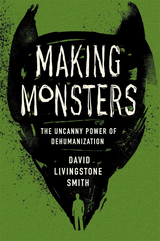 Making Monsters: The Uncanny Power of Dehumanization
David Livingstone Smith
Harvard University Press, 2021 Shortlisted for the Nayef Al-Rodhan Book Prize.
A leading scholar explores what it means to dehumanize others—and how and why we do it.
“I wouldn’t have accepted that they were human beings. You would see an infant who’s just learning to smile, and it smiles at you, but you still kill it.” So a Hutu man explained to an incredulous researcher, when asked to recall how he felt slaughtering Tutsis in Rwanda in 1994. Such statements are shocking, yet we recognize them; we hear their echoes in accounts of genocides, massacres, and pogroms throughout history. How do some people come to believe that their enemies are monsters, and therefore easy to kill?
In Making Monsters David Livingstone Smith offers a poignant meditation on the philosophical and psychological roots of dehumanization. Drawing on harrowing accounts of lynchings, Smith establishes what dehumanization is and what it isn’t. When we dehumanize our enemy, we hold two incongruous beliefs at the same time: we believe our enemy is at once subhuman and fully human. To call someone a monster, then, is not merely a resort to metaphor—dehumanization really does happen in our minds. Turning to an abundance of historical examples, Smith explores the relationship between dehumanization and racism, the psychology of hierarchy, what it means to regard others as human beings, and why dehumanizing others transforms them into something so terrifying that they must be destroyed.
Meticulous but highly readable, Making Monsters suggests that the process of dehumanization is deeply seated in our psychology. It is precisely because we are all human that we are vulnerable to the manipulations of those trading in the politics of demonization and violence.
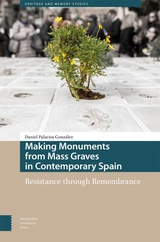 Making Monuments from Mass Graves in Contemporary Spain: Resistance through Remembrance
Daniel Palacios González
Amsterdam University Press, 2024 This book narrates how, beginning in 1936, bodies buried in mass graves during the Spanish War and subsequent dictatorship were turned into monuments. The book describes how the production of monuments evolved and what forms this process and these monuments took; it examines how the monuments were incorporated into society and used to influence public opinion; and it argues that this process was not simply based on the formal logic of tradition but instead reflected a conscious plan with a specific and rational end goal. As such, this book puts forward the idea that the monument as a material object became an expression of the historical consciousness of its producers, relating how different actors communicated their memories into meaningful gestures while limited by the material reality of integrating the bodies into a novel artefact. Finally, it contends that the people creating these monuments did not just bury their dead according to a funerary tradition but also sought to influence society.
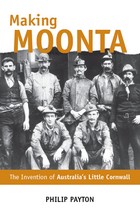 Making Moonta: The Invention of Australia's Little Cornwall
Philip Payton
University of Exeter Press, 2007
Winner of the 2008 Holyer An Gof Award for non-fiction. An investigation of the popular tradition of ‘Australia’s Little Cornwall’: how one town in South Australia gained and perpetuated this identity into the twenty-first century. This book is about Moonta and its special place in the Cornish transnational identity. Today Moonta is a small town on South Australia’s northern Yorke Peninsula; along with the neighbouring townships of of Wallaroo and Kadina, it is an agricultural and heritage tourism centre. In the second half of the nineteenth century, however, Moonta was the focus of a major copper mining industry.
This book is about Moonta and its special place in the Cornish transnational identity. Today Moonta is a small town on South Australia’s northern Yorke Peninsula; along with the neighbouring townships of of Wallaroo and Kadina, it is an agricultural and heritage tourism centre. In the second half of the nineteenth century, however, Moonta was the focus of a major copper mining industry.
From the beginning, Moonta cast itself as unique among Cornish immigrant communities, becoming ‘the hub of the universe’ according to its inhabitants, forging the myth of ‘Australia’s Little Cornwall’: a myth perpetuated by Oswald Pryor and others that survived the collapse of the copper mines in 1923—and remains vibrant and intact today.
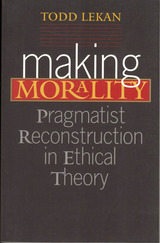 Making Morality: Pragmatist Reconstruction in Ethical Theory
Todd Lekan
Vanderbilt University Press, 2003 In this new contribution to moral theory, Todd Lekan argues for a pragmatist conception of morality as an evolving, educational, and fallible practice of everyday life. Drawing on the work of John Dewey, Lekan asserts that moral norms are neither timeless truths nor subjective whims, but habits transmitted through practices. Like the habits that make up medicine or engineering, moral habits are subject to rational evaluation and change according to new challenges and circumstances. This pragmatic interpretation of morality provides a way out of the conundrum of relativism and absolutism.
Building on classical American philosophy to address current philosophical concerns, Lekan's theory revises our basic understanding of moral life and the place of theorizing within that life. Making Morality will prove of great interest to ethical theorists, as it enjoins them to measure theoretical inquiries by how well they produce intellectual tools for problem-solving in dynamic, complex communities.
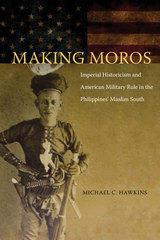 Making Moros: Imperial Historicism and American Military Rule in the Philippines' Muslim South
Michael Hawkins
Northern Illinois University Press, 2012
Making Moros offers a unique look at the colonization of Muslim subjects during the early years of American rule in the southern Philippines. Hawkins argues that the ethnological discovery, organization, and subsequent colonial engineering of Moros was highly contingent on developing notions of time, history, and evolution, which ultimately superseded simplistic notions about race. He also argues that this process was highly collaborative, with Moros participating, informing, guiding, and even investing in their configuration as modern subjects. Drawing on a wealth of archival sources from both the United States and the Philippines, Making Moros presents a series of compelling episodes and gripping evidence to demonstrate its thesis. Readers will find themselves with an uncommon understanding of the Philippines’ Muslim South beyond its usual tangential place as a mere subset of American empire.
 Making Movement Modern: Science, Politics, and the Body in Motion
Whitney E. Laemmli
University of Chicago Press, 2025 Explores how researchers used systems for recording human movement to navigate the relationship between mind and body, freedom and control, and the individual and the state.
In the early twentieth century, human bodily movement garnered interest among researchers who were convinced that understanding and controlling it could help govern an increasingly frazzled, fragmented world. Making Movement Modern traces one movement visualization technique, Labanotation, from its origins in expressionist dance, Austro-Hungarian military discipline, and contemporary physiology to its employment in factories and offices a half-century later. Frustrated by societies that seemed plagued by regimentation and alienation, the users of Laban-inspired systems—from artists and scientists to factory owners, politicians, lawyers, anthropologists, psychiatrists, and computer scientists—hoped to provide opportunities for individual expression while simultaneously harnessing movement to serve the needs of larger communities, businesses, and states.
Making Movement Modern reveals how Labanotation’s creator, choreographer Rudolf Laban, and his acolytes offered this system to a surprising variety of individuals and groups. It was a technique that promised liberation through expressive movement; it was also a means of organizing fascist displays of pure “Aryan” culture. The book explores these political ambiguities as Laban-based systems entered postwar society in the United States and the United Kingdom, where they were used to document disappearing folk cultures, treat Holocaust survivors, and make even the dullest, most repetitive work feel spiritually meaningful. Central to these efforts were vast programs to collect and store new kinds of personal movement data, and this history also has much to tell us about mass data collection today. This is a book for anyone interested in the relationship between art, science, data, and the human body across the tumultuous twentieth century.
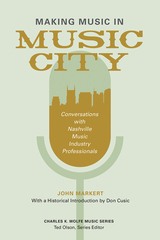 Making Music in Music City: Conversations with Nashville Music Industry Professionals
John Markert
University of Tennessee Press, 2021 At least since the rise of the “Nashville sound” in the 1950s, Tennessee’s capital city has attracted numerous books and articles offering insight into the celebrity machine known as Music City. But behind the artist in the limelight are a host of support personnel and contributors who shape the artist’s music. Of these myriad occupations within the music industry, only two have received significant attention: executives at the major labels and elite songwriters who have forged a path to the top of the charts. In Making Music in Music City, sociologist John Markert compiles and assesses more than one hundred interviews with industry professionals whose roles have been less often examined: producers, publishers, songwriters, management, studio musicians, and more.
The book naturally pivots around the country music industry but also discusses Nashville’s role in other forms of modern music, such as rock, Christian, and rap. Markert’s in-depth interviews with key music professionals provide a fresh perspective on the roles of critical players in Nashville’s music industry. This book sheds light not only on the complexities of the industry and the occupational changes taking place but on the critical role of those who work behind the scenes to shape the music that ultimately reaches the public.
Through firsthand accounts, Making Music in Music City analyzes just what it takes to create, produce, and disseminate the Nashville sound.
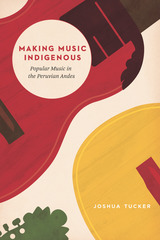 Making Music Indigenous: Popular Music in the Peruvian Andes
Joshua Tucker
University of Chicago Press, 2019 When thinking of indigenous music, many people may imagine acoustic instruments and pastoral settings far removed from the whirl of modern life. But, in contemporary Peru, indigenous chimaycha music has become a wildly popular genre that is even heard in the nightclubs of Lima. In Making Music Indigenous, Joshua Tucker traces the history of this music and its key performers over fifty years to show that there is no single way to “sound indigenous.” The musicians Tucker follows make indigenous culture and identity visible in contemporary society by establishing a cultural and political presence for Peru’s indigenous peoples through activism, artisanship, and performance. This musical representation of indigeneity not only helps shape contemporary culture, it also provides a lens through which to reflect on the country’s past. Tucker argues that by following the musicians that have championed chimaycha music in its many forms, we can trace shifting meanings of indigeneity—and indeed, uncover the ways it is constructed, transformed, and ultimately recreated through music.
 Making Muslim Women European: Voluntary Associations, Gender, and Islam in Post-Ottoman Bosnia and Yugoslavia (1878-1941)
Fabio Giomi
Central European University Press, 2021 This social, cultural, and political history of Slavic Muslim women of the Yugoslav region in the first decades of the post-Ottoman era is the first to provide a comprehensive overview of the issues confronting these women. It is based on a study of voluntary associations (philanthropic, cultural, Islamic-traditionalist, and feminist) of the period. It is broadly held that Muslim women were silent and relegated to a purely private space until 1945, when the communist state “unveiled” and “liberated” them from the top down. After systematic archival research in Bosnia, Croatia, Serbia, and Austria, Fabio Giomi challenges this view by showing: • How different sectors of the Yugoslav elite through association publications, imagined the role of Muslim women in post-Ottoman times, and how Muslim women took part in the construction or the contestation of these narratives. • How associations employed different means in order to forge a generation of “New Muslim Women” able to cope with the post-Ottoman political and social circumstances. • And how Muslim women used the tools provided by the associations in order to pursue their own projects, aims and agendas. The insights are relevant for today’s challenges facing Muslim women in Europe. The text is illustrated with exceptional photographs.T
 Making Myself at Home in a Nursing Home: Vanderbilt University Press
Sandra J. Gaffney
Vanderbilt University Press, 2012 Sandra Gaffney entered her first nursing home for long-term care at the unusually young age of fifty. Fourteen years earlier she had been diagnosed with amyotrophic lateral sclerosis (ALS), also known as Lou Gehrig's disease. Over the next sixteen years, Gaffney lived in nursing homes in Florida, Virginia, and Minnesota, as the ways she could be close to family changed.
She describes her situation in these words: "As a nursing home resident, I require total or maximum care. I have limited use of my hands and arms. With special splints, I am able to turn the pages of my books, use the telephone and TV/VCR/FM radio remote control. When my cup is positioned properly, I can drink independently. I am able to walk with a platform walker and the help of two nursing assistants. My walking is not functional; it is only for exercise. After I moved into my third nursing home, I learned to operate a power wheelchair by using an adaptive switch between my knees. ... All other areas of physical care have to be done for me. My speech is impaired. If people listen carefully, they can understand what I am saying. ... I am able to eat regular food and breathe on my own."
Gaffney became an acute observer and strategist about how to live in a nursing home. Her first-person account, dictated to family members and assistants, covers making the decision to enter a nursing home, choosing the right one, and understanding its culture. She talks about how to furnish your room and about all the issues that arise in a resident's typical day. She has much to say about communication with staff and family about "how to help others help me." Gaffney's daughters, Amy and Bridget, and her friend Ellen Potter provide additional perspectives on the caregiving experience.
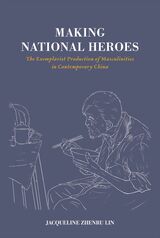 Making National Heroes: The Exemplarist Production of Masculinities in Contemporary China
Jacqueline Zhenru Lin
Hong Kong University Press, 2024 A study of the relationship between gender and war commemoration in China.
Making National Heroes is an ethnography on the making of national heroes in the commemoration of the Second World War in contemporary China. Foregrounding the lived experience of men and women who participate in commemorative activities, it theorizes how masculinity and nationalism entangle in recollecting war memories. Taking the line of feminist inquiry, this anthropological study aims to capture the significance of creating exemplars that are the realization of hegemonic masculinities. It adds a gendered perspective to studies on the exemplarist moral theory and theorizes exemplary men’s cross-culture significance in defining masculinities. Researchers in the fields of critical masculinity studies, anthropology, feminist methodology, China studies, and war memories will be interested in this book.
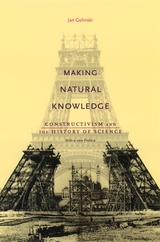 Making Natural Knowledge: Constructivism and the History of Science, with a new Preface
Jan Golinski
University of Chicago Press, 2005 Arguably the best available introduction to constructivism, a research paradigm that has dominated the history of science for the past forty years, Making Natural Knowledge reflects on the importance of this theory, tells the history of its rise to prominence, and traces its most important tensions.
Viewing scientific knowledge as a product of human culture, Jan Golinski challenges the traditional trajectory of the history of science as steady and autonomous progress. In exploring topics such as the social identity of the scientist, the significance of places where science is practiced, and the roles played by language, instruments, and images, Making Natural Knowledge sheds new light on the relations between science and other cultural domains.
"A standard introduction to historically minded scholars interested in the constructivist programme. In fact, it has been called the 'constructivist's bible' in many a conference corridor."—Matthew Eddy, British Journal for the History of Science
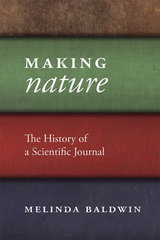 Making "Nature": The History of a Scientific Journal
Melinda Baldwin
University of Chicago Press, 2015 Making "Nature" is the first book to chronicle the foundation and development of Nature, one of the world's most influential scientific institutions. Now nearing its hundred and fiftieth year of publication, Nature is the international benchmark for scientific publication. Its contributors include Charles Darwin, Ernest Rutherford, and Stephen Hawking, and it has published many of the most important discoveries in the history of science, including articles on the structure of DNA, the discovery of the neutron, the first cloning of a mammal, and the human genome.
But how did Nature become such an essential institution? In Making "Nature," Melinda Baldwin charts the rich history of this extraordinary publication from its foundation in 1869 to current debates about online publishing and open access. This pioneering study not only tells Nature's story but also sheds light on much larger questions about the history of science publishing, changes in scientific communication, and shifting notions of "scientific community." Nature, as Baldwin demonstrates, helped define what science is and what it means to be a scientist.
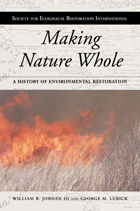 Making Nature Whole: A History of Ecological Restoration
William R. Jordan III and George M. Lubick
Island Press, 2011 Making Nature Whole is a seminal volume that presents an in-depth history of the field of ecological restoration as it has developed in the United States over the last three decades. The authors draw from both published and unpublished sources, including archival materials and oral histories from early practitioners, to explore the development of the field and its importance to environmental management as well as to the larger environmental movement and our understanding of the world. Considering antecedents as varied as monastic gardens, the Scientific Revolution, and the emerging nature-awareness of nineteenth-century Romantics and Transcendentalists, Jordan and Lubick offer unique insight into the field's philosophical and theoretical underpinnings. They examine specifically the more recent history, including the story of those who first attempted to recreate natural ecosystems early in the 20th century, as well as those who over the past few decades have realized the value of this approach not only as a critical element in conservation but also as a context for negotiating the ever-changing relationship between humans and the natural environment. Making Nature Whole is a landmark contribution, providing context and history regarding a distinctive form of land management and giving readers a fascinating overview of the development of the field. It is essential reading for anyone interested in understanding where ecological restoration came from or where it might be going.
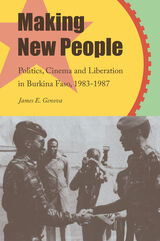 Making New People: Politics, Cinema, and Liberation in Burkina Faso, 1983–1987
James Genova
Michigan State University Press, 2022 On August 4, 1983, Captain Thomas Sankara led a coalition of radical military officers, communist activists, labor leaders, and militant students to overtake the government of the Republic of Upper Volta. Almost immediately following the coup’s success, the small West African country—renamed Burkina Faso, or Land of the Dignified People—gained international attention as it charted a new path toward social, economic, cultural, and political development based on its people’s needs rather than external pressures and Cold War politics. James E. Genova’s Making New People: Politics, Cinema, and Liberation in Burkina Faso, 1983–1987 recounts in detail the revolutionary government’s rise and fall, demonstrating how it embodied the critical transition period in modern African history between the era of decolonization and the dawning of neoliberal capitalism. It also uncovers one of the revolution’s most enduring and significant aspects: its promotion of film as a vehicle for raising the people’s consciousness, inspiring their efforts at social transformation, and articulating a new self-generated image of Africa and Africans. Foregrounding film and drawing evocative connections between Sankara’s political philosophy and Frantz Fanon, Making New People provides a deeply nuanced explanation for the revolution’s lasting influence throughout Africa and the world.
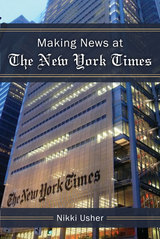 Making News at The New York Times
Nikki Usher
University of Michigan Press, 2014 Making News at The New York Times is the first in-depth portrait of the nation’s, if not the world's, premier newspaper in the digital age. It presents a lively chronicle of months spent in the newsroom observing daily conversations, meetings, and journalists at work. We see Page One meetings, articles developed for online and print from start to finish, the creation of ambitious multimedia projects, and the ethical dilemmas posed by social media in the newsroom. Here, the reality of creating news in a 24/7 instant information environment clashes with the storied history of print journalism, and the tensions present a dramatic portrait of news in the online world. This news ethnography brings to bear the overarching value clashes at play in a digital news world. The book argues that emergent news values are reordering the fundamental processes of news production. Immediacy, interactivity, and participation now play a role unlike any time before, creating clashes between old and new. These values emerge from the social practices, pressures, and norms at play inside the newsroom as journalists attempt to negotiate the new demands of their work. Immediacy forces journalists to work in a constant deadline environment, an ASAP world, but one where the vaunted traditions of yesterday's news still appear in the next day's print paper. Interactivity, inspired by the new user-computer directed capacities online and the immersive Web environment, brings new kinds of specialists into the newsroom, but exacts new demands upon the already taxed workflow of traditional journalists. And at time where social media presents the opportunity for new kinds of engagement between the audience and media, business executives hope for branding opportunities while journalists fail to truly interact with their readers.
 The Making of a Black Communist: The Selected Writings of Eugene Gordon
Louis J. Parascandola, Editor
University of Massachusetts Press, 2025 Eugene Gordon (1891–1974) was a major writer involved in the development of the burgeoning Black literary scene in Boston in the 1920s, an active player in the Harlem Renaissance, and a longtime member of the Communist Party. Despite his credentials as a reporter, editor, fiction writer, and political activist, he is rarely mentioned in studies of the Harlem Renaissance or Marxist politics. Here, Louis J. Parascandola has pulled together Gordon’s journalism, autobiographical writing, and fiction. This new collection, featuring both previously published pieces from a wide variety of publications as well as material that has never before been published, demonstrates his range and his skill while establishing his importance as a critical voice of his time.
Gordon was born and raised in the South but made his way north at a young age. In Boston, he founded the Saturday Evening Quill Club, an African American literary group that included other notable writers such as Helene Johnson and Dorothy West. He later became editor of and contributor to two major publications coming out of the era: the Messenger and Opportunity: A Journal of Negro Life. As he grew more political, he joined the Communist Party in the 1930s and became editor of and contributor to the New Masses. Scholars looking to research him have struggled to find disparate writings to get a fuller sense of his literary stylings as well as his political commitments. This welcome new volume establishes Gordon as a significant, understudied figure.
 The Making of a Black Scholar: From Georgia to the Ivy League
Horace A. Porter
University of Iowa Press, 2003 This captivating and illuminating book is a memoir of a young black man moving from rural Georgia to life as a student and teacher in the Ivy League as well as a history of the changes in American education that developed in response to the civil rights movement, the war in Vietnam, and affirmative action. Born in 1950, Horace Porter starts out in rural Georgia in a house that has neither electricity nor running water. In 1968, he leaves his home in Columbus, Georgia—thanks to an academic scholarship to Amherst College—and lands in an upper-class, mainly white world. Focusing on such experiences in his American education, Porter's story is both unique and representative of his time.
The Making of a Black Scholar is structured around schools. Porter attends Georgia's segregated black schools until he enters the privileged world of Amherst College. He graduates (spending one semester at Morehouse College) and moves on to graduate study at Yale. He starts his teaching career at Detroit's Wayne State University and spends the 1980s at Dartmouth College and the 1990s at Stanford University. Porter writes about working to establish the first black studies program at Amherst, the challenges of graduate study at Yale, the infamous Dartmouth Review, and his meetings with such writers and scholars as Ralph Ellison, Tillie Olsen, James Baldwin, and Henry Louis Gates, Jr. He ends by reflecting on an unforeseen move to the University of Iowa, which he ties into a return to the values of his childhood on a Georgia farm. In his success and the fulfillment of his academic aspirations, Porter represents an era, a generation, of possibility and achievement.
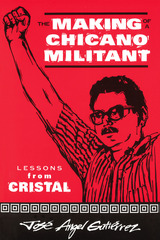 The Making of a Chicano Militant: Lessons from Cristal
Jose Angel Gutierrez
University of Wisconsin Press, 1999 Texas, for years, was a one-party state controlled by white democrats. In 1962, a young eighteen-year-old heard the first rumblings of Chicano community organization in the barrios of Cristal. The rumor in the town was that five Mexican Americans were going to run for all five seats on the city council. But first, poor citizens had to find a way to pay the $1.75 poll tax. Money had to be raised—through bake sales of tamales, cake walks, and dances. So began the political activism of José Angel Gutiérrez.
Gutiérrez's autobiography, The Making of a Chicano Militant, is the first insider's view of the important political and social events within the Mexican American communities in South Texas during the 1960s and 1970s. A controversial and dynamic political figure during the height of the Chicano movement, Gutiérrez offers an absorbing personal account of his life at the forefront of the Mexican-American civil rights movement—first as a Chicano and then as a militant.
Gutiérrez traces the racial, ethnic, economic, and social prejudices facing Chicanos with powerful scenes from his own life: his first summer job as a tortilla maker at the age of eleven, his racially motivated kidnapping as a teenager, and his coming of age in the face of discrimination as a radical organizer in college and graduate school. When Gutiérrez finally returned to Cristal, he helped form the Mexican American Youth Organization and, subsequently the Raza Unida Party to confront issues of ethnic intolerance in his community. His story is soon to be a classic in the developing literature of Mexican American leaders.
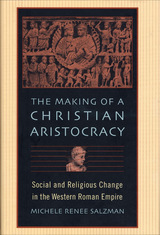 The Making of a Christian Aristocracy: Social and Religious Change in the Western Roman Empire
Michele Renee Salzman
Harvard University Press, 2002 What did it take to cause the Roman aristocracy to turn to Christianity, changing centuries-old beliefs and religious traditions? Michele Salzman takes a fresh approach to this much-debated question. Focusing on a sampling of individual aristocratic men and women as well as on writings and archeological evidence, she brings new understanding to the process by which pagan aristocrats became Christian, and Christianity became aristocratic.
Roman aristocrats would seem to be unlikely candidates for conversion to Christianity. Pagan and civic traditions were deeply entrenched among the educated and politically well-connected. Indeed, men who held state offices often were also esteemed priests in the pagan state cults: these priesthoods were traditionally sought as a way to reinforce one’s social position. Moreover, a religion whose texts taught love for one’s neighbor and humility, with strictures on wealth and notions of equality, would not have obvious appeal for those at the top of a hierarchical society. Yet somehow in the course of the fourth and early fifth centuries Christianity and the Roman aristocracy met and merged.
Examining the world of the ruling class—its institutions and resources, its values and style of life—Salzman paints a fascinating picture, especially of aristocratic women. Her study yields new insight into the religious revolution that transformed the late Roman Empire.
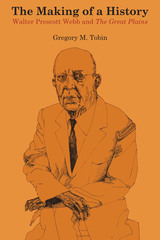 The Making of a History: Walter Prescott Webb and The Great Plains
By Gregory M. Tobin
University of Texas Press, 1976 Walter Prescott Webb became one of the best known interpreters of the American West following the publication of The Great Plains in 1931. That book remained one of the outstanding studies of the region for decades and attracted considerable attention over the years for its unusual emphasis on the impact of geographic factors on the process of settlement. Using manuscript sources, some of which had not previously been available, Gregory M. Tobin has traced the elements that went into the planning and writing of The Great Plains and that account for its distinctive approach to the writing of a regional history. Tobin emphasizes two aspects of Webb's life that molded the historian's outlook: his early family life and community connections in West Texas and his admiration for the ideas of scholar Lindley Miller Keasbey. Webb reacted strongly against the assumption that the only cultural values of any real worth emanated from the urban and sophisticated East; he was determined to write the history of his own people in a way that would reveal the scale of their anonymous contribution to American civilization. By reverting to Keasbey's stress on the relationship between natural environment and social institutions, Webb broadened his study to take in what he believed to be a distinct geographic environment. The result was The Great Plains, an assertion of individual and regional identity by a man with a personal stake in establishing the image of a distinctive Plains civilization. Although The Making of a History is not a full biography of Walter Prescott Webb, it is the first biographically oriented study of a man regarded as one of the twentieth century's major western historians. It places his development within the framework of his intellectual and social setting and, in a sense, subjects his career to the same type of scrutiny that he advocated as the basis of the study of evolving cultures.
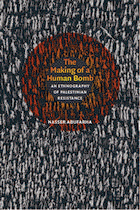 The Making of a Human Bomb: An Ethnography of Palestinian Resistance
Nasser Abufarha
Duke University Press, 2009 In The Making of a Human Bomb, Nasser Abufarha, a Palestinian anthropologist, explains the cultural logic underlying Palestinian martyrdom operations (suicide attacks) launched against Israel during the Al-Aqsa Intifada (2000–06). In so doing, he sheds much-needed light on how Palestinians have experienced and perceived the broader conflict. During the Intifada, many of the martyrdom operations against Israeli targets were initiated in the West Bank town of Jenin and surrounding villages. Abufarha was born and raised in Jenin. His personal connections to the area enabled him to conduct ethnographic research there during the Intifada, while he was a student at a U.S. university. Abufarha draws on the life histories of martyrs, interviews he conducted with their families and members of the groups that sponsored their operations, and examinations of Palestinian literature, art, performance, news stories, and political commentaries. He also assesses data—about the bombers, targets, and fatalities caused—from more than two hundred martyrdom operations carried out by Palestinian groups between 2001 and 2004. Some involved the use of explosive belts or the detonation of cars; others entailed armed attacks against Israeli targets (military and civilian) undertaken with the intent of fighting until death. In addition, he scrutinized suicide attacks executed by Hamas and Islamic Jihad between 1994 and 2000. In his analysis of Palestinian political violence, Abufarha takes into account Palestinians’ understanding of the history of the conflict with Israel, the effects of containment on Palestinians’ everyday lives, the disillusionment created by the Oslo peace process, and reactions to specific forms of Israeli state violence. The Making of a Human Bomb illuminates the Palestinians’ perspective on the conflict with Israel and provides a model for ethnographers seeking to make sense of political violence.
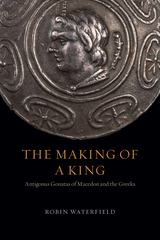 The Making of a King: Antigonus Gonatas of Macedon and the Greeks
Robin Waterfield
University of Chicago Press, 2021 In the third century BCE, the ancient kingdom of Macedon held dominion over mainland Greece, but it was rapidly descending into chaos. After Alexander the Great’s death, several of his successors contended for the Macedonian throne, and amid the tumult the Celts launched a massive invasion, ravaging and plundering Macedon and northern Greece for years. The Celts finally met their defeat at the hands of Antigonus Gonatas, son of one of Alexander’s successors. An exceptional statesman and artful strategist, Antigonus protected Macedon and its Greek territories against aggressors coming from every direction. After almost fifty years of chaos brought on by Alexander’s death, Antigonus stabilized Macedon and Greece and laid the foundation for a long but troubled reign.
In this book, distinguished historian Robin Waterfield draws on his deep understanding of Greek history to bring us into the world of this complicated, splintered empire. He shows how, while Antigonus was confirming his Macedonian rule through constitutional changes, the Greeks were making moves toward independence. Two great confederacies of Greek cities emerged, forming powerful blocs that had the potential to resist the power of Macedon. The Making of a King charts Antigonus’s conflicts with the Greeks and with his perennial enemy, Ptolemy of Egypt. But Antigonus’s diplomatic and military successes were not enough to secure peace, and in his final years he saw his control of Greece whittled away by rebellion and the growing power of the Greek confederacies. Macedon’s lack of firm control over Greece ultimately made it possible for Rome to take its place as the arbiter of the Greeks’ future.
The Making of a King is Waterfield’s third volume about the Greeks in the era after Alexander the Great. Completing the story begun in his previous two books, Dividing the Spoils and Taken at the Flood, it brings Antigonus and his turbulent era to life. With The Making of a King—the first book in more than a century to tell in full the story of Antigonus Gonatas’s reign—this fascinating figure finally receives his due.
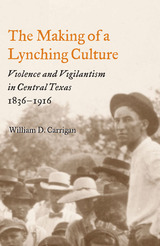 The Making of a Lynching Culture: Violence and Vigilantism in Central Texas, 1836-1916
William D. Carrigan
University of Illinois Press, 2006 How a culture of violence legitimized lynching among ordinary people On May 15, 1916, a crowd of fifteen thousand witnessed the lynching of an eighteen-year-old black farm worker named Jesse Washington. Most central Texans of the time failed to call for the punishment of the mob’s leaders. In The Making of a Lynching Culture, now in paperback, William D. Carrigan seeks to explain not how a fiendish mob could lynch one man but how a culture of violence that nourished this practice could form and endure for so long among ordinary people. Beginning with the 1836 independence of Texas, The Making of a Lynching Culture reexamines traditional explanations of lynching, including the role of the frontier, economic tensions, and political conflicts. Using a voluminous body of court records, newspaper accounts, oral histories, and other sources, Carrigan shows how notions of justice and historical memory were shaped to glorify violence and foster a culture that legitimized lynching.
The Making of a Mexican American Mayor
Mario Garcia
University of Arizona Press, 1999 Raymond Telles was the first Mexican American mayor of El Paso, Texas, and the most significant Mexican American of his time. This book details his political career from 1948, when he won a hotly contested election for county clerk, to his ambassadorship to Costa Rica.
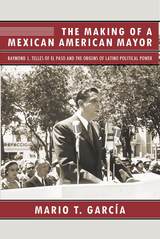 The Making of a Mexican American Mayor: Raymond L. Telles of El Paso and the Origins of Latino Political Power
Mario T. García
University of Arizona Press, 2018 Raymond L. Telles was the first Mexican American mayor of a major U.S. city. Elected mayor of El Paso in 1957 and serving for two terms, he went on to become the first Mexican American ambassador in U.S. history, heading the U.S. delegation to Costa Rica. Historian Mario T. García brings Telles’s remarkable story to life in this newly updated edition of his pioneering biography, The Making of a Mexican American Mayor.
In the border metropolis of El Paso, more than half the population is Mexican American, yet this group had been denied effective political representation. Mexican Americans broke this barrier and achieved the “politics of status” through Telles’s stunning 1957 victory. This book captures the excitement of that long-awaited election.
The Making of a Mexican American Mayor also examines Telles’s story as a microcosm of the history of Mexican Americans before and after World War II—the Mexican American Generation. As mayor and ambassador, Telles symbolized this generation’s striving for political participation, and his legacy is evident in the growing number of Latinas/os holding office today.
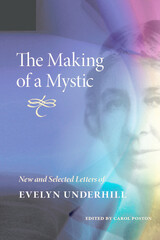 The Making of a Mystic: New and Selected Letters of Evelyn Underhill
Evelyn Underhill. Edited by Carol Poston.
University of Illinois Press, 2010 Evelyn Underhill (1875-1941) achieved international fame with the publication of her book Mysticism in 1911. Continuously in print since its original publication, Mysticism remains Underhill's most famous work, but in the course of her long career she published nearly forty books, including three novels and three volumes of poetry, as well as numerous poems in periodicals. She was the religion editor for Spectator, a friend of T. S. Eliot (her influence is visible in his last masterpiece, Four Quartets), and the first woman invited to lecture on theology at Oxford University. Her interest in religion extended beyond her Anglican upbringing to embrace the world's religions and their common spirituality. In time for the centennial celebration of her classic Mysticism, this volume of Underhill's letters will enable readers and researchers to follow her as she reconciled her beliefs with her daily life. The letters reveal her personal and theological development and clarify the relationships that influenced her life and work. Hardly aloof, she enjoyed the interests, mirth, and compassion of close friendships. Drawing from collections previously unknown to scholars, The Making of a Mystic shows the range of Evelyn Underhill's mind and interests as well as the immense network of her correspondents, including Sir James Frazier and Nobel Prize laureate Rabindranath Tagore. This substantial selection of Underhill's correspondence demonstrates an exceptional scope, beginning with her earliest letters from boarding school to her mother and extending to a letter written to T. S. Eliot from what was to be her deathbed in London in 1941 as the London Blitz raged around her.
 The Making of a Nation in the Balkans
Roumen Daskalov
Central European University Press, 2004 The nineteenth century was the epoch of nation building for the Bulgarians under Ottoman rule. In this book, comparisons and analogies are made between the Bulgarian Revival and other regions, epochs, ideological trends, and events. These latter are taken from two major areas—Western Europe ("Renaissance," "Enlightenment," "Romanticism," the French Revolution, and national liberation movements), and Russia (the "agrarian question," "populism" and "utopian socialism," "revolutionary democrats," and the Russian Revolution of 1905). Historical facts about the Revival were instrumentalized for political purposes, such as the fostering of national and state loyalties through the reproduction of identities, or, directly, as the legitimating/contesting of a current political regime under the guise of disputes over historical legacy. Ideological mobilization took place in the form of nationalism, right-wing authoritarianism (shading into fascism), and communism. The author sets in relief some of the mechanisms and logic of the two grand narratives under the sign of nationalism, and of Marxism.
The Making of a Sage: A Study in Rabbinic Ethics
Jonathan Wyn Schofer
University of Wisconsin Press, 2005 Jonathan Schofer offers the first theoretically framed examination of rabbinic ethics in several decades. Centering on one large and influential anthology, The Fathers According to Rabbi Nathan, Jonathan Schofer situates that text within a broader spectrum of rabbinic thought, while at the same time bringing rabbinic thought into dialogue with current scholarship on the self, ethics, theology, and the history of religions.
Notable Selection, Jordan Schnitzer Book Award for Philosophy and Jewish Thought, Association for Jewish Studies
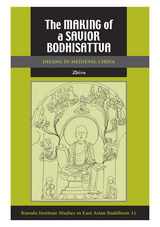 The Making of a Savior Bodhisattva: Dizang in Medieval China
Zhiru
University of Hawaii Press, 2007 In modern Chinese Buddhism, Dizang is especially popular as the sovereign of the underworld. Often represented as a monk wearing a royal crown, Dizang helps the deceased faithful navigate the complex underworld bureaucracy, avert the punitive terrors of hell, and arrive at the happy realm of rebirth. The author is concerned with the formative period of this important Buddhist deity, before his underworldly aspect eclipses his connections to other religious expressions and at a time when the art, mythology, practices, and texts of his cult were still replete with possibilities. She begins by problematizing the reigning model of Dizang, one that proposes an evolution of gradual sinicization and increasing vulgarization of a relatively unknown Indian bodhisattva, Ksitigarbha, into a Chinese deity of the underworld. Such a model, the author argues, obscures the many-faceted personality and iconography of Dizang. Rejecting it, she deploys a broad array of materials (art, epigraphy, ritual texts, scripture, and narrative literature) to recomplexify Dizang and restore (as much as possible from the fragmented historical sources) what this figure meant to Chinese Buddhists from the sixth to tenth centuries.
Rather than privilege any one genre of evidence, the author treats both material artifacts and literary works, canonical and noncanonical sources. Adopting an archaeological approach, she excavates motifs from and finds resonances across disparate genres to paint a vibrant, detailed picture of the medieval Dizang cult. Through her analysis, the cult, far from being an isolated phenomenon, is revealed as integrally woven into the entire fabric of Chinese Buddhism, functioning as a kaleidoscopic lens encompassing a multivalent religio-cultural assimilation that resists the usual bifurcation of doctrine and practice or "elite" and "popular" religion.
The Making of a Savior Bodhisattva presents a fascinating wealth of material on the personality, iconography, and lore associated with the medieval Dizang. It elucidates the complex cultural, religious, and social forces shaping the florescence of this savior cult in Tang China while simultaneously addressing several broader theoretical issues that have preoccupied the field. Zhiru not only questions the use of sinicization as a lens through which to view Chinese Buddhist history, she also brings both canonical and noncanonical literature into dialogue with a body of archaeological remains that has been ignored in the study of East Asian Buddhism.
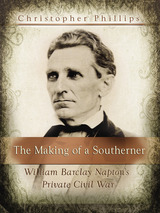 The Making of a Southerner: William Barclay Napton's Private Civil War
Christopher Phillips
University of Missouri Press, 2008 Christopher Phillips has brought to life a man, a story, and a voice lost in the din of competing post–Civil War narratives that each claim a timeless divide between North and South. William Barclay Napton (1808–1883) was an editor, lawyer, and state supreme court justice who lived in Missouri during the tumultuous American nineteenth century. He was a keen observer of the nation’s sectional politics just as he was a participant in those of his border state, the most divided of any in the nation, in the decades surrounding the Civil War. This book tells the story of one man’s civil war, lived and waged within the broader conflict, and the long shadows both cast. But Napton’s story moves beyond the Civil War just as it transcends the formal political realm. His is a fascinating tale of identity politics and their shifting currents, by which the highly educated former New Jerseyite became the owner or trustee of nearly fifty slaves and one of the most committed and thoughtful of the nation’s proslavery ideologues. That a “northerner” could make such a life transition in the Border West suggests more than the powerful nature of slavery in antebellum American society. Napton’s story offers provocative insights into the process of southernization, one driven more by sectional ideology and politics than by elements of a distinctive southern culture. Although Napton’s tragic Civil War experience was a watershed in his southern evolution, that evolution was completed only after he had constructed a politicized memory of the bitter conflict, one that was suffered nowhere worse than in Missouri. This war-driven transformation ultimately defined him and his family, just as it would his border state and region for decades to come. By suffering for the South, losing family and property in his defense of its ideals and principles, he claimed by right what he could not by birth. Napton became a southerner by choice. Drawn from incomparable personal journals kept for more than fifty years and from voluminous professional and family correspondence, Napton’s life story offers a thoughtful and important perspective on the key issues and events that turned this northerner first into an avowed proslavery ideologue and then into a full southerner. As a prominent jurist who sat on Missouri’s high bench for more than a quarter century, he used his politicized position to give birth to the New South in the Old West. Students, teachers, and general readers of southern history, western history, and Civil War history will find this book of particular interest.
The Making of a Terrorist: On Classic German Rogues
Jeffrey Champlin
Northwestern University Press, 2014 In The Making of a Terrorist, Jeffrey Champlin examines key figures from three canonical texts from the German-language literature of the late eighteenth and early nineteenth centuries: Goethe’s Gotz von Berlichingen, Schiller’s Die Rauber, and Kleist’s Michael Kohlhaas. Champlin situates these readings within a larger theoretical and historical context, exploring the mechanics, aesthetics, and poetics of terror while explicating the emergence of the terrorist personality in modernity. In engaging and accessible prose, Champlin explores the ethical dimensions of violence and interrogates an ethics of textual violence.
The Making of Adolf Hitler: The Birth and Rise of Nazism
Eugene Davidson
University of Missouri Press, 1997 The harsh Armistice terms of 1918, the short-lived Weimar Republic, Hindenburg's senile vacillations, and behind-the-scene power plays form the backbone of this excellent study covering German history during the first three-and-a-half decades of the century.
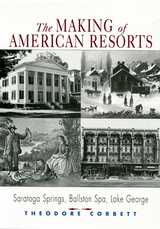 The Making of American Resorts: Saratoga Springs, Ballston Spa, and Lake George
Corbett, Theodore
Rutgers University Press, 2001 What factors create a successful resort? How did the rise of lavish hotels and spas reflect the changing values of American society as the nineteenth century progressed? Historians have argued that resorts were created to meet the demands of a leisured social elite. Theodore Corbett offers a fresh, compelling argument, demonstrating that resorts created and re-created themselves to keep pace with changing times. Success came with anticipating demands, not just reacting to them.
Using an impressive variety of historical documents, Corbett focuses on the conditions underlying the rise—and the demise—of the resorts at Ballston Spa and Caldwell on Lake George. Both towns’ major landlord–developers saw tourism as only one vehicle that could lead to success. As a result of their divided policies, neither town invested in the proper infrastructure to make tourism an immediate succes. Both places were soon overshadowed by Saratoga Springs, which became the premier resort of the upper and middle class.
Due to complex interwoven influences, Saratoga Springs was able to supply the amenities needed to attract and retain the patronage of the well heeled. The town provided visitors with lavish hotels, parks, public squares, pleasure gardens, and convenient service alleys. Saratoga Springs also had a work force that was available for the five-month period per year that the spas were active. Corbett examines the history and participation of various ethnic groups in the resort’s service sector: African Americans, Irish, and Native Americans.
Corbett also stresses middle-class America’s emulation of the leisure habits of the English aristocracy. Even though these pursuits (hunting, fishing, horse racrting) were dominaterd by men, social rituals were dominated by women, and resorts that accommodated “public domesticity” thrived as the century progressed. The Making of American Resorts offers a window into shifting public values and the structure of commercial tourism.
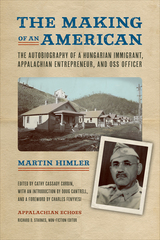 The Making of an American: The Autobiography of a Hungarian Immigrant, Appalachian Entrepreneur, and OSS Officer
Cathy Cassady Corbin
University of Tennessee Press, 2018 Martin Himler emigrated from Hungary to America in 1907, and he arrived in New York City with no money and no plan other than to find work. From these impoverished beginnings, Himler persevered to become a self-made new American. As a coal mining entrepreneur, he established the Himler Coal Company—a bold experiment in a worker-owned mine—founded the small town of Himlerville, Kentucky—a town almost completely populated by Hungarian immigrants—and founded and edited a weekly newspaper, the Magyar Bányászlap (Hungarian Miners’ Journal). During WWII, Himler was called by the United States government to work for the Office of Strategic Services (OSS). Colonel Himler arrested more than 300 Nazi war criminals and interrogated 40 himself.
Himler’s autobiography tells in Himler’s own words his life story as it evolves into the American dream, wherein hard work results in success. Himler captivates readers from his earliest memories of his childhood in Hungary to his experiences with the OSS.
Following Himler’s death, the manuscript of the autobiography was passed down among Himler family members and then donated to the Martin County Historical and Genealogical Society, Inez, Kentucky, in 2007. Editor Cathy Cassady Corbin’s annotations enhance Himler’s words, while the introduction by scholar Doug Cantrell provides historical context for Himler’s migration to Appalachia. Finally, Charles Fenyvesi’s foreword analyzes Himler’s courageous OSS work.
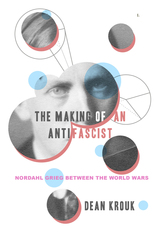 The Making of an Antifascist: Nordahl Grieg between the World Wars
Dean Krouk
University of Wisconsin Press, 2022 A young imperialist adventurer turned hero of the anti-Nazi resistance, Norwegian journalist, poet, and playwright Nordahl Grieg has become more of a national legend than a real person since his death as a war reporter in Berlin in 1943. A look into Grieg’s intellectual development during the dynamic interwar period sheds light on the political and cultural ideologies that competed in a turbulent Europe. Often portrayed with an emphasis on his humanist and pacifist positions, this antifascist figure becomes more complex in his writings, which reveal shifting allegiances, including an unsavory period as a rigid Stalinist.
In this comprehensive and accessible book, Dean Krouk examines a significant public figure in Scandinavian literature and a critical period in modern European history through original readings of the political, ethical, and gender issues in Grieg’s works. This volume offers a first-rate analysis of the interwar period’s political and cultural agendas in Scandinavia and Europe leading to the Second World War by examining the rise of fascism, communism, and antifascism. Grieg’s poetry found renewed resonance in Norway following the 2011 far-right domestic terrorist attacks, making insight into his contradictory ideas more crucial than ever. Krouk’s presentation of Grieg’s unexpected ideological tensions will be thought-provoking for many readers in the United States and elsewhere.
 The Making of an Artist: Desire, Courage, and Commitment
Kristin G. Congdon
Intellect Books, 2018 What drives an artist to create? And are there common traits that successful artists possess? In The Making of an Artist, Kristin G. Congdon draws on her years of studying and teaching art at all levels—from universities to correctional settings—to identify three traits that are regularly found in successful artists: desire, courage, and commitment. In this collection Congdon explores each of those traits, as well as giving ethnographic case studies of six visual artists from diverse backgrounds and locations whose practices embody them. Marrying the work of biography, journalism, sociology, and psychology, the book opens up the often mysterious process of making art, showing us how those characteristics play into it, as well as how other factors, such as trauma, madness, class, and gender, affect the ways that people approach the creative process.
Powerfully insightful and fully accessible, The Making of an Artist will be an invaluable resource for practicing artists, those just setting out on artistic careers, and art teachers alike.
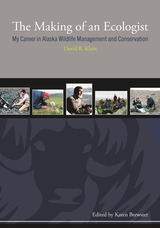 The Making of an Ecologist: My Career in Alaska Wildlife Management and Conservation
David R. Klein
University of Alaska Press, 2019 This is an innovative and collaborative life history of one of Alaska’s pioneering wildlife biologists. David R. Klein has been a leader in promoting habitat studies across wildlife research in Alaska, and this is his first-hand account of how science and biological fieldwork has been carried out in Alaska in the last sixty years. This book tells the stories of how Klein did his science and the inspiration behind the research, while exposing the thinking that underlies particular scientific theories. In addition, this book shows the evolution of Alaska’s wildlife management regimes from territorial days to statehood to the era of big oil.
The first portion of the book is comprised of stories from Klein’s life collected during oral history interviews, while the latter section contains essays written by Klein about philosophical topics of importance to him, such as eco-philosophy, the definition of wilderness, and the morality of hunting.
Many of Klein’s graduate students have gone on to become successful wildlife managers themselves, in Alaska and around the globe. Through The Making of an Ecologist, Klein’s outlook, philosophy, and approach toward sustainability, wildlife management, and conservation can now inspire even more readers to ensure the survival of our fragile planet in an ever-changing global society.
 The Making of an Insurrection: Parisian Sections and the Gironde
Morris Slavin
Harvard University Press, 1986 The insurrection of 31 May-2 June 1793 that overthrew the Girondins and brought the Montagnards to power was a decisive event in the history of the French Revolution. Morris Slavin's study is the first that discusses the background, the mechanisms, and the immediate results of the uprising, as well as the hidden forces that produced it and the contradictions that were inherent in it from the beginning.
Slavin's approach to the controversy between the Gironde and the Mountain is from below (d'en bas), from the vantage point of the sections of Paris and their extralegal assembly, the Eveche assembly, and its Comite des Neuf. He shows how and why the Montagnards used the insurrectionary organs created by the sans-culottes for their own purposes, and how the Montagnards won them over against their Girondin enemies by granting the sans-culottes economic concessions, at the same time disarming them politically.
This revelation of the profound differences between the sans-culottes and the Montagnards on the goals of the insurrection is a major contribution to understanding French revolutionary behavior. Slavin finds that the rank and file in the pro-Girondin sections were just as self-sacrificing and just as patriotic as the followers of the Mountain. The dispute between the Girondins and the Montagnards was an intraclass contest, not a class struggle.
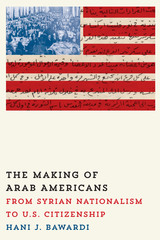 The Making of Arab Americans: From Syrian Nationalism to U.S. Citizenship
By Hani J. Bawardi
University of Texas Press, 2014 While conventional wisdom points to the Arab-Israeli War of 1967 as the gateway for the founding of the first Arab American national political organization, such advocacy in fact began with the Syrian nationalist movement, which emerged from immigration trends at the turn of the last century. Bringing this long-neglected history to life, The Making of Arab Americans overturns the notion of an Arab population that was too diverse to share common goals. Tracing the forgotten histories of the Free Syria Society, the New Syria Party, the Arab National League, and the Institute of Arab American Affairs, the book restores a timely aspect of our understanding of an area (then called Syria) that comprises modern-day Syria, Lebanon, Jordan, Israel, and Palestine. Hani Bawardi examines the numerous Arab American political advocacy organizations that thrived before World War I, showing how they influenced Syrian and Arab nationalism. He further offers an in-depth analysis exploring how World War II helped introduce a new Arab American identity as priorities shifted and the quest for assimilation intensified. In addition, the book enriches our understanding of the years leading to the Cold War by tracing both the Arab National League’s transition to the Institute of Arab American Affairs and new campaigns to enhance mutual understanding between the United States and the Middle East. Illustrated with a wealth of previously unpublished photographs and manuscripts, The Making of Arab Americans provides crucial insight for contemporary dialogues.
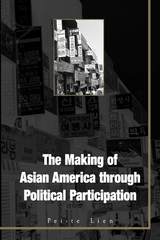 Making Of Asian America: Through Political Participation
Pei-te Lien
Temple University Press, 2001 Asian Americans are widely believed to be passive and compliant participants in the U.S. political process—if they participate at all. In this ground-breaking book, Pei-te Lien maps the actions and strategies of Asian Americans as they negotiate a space in the American political arena.
Professor Lien looks at political participation by Asian Americans prior to 1965 and then examines, at both organizational and mass politics levels, how race, ethnicity, and transnationalism help to construct a complex American electorate. She looks not only at rates of participation among Asian Americans as compared with blacks, Latinos, American Indians, and non-Hispanic whites, but also among specific groups of Asian Americans—Chinese, Japanese, Filipinos, Koreans, Asian Indians, and Vietnamese. She also discusses how gender, socioeconomic class, and place of birth affect political participation.
With documentation ranging from historical narrative to opinion survey data, Professor Lien creates a picture of a diverse group of politically active people who are intent on carving out a place for themselves in American political life.
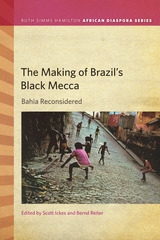 The Making of Brazil's Black Mecca: Bahia Reconsidered
Scott Ickes
Michigan State University Press, 2018 One of the few interdisciplinary volumes on Bahia available, The Making of Brazil’s Black Mecca: Bahia Reconsidered contains contributions covering a wide chronological and topical range by scholars whose work has made important contributions to the field of Bahian studies over the last two decades. The authors interrogate and problematize the idea of Bahia as a Black Mecca, or a haven where Brazilians of African descent can embrace their cultural and spiritual African heritage without fear of discrimination. In the first section, leading historians create a century-long historical narrative of the emergence of these discourses, their limitations, and their inability to effect meaningful structural change. The chapters by social scientists in the second section present critical reflections and insights, some provocative, on deficiencies and problematic biases built into current research paradigms on blackness in Bahia. As a whole the text provides a series of insights into the ways that inequality has been structured in Bahia since the final days of slavery.
The Making of British Anthropology, 1813-1871
Efram Sera-Shriar
University of Pittsburgh Press, 2013 Victorian anthropology has been derided as an "armchair practice," distinct from the scientific discipline of the twentieth century. But the observational practices that characterized the study of human diversity developed from the established sciences of natural history, geography and medicine. Sera-Shriar argues that anthropology at this time went through a process of innovation which built on scientifically grounded observational study. Far from being an evolutionary dead end, nineteenth-century anthropology laid the foundations for the field-based science of anthropology today.
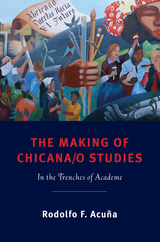 The Making of Chicana/o Studies: In the Trenches of Academe
Acuña, Rodolfo F
Rutgers University Press, 2011 The Making of Chicana/o Studies traces the philosophy and historical development of the field of Chicana/o studies from precursor movements to the Civil Rights era to today, focusing its lens on the political machinations in higher education that sought to destroy the discipline. As a renowned leader, activist, scholar, and founding member of the movement to establish this curriculum in the California State University system, which serves as a model for the rest of the country, Rodolfo F. Acuña has, for more than forty years, battled the trend in academia to deprive this group of its academic presence. The book assesses the development of Chicana/o studies (an area of studies that has even more value today than at its inception)--myths about its epistemological foundations have remained uncontested. Acuña sets the record straight, challenging those in the academy who would fold the discipline into Latino studies, shadow it under the dubious umbrella of ethnic studies, or eliminate it altogether. Building the largest Chicana/o studies program in the nation was no easy feat, especially in an atmosphere of academic contention. In this remarkable account, Acuña reveals how California State University, Northridge, was instrumental in developing an area of study that offers more than 166 sections per semester, taught by 26 tenured and 45 part-time instructors. He provides vignettes of successful programs across the country and offers contemporary educators and students a game plan--the mechanics for creating a successful Chicana/o studies discipline--and a comprehensive index of current Chicana/o studies programs nationwide. Latinas/os, of which Mexican Americans are nearly seventy percent, comprise a complex sector of society projected to be just shy of thirty percent of the nation's population by 2050. The Making of Chicana/o Studies identifies what went wrong in the history of Chicana/o studies and offers tangible solutions for the future.
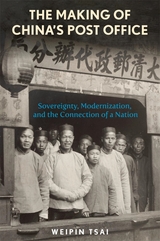 The Making of China’s Post Office: Sovereignty, Modernization, and the Connection of a Nation
Weipin Tsai
Harvard University Press, 2023 The Making of China’s Post Office traces the origins and early development of the country’s modern postal system. Sweeping in perspective, it goes beyond the bounds of institutional history to explore the political maneuverings, economic imperatives, and societal pressures both inhibiting and driving forward postal development. Although its prime mover was Robert Hart, Inspector General of the Chinese Maritime Customs Service, the wider cast of characters includes foreign and native staff, Qing officials, local administrations, commercial interests, and foreign governments.
Drawing extensively on archival material from the Second Historical Archives of China in Nanjing, the Tianjin Municipal Archives, and the Archive of Queen’s University Belfast, Weipin Tsai contextualizes the making of the post office within the country’s long and contested path of modernization, bringing Chinese voices to the fore. Tsai illustrates the extent to which local agency shaped the design and development of the service as it expanded from experimental coastal operation into China’s interior and on to its border periphery, the first nationwide modernization project to directly impact people’s daily lives. Ultimately, the grand spatial reach of the Post Office carried significant symbolic meaning in relation to sovereignty for the Qing government and for later Republican administrations.
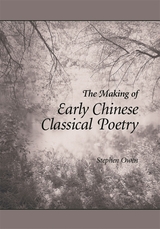 The Making of Early Chinese Classical Poetry
Stephen Owen
Harvard University Press, 2006 Over the centuries, early Chinese classical poetry became embedded in a chronological account with great cultural resonance and came to be transmitted in versions accepted as authoritative. But modern scholarship has questioned components of the account and cast doubt on the accuracy of received texts. The result has destabilized the study of early Chinese poetry.
This study adopts a double approach to the poetry composed between the end of the first century BCE and the third century CE. First, it examines extant material from this period synchronically, as if it were not historically arranged, with some poems attached to authors and some not. By setting aside putative differences of author and genre, Stephen Owen argues, we can see that this was "one poetry," created from a shared poetic repertoire and compositional practices. Second, it considers how the scholars of the late fifth and early sixth centuries selected this material and reshaped it to produce the standard account of classical poetry.
As Owen shows, early poetry comes to us through reproduction—reproduction by those who knew the poem and transmitted it, by musicians who performed it, and by scribes and anthologists—all of whom changed texts to suit their needs.
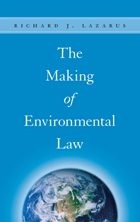 The Making of Environmental Law
Richard J. Lazarus
University of Chicago Press, 2004 The unprecedented expansion in environmental regulation over the past thirty years—at all levels of government—signifies a transformation of our nation's laws that is both palpable and encouraging. Environmental laws now affect almost everything we do, from the cars we drive and the places we live to the air we breathe and the water we drink. But while enormous strides have been made since the 1970s, gaps in the coverage, implementation, and enforcement of the existing laws still leave much work to be done.
In The Making of Environmental Law, Richard J. Lazarus offers a new interpretation of the past three decades of this area of the law, examining the legal, political, cultural, and scientific factors that have shaped—and sometimes hindered—the creation of pollution controls and natural resource management laws. He argues that in the future, environmental law must forge a more nuanced understanding of the uncertainties and trade-offs, as well as the better-organized political opposition that currently dominates the federal government. Lazarus is especially well equipped to tell this story, given his active involvement in many of the most significant moments in the history of environmental law as a litigator for the Justice Department's Environment and Natural Resources Division, an assistant to the Solicitor General, and a member of advisory boards of the U.S. Environmental Protection Agency, the World Wildlife Fund, and the Environmental Defense Fund.
Ranging widely in his analysis, Lazarus not only explains why modern environmental law emerged when it did and how it has evolved, but also points to the ambiguities in our current situation. As the field of environmental law "grays" with middle age, Lazarus's discussions of its history, the lessons learned from past legal reforms, and the challenges facing future lawmakers are both timely and invigorating.
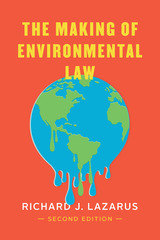 The Making of Environmental Law
Richard J. Lazarus
University of Chicago Press, 2022 An updated and passionate second edition of a foundational book.
How did environmental law first emerge in the United States? Why has it evolved in the ways that it has? And what are the unique challenges inherent to environmental lawmaking in general and in the United States in particular?
Since its first edition, The Making of Environmental Law has been foundational to our understanding of these questions. For the second edition, Richard J. Lazarus returns to his landmark book and takes stock of developments over the last two decades. Drawing on many years of experience on the frontlines of legal and policy battles, Lazarus provides a theoretical overview of the challenges that environmental protection poses for lawmaking, related to both the distinctive features of US lawmaking institutions and the spatial and temporal dimensions of ecological change. The book explains why environmental law emerged in the manner and form that it did in the 1970s and traces how it developed over sequent decades through key laws and controversies. New chapters, composing more than half of the second edition, examine a host of recent developments. These include how Congress dropped out of environmental lawmaking in the early twenty-first century; the shifting role of the judiciary; long-overdue efforts to provide environmental justice to disadvantaged communities; and the destabilization of environmental law that has resulted from the election of Presidents with dramatically clashing environmental policies.
As the nation’s partisan divide has grown deeper and the challenge of climate change has dramatically raised the perceived stakes for opposing interests, environmental law is facing its greatest challenges yet. This book is essential reading for understanding where we have been and what challenges and opportunities lie ahead.
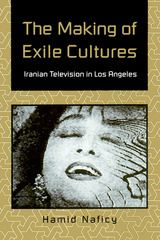 The making of exile cultures: Iranian television in Los Angeles
Hamid. Naficy
University of Minnesota Press, 1993 Iranian Television in Los Angeles
Hamid Naficy
Naficy explores the seemingly contradictory way in which immigrant media and cultural productions serve as the source both of resistance and opposition to the domination by host and home country's social values while simultaneously serving as vehicles for personal and cultural transformation and assimilation of those values.
"An important contribution to cultural anthropology. The Making of Exile Cultures is meticulously researched. It is no small achievement of the book that is pulls the focus in Middle East studies from geographically cohesive national cultures, 'hard' politics and high culture (art, literature) to exile cultures, media politics and the popular. Although it is a close case study, The Making of Exile Cultures participates in debates and methodologies across a range of disciplines beyond media studies. It is not simply a much-needed contribution to the growing set of micro-histories of local media use. Rather, it demonstrates the increasing centrality of minority television cultures to the overall structure of North American mainstream television. The Making of Exile Cultures should be read and used by media theorists, then, not just because it fills in another gap in knowledge of narrowcast television's heterogeneous field (as if there were a collective puzzle in the making here), but because it provides media theory with some important new ways of working through the particular questions of race, gender, nation, industry and audience that come into play regardless of our respective 'local' interest." Screen
"Fresh, stimulating, and an extremely valuable contribution to the study of cultural production amongst immigrants and the articulation of local and transnational identities. A fascinating study of the cultural politics of identity." Middle East Journal
"The Making of Exile Cultures transcends its limited scope and ethnographic ambitions to poignantly illuminate a truly multicultural situation. Naficy's engaging prose and personal anecdotes made the dry ethnography not just palatable but fascinating. This was not merely a sociological analysis of the interaction of television aesthetics and a group in exile. It was not merely a collection of copious details and taxonomies about what was broadcast when and by whom. It was not merely a study of now an exile group expresses nostalgic longing and fetishistic desire for an absent home. The power of this book is found in narratives, stories, and recollections of the author and interviewees. Naficy saves his study from falling into the banality of charts, tables, and taxonomies through his ability to tie something very specific to the larger issue of what means to live in exile." SubStance
"In this book, Naficy provides us with an example of exilic agency and the possibilities that can come about when hybridized exiles use their unique perspective gained form a split-subjectivity. This book is highly recommended for scholars in immigration studies as well as those engaged in cultural studies and the field of mass media and communications." Journal of American Ethnic History
"Ultimately, The Making of Exile Cultures: Iranian Media in Los Angeles is an important contribution to the growing scholarship on Iranians in diaspora and serves best as a handbook for decoding the popular culture of Iranians in Los Angeles. Naficy's book serves as the best model yet for studying Iranian culture among the expatriate communities, a model which goes beyond one-dimensional stereotypes or demographic and statistical analyses to provide an intimate and analytical study of a culture undergoing chaotic change." JUSUR (The UCLA Journal of Middle Eastern Studies)
"An important contribution to both Iranian and cultural studies. Exile Cultures provides an illuminating study of the mediating role of television in transforming an exile community into an ethnicity. Naficy's careful discussions of its political economy and textual politics offer valuable insights into the micro-practices of this exilic culture, insights that should prove useful to a broad range of readers, from those interested in the general questions of ethnicity and community in the United States to scholars working on the more specific issues of Iranian culture." International Journal of Middle East Studies
"Naficy's own blend of rigorous research, well presented data, and thorough knowledge of the theories to which he refers is an illustration of the kind of a successful syncretism he observes in the material he studies." Canadian Review of Comparative Literature
"This is an excellent study of the understudied world of Iranian popular culture in exile. An indispensable source of knowledge about contemporary Iran and life in exile in the vast diaspora formed in the wake of the 1978-79 revolution." Iranian Studies
"Naficy blends together the psychological and cultural backgrounds and aspirations of users and producers with the political economy of the ethnic media, and the way in which this local political economy not only articulates with the larger economy of the U.S. and world economy, but psychologically and culturally transforms its participants." Michael M. J. Fischer
The Making of Federal Coal Policy
Robert H. Nelson
Duke University Press, 1983 The Making of Federal Coal Policy provides a unique record of—as well as important future perspectives on—one of the most significant ideological conflicts in national policymaking in the last decade. The management of federally owned coal, almost one-third of the U.S.'s total coal resources, has furnished an arena for the contest between energy development and environmental protection, as well as between the federal government and the states. Robert H. Nelson has written an important historical document and a useful guide for policy analysts.
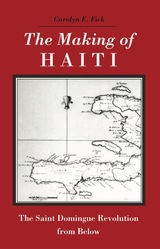 The Making of Haiti: The Saint Domingue Revolution from Below
Carolyn E. Fick
University of Tennessee Press, 1991 In 1789 the French colony of Saint Domingue was the wealthiest and most flourishing of the Caribbean slave colonies, its economy based on the forced labor of more than half a million black slaves raided from their African homelands. The revolt of this underclass in 1791—the only successful slave rebellion in history—gained the slaves their freedom and set in motion the colony's struggle for independence as the black republic of Haiti.
In this pioneering study, Carolyn E. Fick argues that the repressed and uneducated slaves were the principal architects both of their own freedom and of the successful movement toward national independence. Fick identifies "marronage," the act of being a fugitive slave, as a basic unit of slave resistance from which the revolution grew and shows how autonomous forms of popular slave participation were as important to the success of the rebellion as the leadership of men like Toussaint Louverture, Henri Christophe, and Dessalines. Using contemporary manuscripts and previously untapped archival sources, the author depicts the slaves, their aspirations, and their popular leaders and explains how they organized their rebellion.
Fick places the Saint Domingue rebellion in relation to the larger revolutionary movements of the era, provides background on class and caste prior to the revolution, the workings of the plantation system, the rigors of slave life, and the profound influence of voodoo. By examining the rebellion and the conditions that led to it from the perspective of the slaves it liberated, she revises the history of Haiti.
Carolyn Fick is currently a Canada Research Fellow at Concordia University in Montreal.
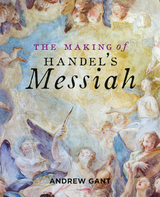 The Making of Handel’s Messiah
Andrew Gant
Bodleian Library Publishing, 2020 The first performance of George Frideric Handel’s Messiah in Dublin in 1742 is now legendary. Gentlemen were asked to leave their swords at home and ladies to come without hoops in their skirts in order to fit more people into the audience. The initial performance was so well-received in Dublin that an encore performance was given a few weeks later. Why then, did this now famous and beloved oratorio receive a somewhat cool reception when it premiered in London less than a year later?
Placing Handel’s best-known work in the context of its times, this vivid account charts the composer’s working relationship with his librettist, the gifted but demanding Charles Jennens, and looks at Handel’s varied and evolving company of singers together with his royal patronage. Through examination of the original composition manuscript and Handel’s own conducting score, held in the Bodleian Library’s collection, The Making of Handel’s Messiah sheds new light on the piece’s construction, performance, and reception. Exploring the complex history of one of the most successful pieces of choral music of all time, this volume examines issues around the performance of sacred texts in a non-sacred context, particularly Handel’s collaboration with the men and boys of the Chapel Royal. This book also explores the later reception and performance history of the piece, including the festival performance attended by Haydn, the massed-choir tradition of the Victorian period, and today’s “come-and-sing” events.
The Making of Iranian Modernity: Studies in Honor of Houchang E. Chehabi
Roham Alvandi
Harvard University Press The Making of Iranian Modernity brings together a diverse array of scholars from a wide variety of disciplinary backgrounds and areas of research specialization to celebrate Houchang E. Chehabi, one of the leading scholars in the field of Iranian Studies. Since the 1980s, Chehabi’s interdisciplinary body of work has made major contributions both to the study of modern Iran’s social and cultural history, as well as to the understanding of Iran’s broader political evolution and place in the world. All contributors to this volume have been inspired by Houchang Chehabi’s work and have benefited from his mentorship. On the occasion of his retirement, these essays measure his ongoing influence in shaping scholarship and serve as a token of collective gratitude for his contributions.
The Making of Japanese Manchuria, 1904-1932
Yoshihisa Tak Matsusaka
Harvard University Press, 2001 In this history of Japanese involvement in northeast China, the author argues that Japan's military seizure of Manchuria in September 1931 was founded on three decades of infiltration of the area. This incremental empire-building and its effect on Japan are the focuses of this book.
The principal agency in the piecemeal growth of Japanese colonization was the South Manchurian Railway Company, and by the mid-1920s Japan had a deeply entrenched presence in Manchuria and exercised a dominant economic and political influence over the area. Japanese colonial expansion in Manchuria also loomed large in Japanese politics, military policy, economic development, and foreign relations and deeply influenced many aspects of Japan's interwar history.
The Making Of Jewish and Christian Worship
Paul F. Bradshaw
University of Notre Dame Press, 1991 "There is something here for everyone. For the seasoned scholar, a challenge to review his or her methodology. For the scholar steeped in one tradition and not the other, a closer look at two traditions side by side. For the generalist, a concise summary of the state of the question and a good look at the conclusions of the latest scholarship. For the novice, a readable introduction to the best of Jewish and Christian liturgical scholarship."-Worship
The Making of Late Antiquity
Peter Brown
Harvard University Press, 1978 Peter Brown presents a masterly history of Roman society in the second, third, and fourth centuries. Brown interprets the changes in social patterns and religious thought, breaking away from conventional modern images of the period.
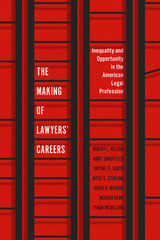 The Making of Lawyers' Careers: Inequality and Opportunity in the American Legal Profession
Robert L. Nelson, Ronit Dinovitzer, Bryant G. Garth, Joyce S. Sterling, David B. Wilkins, Meghan Dawe, and Ethan Michelson
University of Chicago Press, 2023 An unprecedented account of social stratification within the US legal profession. How do race, class, gender, and law school status condition the career trajectories of lawyers? And how do professionals then navigate these parameters? The Making of Lawyers’ Careers provides an unprecedented account of the last two decades of the legal profession in the US, offering a data-backed look at the structure of the profession and the inequalities that early-career lawyers face across race, gender, and class distinctions. Starting in 2000, the authors collected over 10,000 survey responses from more than 5,000 lawyers, following these lawyers through the first twenty years of their careers. They also interviewed more than two hundred lawyers and drew insights from their individual stories, contextualizing data with theory and close attention to the features of a market-driven legal profession. Their findings show that lawyers’ careers both reflect and reproduce inequalities within society writ large. They also reveal how individuals exercise agency despite these constraints.
 Making of Legends: More True Stories of Frontier America
Mark Dugan
Ohio University Press, 1997 Some of the American West’s grandest legends are about people who in reality were remorseless killers, robbers, and bandits. These outlaws flourished during the 1800s and gained notoriety throughout the following century. How did their fame persist, and what has inspired the publishing, movie, and television industries to recreate their fictionalized careers over and over again?
Mark Dugan brings reality to the forefront in The Making of Legends. Some of the characters in his accounts are practically unknown but deserve more recognition than the bandits whose names are mythic. Exhaustive archival research enables him to recreate such colorful lives as North Carolina’s Malina Blaylock, who, disguised as a man, joined her outlaw husband in the Confederate army; slippery escape artist David Lewis, the Robin Hood of the Cumberland, who finally stopped two bullets in a chaotic Pennsylvania shoot-out; Wyatt Earp, in his mysterious post-OK Corral year, amidst the Coeur d’Alene gold rush; and grim “Laughing Sam” Hartman, of South Dakota.
Dugan sets the stage by explaining how newspapers and dime novels fanned the flames of public fascination with outlaws. He unmasks the real Billy the Kid, traces the paths of Butch Cassidy and the Sundance Kid to their historic shoot-out in South America, and masterfully summarizes the Civil War grudges, bloodshed, and wanton destruction along the Kansas-Missouri border that spawned Jesse and Frank James and the Younger brothers gang.
In researching the lawless era of the American frontier, Dugan discovered much information that has never been published — material that will expand readers' views of frontier history and people, both good and bad. The Making of Legends proves that the actual stories of notorious legends can be more exciting, moving, and intriguing than anything dreamed up in a dime novel or a Hollywood fantasy.
With The Making of Legends Mark Dugan’s pursuit of outlaws takes him to Pennsylvania, North Carolina, Texas, California, South Dakota, Idaho, Oregon, Nebraska, Indiana, Wyoming, and Montana.
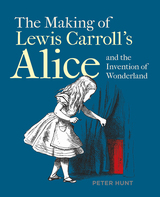 The Making of Lewis Carroll’s Alice and the Invention of Wonderland
Peter Hunt
Bodleian Library Publishing, 2020 Alice’s Adventures in Wonderland and Through the Looking-Glass are two of the most famous, translated, and quoted books in the world. What began as a simple tale told by eccentric Oxford mathematician Charles Dodgson (better known as Lewis Carroll) to Alice Liddell, daughter of the Dean of Christ Church, become a worldwide phenomenon. Fostering film adaptations and retellings, and influencing countless other works, the Alice books have a deeply cherished place in popular culture. Known for their oddities and absurdities, the books have been endlessly interpreted and analyzed for symbolism and hidden messages.
Peter Hunt cuts away the psychological speculation that has grown up around the Alice books, and instead traces the historical sources of their multilayered in-jokes and political, literary, and philosophical satire. He situates the books in the history of children’s literature and explores the local and personal references that the real Alice would have understood. Equally fascinating are the rich fragments about everything from the “sensation” novel to Darwinian theory—not to mention Dodgson’s personal feelings—that he wove into the books as they developed.
Illustrated with manuscripts, portraits, Sir John Tenniel’s original line drawings for the first editions, and contemporary photographs, this is an innovative look at two remarkable stories. The Making of Lewis Carroll’s Alice and the Invention of Wonderland takes us on a guided tour from the treacle wells of Victorian Oxford through an astonishing world of politics, philosophy, humor, and nightmare.
 The Making of Mamaliga: Transimperial Recipes for a Romanian National Dish
Alex Drace-Francis
Central European University Press, 2022 Mămăligă, maize porridge or polenta, is a universally consumed dish in Romania and a prominent national symbol. But its unusual history has rarely been told. Alex Drace-Francis surveys the arrival and spread of maize cultivation in Romanian lands from Ottoman times to the eve of the First World War, and also the image of mămăligă in art and popular culture. Drawing on a rich array of sources and with many new findings, Drace-Francis shows how the making of mămăligă has been shaped by global economic forces and overlapping imperial systems of war and trade. The story of maize and mămăligă provides an accessible way to revisit many key questions of Romanian and broader regional history. More generally, the book links the history of production, consumption, and representation. Analyses of recipes, literary and popular depictions, and key vocabulary complete the work.
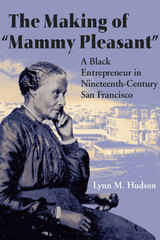 The Making of "Mammy Pleasant": A Black Entrepreneur in Nineteenth-Century San Francisco
Lynn M. Hudson
University of Illinois Press, 2002 Investigating Mary Ellen Pleasant's convoluted legacy Mary Ellen Pleasant arrived in Gold Rush-era San Francisco a free black woman with abolitionist convictions and a predilection for entrepreneurial success. Behind the convenient and trusted disguise of "Mammy," she transformed domestic labor into enterprise, amassed remarkable real estate, wealth, and power, and gained notoriety for her work in fighting Jim Crow. Pleasant's legacy is steeped in scandals and lore. Was she a voodoo queen who traded in sexual secrets? A madam? A murderer? In The Making of "Mammy Pleasant," Lynn M. Hudson examines the folklore of Pleasant's real and imagined powers. Emphasizing the significance of her life in the context of how it has been interpreted or ignored in the larger trends of American history, Hudson integrates fact and speculation culled from periodicals, court cases, diaries, letters, Pleasant's interviews with the San Francisco press, and various biographical and fictional accounts. Addressing the lack of a historical record of black women's lives, the author argues that the silences and mysteries of Pleasant's past, whether never recorded or intentionally omitted, reveal as much about her life as what has been documented. Through Pleasant's life, Hudson also interrogates the constructions of race, gender, and sexuality during the formative years of California's economy and challenges popular mythology about the liberatory sexual culture of the American West.
 The Making of Man-Midwifery: Childbirth in England, 1660-1770
Adrian Wilson
Harvard University Press, 1995 In England in the seventeenth century, childbirth was the province of women. The midwife ran the birth, helped by female "gossips"; men, including the doctors of the day, were excluded both from the delivery and from the subsequent month of lying-in.
But in the eighteenth century there emerged a new practitioner: the "man-midwife" who acted in lieu of a midwife and delivered normal births. By the late eighteenth century, men-midwives had achieved a permanent place in the management of childbirth, especially in the most lucrative spheres of practice.
Why did women desert the traditional midwife? How was it that a domain of female control and collective solidarity became instead a region of male medical practice? What had broken down the barrier that had formerly excluded the male practitioner from the management of birth?
This confident and authoritative work explores and explains a remarkable transformation--a shift not just in medical practices but in gender relations. Exploring the sociocultural dimensions of childbirth, Wilson argues with great skill that it was not the desires of medical men but the choices of mothers that summoned man-midwifery into being.
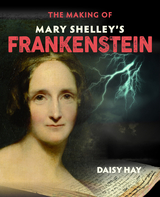 The Making of Mary Shelley's Frankenstein
Daisy Hay
Bodleian Library Publishing, 2018 “Invention … does not consist in creating out of void, but out of chaos”—Mary Shelley
In the two hundred years since its first publication, the story of Frankenstein’s creation during stormy days and nights at Byron’s Villa Diodati on Lake Geneva has become literary legend. In this compelling and innovative book, Daisy Hay stitches together the objects and manuscripts of the novel’s turbulent genesis in order to bring its story back to life.
Frankenstein was inspired by the extraordinary people surrounding the eighteen-year-old author and by the places and historical dramas that formed the backdrop of her youth. Featuring manuscripts, portraits, illustrations, and artifacts, The Making of Mary Shelley’s “Frankenstein” explores the novel’s time and place, the people who inspired its characters, the relics of its long afterlife, and the notebooks in which it was created. Hay strips Frankenstein back to its constituent parts to reveal an uneven novel written by a young woman deeply engaged in the process of working out what she thought about the pressing issues of her time: from science, politics, religion, and slavery to maternity, the imagination, creativity, and community. Richly illustrated throughout, this is an astute and intricate biography of the novel for all those fascinated by its essential, brilliant chaos.
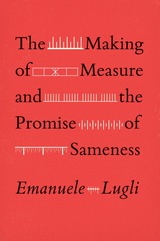 The Making of Measure and the Promise of Sameness
Emanuele Lugli
University of Chicago Press, 2019 An interdisciplinary history of standardized measurements.
Measurement is all around us—from the circumference of a pizza to the square footage of an apartment, from the length of a newborn baby to the number of miles between neighboring towns. Whether inches or miles, centimeters or kilometers, measures of distance stand at the very foundation of everything we do, so much so that we take them for granted. Yet, this has not always been the case.
This book reaches back to medieval Italy to speak of a time when measurements were displayed in the open, showing how such a deceptively simple innovation triggered a chain of cultural transformations whose consequences are visible today on a global scale. Drawing from literary works and frescoes, architectural surveys, and legal compilations, Emanuele Lugli offers a history of material practices widely overlooked by historians. He argues that the public display of measurements in Italy’s newly formed city republics not only laid the foundation for now centuries-old practices of making, but also helped to legitimize local governments and shore up church power, buttressing fantasies of exactitude and certainty that linger to this day.
This ambitious, truly interdisciplinary book explains how measurements, rather than being mere descriptors of the real, themselves work as powerful molds of ideas, affecting our notions of what we consider similar, accurate, and truthful.
The Making of Modern Anthrax, 1875-1920: Uniting Local, National and Global Histories of Disease
James Stark
University of Pittsburgh Press, 2013 From the mid-nineteenth century onwards a number of previously unknown conditions were recorded in both animals and humans. Known by a variety of names, and found in diverse locations, by the end of the century these diseases were united under the banner of "anthrax." Stark offers a fresh perspective on the history of infectious disease. He examines anthrax in terms of local, national and global significance, and constructs a narrative that spans public, professional and geographic domains.
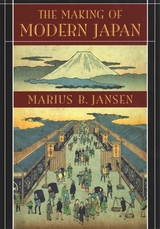 The Making of Modern Japan
Marius B. Jansen
Harvard University Press, 2002 Magisterial in vision, sweeping in scope, this monumental work presents a seamless account of Japanese society during the modern era, from 1600 to the present. A distillation of more than fifty years’ engagement with Japan and its history, it is the crowning work of our leading interpreter of the modern Japanese experience.
Since 1600 Japan has undergone three periods of wrenching social and institutional change, following the imposition of hegemonic order on feudal society by the Tokugawa shogun; the opening of Japan’s ports by Commodore Perry; and defeat in World War II. The Making of Modern Japan charts these changes: the social engineering begun with the founding of the shogunate in 1600, the emergence of village and castle towns with consumer populations, and the diffusion of samurai values in the culture.
Marius Jansen covers the making of the modern state, the adaptation of Western models, growing international trade, the broadening opportunity in Japanese society with industrialization, and the postwar occupation reforms imposed by General MacArthur. Throughout, the book gives voice to the individuals and views that have shaped the actions and beliefs of the Japanese, with writers, artists, and thinkers, as well as political leaders given their due.
The story this book tells, though marked by profound changes, is also one of remarkable consistency, in which continuities outweigh upheavals in the development of society, and successive waves of outside influence have only served to strengthen a sense of what is unique and native to Japanese experience. The Making of Modern Japan takes us to the core of this experience as it illuminates one of the contemporary world’s most compelling transformations.
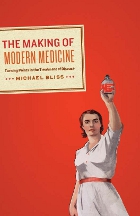 The Making of Modern Medicine: Turning Points in the Treatment of Disease
Michael Bliss
University of Chicago Press, 2011 At the dawn of the twenty-first century, we have become accustomed to medical breakthroughs and conditioned to assume that, regardless of illnesses, doctors almost certainly will be able to help—not just by diagnosing us and alleviating our pain, but by actually treating or even curing diseases, and significantly improving our lives. For most of human history, however, that was far from the case, as veteran medical historian Michael Bliss explains in The Making of Modern Medicine. Focusing on a few key moments in the transformation of medical care, Bliss reveals the way that new discoveries and new approaches led doctors and patients alike to discard fatalism and their traditional religious acceptance of suffering in favor of a new faith in health care and in the capacity of doctors to treat disease. He takes readers in his account to three turning points—a devastating smallpox outbreak in Montreal in 1885, the founding of the Johns Hopkins Hospital and Medical School, and the discovery of insulin—and recounts the lives of three crucial figures—researcher Frederick Banting, surgeon Harvey Cushing, and physician William Osler—turning medical history into a fascinating story of dedication and discovery. Compact and compelling, this searching history vividly depicts and explains the emergence of modern medicine—and, in a provocative epilogue, outlines the paradoxes and confusions underlying our contemporary understanding of disease, death, and life itself.
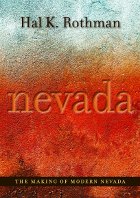 The Making of Modern Nevada
Hal Rothman
University of Nevada Press, 2010 Nevada has always been different from other states. Almost from its beginning, Nevada sanctioned behaviors considered immoral elsewhere—gambling, prize-fighting, brothels, easy divorce—and embraced a culture of individualism and disdain for the constraints of more conventional society. In The Making of Modern Nevada, author Hal Rothman focuses on the factors that shaped the state’s original maverick, colonial status and those that later allowed it to emerge as the new standard of American consumer- ism and postmodern liberalism. Rothman introduces the masters who sought to own Nevada, from bonanza kings to Mafia mobsters, as well as the politicians, miners, gamblers, civic and civil-rights leaders, union organ- izers, and casino corporate moguls who guided the state into prosperity and national importance. He also analyzes the role of mob and labor union money in the development of Las Vegas; the Sagebrush Rebellion; the rise of megaresorts and of Las Vegas as a world icon of leisure and pleasure; and the political and social impact of the proposed Yucca Mountain nuclear waste repository. The Making of Modern Nevada is essential reading for anyone who wonders how the Silver State got this way, and where it may be going in the twenty-first century.
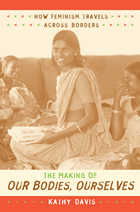 The Making of Our Bodies, Ourselves: How Feminism Travels across Borders
Kathy Davis
Duke University Press, 2007 The book Our Bodies, Ourselves is a feminist success story. Selling more than four million copies since its debut in 1970, it has challenged medical dogmas about women’s bodies and sexuality, shaped health care policies, energized the reproductive rights movement, and stimulated medical research on women’s health. The book has influenced how generations of U.S. women feel about their bodies and health. Our Bodies, Ourselves has also had a whole life outside the United States. It has been taken up, translated, and adapted by women across the globe, inspiring more than thirty foreign language editions. Kathy Davis tells the story of this remarkable book’s global circulation. Based on interviews with members of the Boston Women’s Health Book Collective, the group of women who created Our Bodies, Ourselves, as well as responses to the book from readers, and discussions with translators from Latin America, Egypt, Thailand, China, Eastern Europe, Francophone Africa, and many other countries and regions, Davis shows why Our Bodies, Ourselves could never have been so influential if it had been just a popular manual on women’s health. It was precisely the book’s distinctive epistemology, inviting women to use their own experiences as resources for producing situated, critical knowledge about their bodies and health, that allowed the book to speak to so many women within and outside the United States. Davis provides a grounded analysis of how feminist knowledge and political practice actually travel, and she shows how the process of transforming Our Bodies, Ourselves offers a glimpse of a truly transnational feminism, one that joins the acknowledgment of difference and diversity among women in different locations with critical reflexivity and political empowerment.
 The Making of Paul Klee's Career, 1914-1920
Otto Karl Werckmeister
University of Chicago Press, 1989 Paul Klee—one of the preeminent artists of the twentieth century—was associated with all of the major movements of the first half of the century: expressionism, cubism, surrealism, and abstraction. In this economic and political history, O. K. Werckmeister traces Klee's career as a professional artist, concentrating on the years 1914-20 in which Klee rose from obscurity to recognition in the visual culture of the incipient Weimar Republic. Werckmeister reveals the degree to which Klee, who has been traditionally portrayed as aloof from politics and the vicissitudes of the art market, was subject to and interacted with material conditions.
Drawing on rich documentary evidence—records of Klee's sales, reviews of his exhibitions, the artist's published writings about his art, unpublished correspondence, as well as contemporary criticism—Werckmeister follows Klee's transformation from an idiosyncratic abstract individualist to a metaphysical storyteller to mystical sage. Werckmeister argues that this latter image was promoted by a number of influential art critics and dealers acting in cooperation with the artist himself. This posture prompted Klee's success first in the war-weary modernist art world of 1916-18 and then in the pseudo-revolutionary art world of 1919-20.
This work is a critical challenge to the myth of Klee's art and to the hagiography of his artistic personality. Werckmeister's historical account is sure to be a controversial yet significant contribution to Klee studies—one that will change the nature of Klee scholarship for some time to come.
The Making of Pioneer Wisconsin: Voices of Early Settlers
Michael E. Stevens
Wisconsin Historical Society Press, 2018 From the mid-1830s through the 1850s, more than a half million people settled in Wisconsin. While traveling in ships and wagons, establishing homes, and forming new communities, these men, women, and children recorded their experiences in letters, diaries, and newspaper articles. In their own words, they revealed their fears, joys, frustrations, and hopes for life in this new place.
The Making of Pioneer Wisconsin provides a unique and intimate glimpse into the lives of these early settlers, as they describe what it felt like to be a teenager in a wagon heading west or an isolated young wife living far from her friends and family. Woven together with context provided by historian Michael E. Stevens, these first-person accounts form a fascinating narrative that deepens our ability to understand and empathize with Wisconsin’s early pioneers.
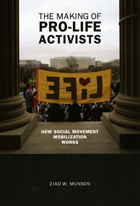 The Making of Pro-life Activists: How Social Movement Mobilization Works
Ziad W. Munson
University of Chicago Press, 2008 How do people become activists for causes they care deeply about? Many people with similar backgrounds, for instance, fervently believe that abortion should be illegal, but only some of them join the pro-life movement. By delving into the lives and beliefs of activists and nonactivists alike, Ziad W. Munson is able to lucidly examine the differences between them.
Through extensive interviews and detailed studies of pro-life organizations across the nation, Munson makes the startling discovery that many activists join up before they develop strong beliefs about abortion—in fact, some are even pro-choice prior to their mobilization. Therefore, Munson concludes, commitment to an issue is often a consequence rather than a cause of activism.
The Making of Pro-life Activists provides a compelling new model of how people become activists while also offering a penetrating analysis of the complex relationship between religion, politics, and the pro-life movement. Policy makers, activists on both sides of the issue, and anyone seeking to understand how social movements take shape will find this book essential.
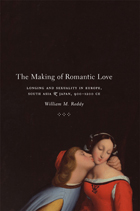 The Making of Romantic Love: Longing and Sexuality in Europe, South Asia, and Japan, 900-1200 CE
William M. Reddy
University of Chicago Press, 2012 In the twelfth century, the Catholic Church attempted a thoroughgoing reform of marriage and sexual behavior aimed at eradicating sexual desire from Christian lives. Seeking a refuge from the very serious condemnations of the Church and relying on a courtly culture that was already preoccupied with honor and secrecy, European poets, romance writers, and lovers devised a vision of love as something quite different from desire. Romantic love was thus born as a movement of covert resistance. In The Making of Romantic Love: Longing and Sexuality in Europe, South Asia, and Japan, William M. Reddy illuminates the birth of a cultural movement that managed to regulate selfish desire and render it innocent—or innocent enough. Reddy strikes out from this historical moment on an international exploration of love, contrasting the medieval development of romantic love in Europe with contemporaneous eastern traditions in Bengal and Orissa, and in Heian Japan from 900-1200 CE, where one finds no trace of an opposition between love and desire. In this comparative framework, Reddy tells an appealing tale about the rise and fall of various practices of longing, underscoring the uniqueness of the European concept of sexual desire.
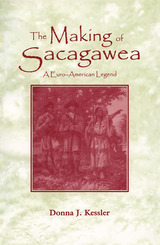 The Making of Sacagawea: A Euro-American Legend
Donna Barbie Kessler
University of Alabama Press, 1998 Kessler supplies both the biography of a legend and an explanation of why that legend has endured.
Sacagawea is one of the most renowned figures of the American West. A member of the Shoshone tribe, she was captured by the Hidatsas as a child and eventually became one of the wives of a French fur trader, Toussaint Charbonneau. In 1805 Charbonneau joined Lewis and Clark as the expedition's interpreter. Sacagawea was the only woman to participate in this important mission, and some claim that she served as a guide when the expedition reached the upper Missouri River and the mountainous region. Although much has been written about the historical importance of Sacagawea in connection with the expedition, no one has explored why her story has endured so successfully in Euro-American culture. In an examination of representative texts (including histories, works of fiction, plays, films, and the visual arts) from 1805 to the present, Kessler charts the evolution and transformation of the legend over two centuries and demonstrates that Sacagawea has persisted as a Euro-American legend because her story exemplified critical elements of America's foundation myths-especially the concept of manifest destiny. Kessler also shows how the Sacagawea legend was flexible within its mythic framework and was used to address cultural issues specific to different time periods, including suffrage for women, taboos against miscegenation, and modern feminism.
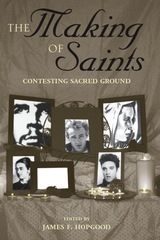 The Making of Saints: Contesting Sacred Ground
Edited by James F. Hopgood
University of Alabama Press, 2005 Celebrities and popular icons are increasingly ubiquitous figures of a 21st century postmodern world. Some, in death, blur age-old distinctions of sanctification and trespass on sacred ground long held exclusively by religious saints. An emerging continuum is transforming that sacred arena and raising a number of important issues, including the nature of the relationships between the worshipped and the worshipful and the types of institutions that sustain them. The Making of Saints: Contesting Sacred Ground investigates a number of religious leaders, healers, folk saints, and popular icons in seeking to identify their commonalities and discover how they speak to the same inner yearnings of human beings for gods and heroes. Issues of social relations, love, emotion, charisma, power, and sanctification are addressed by the contributors. Analyses of hagiographies, biographies, media, control of space, pilgrimage, and acts of devotion provide the bases for the authors' explorations of these issues. Among the sanctified included for analysis are the folk saints El Nino Fidencio and Teresa Urrea; the charismatic rabbis Baba Sali, Baba Baruch, and Ifargan; King Chulalongkorn of Thailand; two political figures, Evita Peron and Che Guevara; and three celebrities: James Dean, Elvis Presley, and Japanese rock star HIDE. The contributors challenge notions of what is sacred and who may be sanctified, and argue that a broadening of views is needed to accommodate and appreciate emerging contemporary realities.
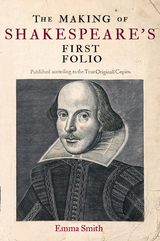 The Making of Shakespeare's First Folio
Emma Smith
Bodleian Library Publishing, 2015 Shakespeare is synonymous with English literature. Well-loved the world over, his work endures for its ability to speak powerfully to the follies and foibles of human nature. We endlessly debate not only the finer points of each of his plays and sonnets but also the identity of the Bard himself. Yet no fanfare surrounded the initial publication of Shakespeare’s First Folio—no queue of eager readers, no launch to the top of the best seller list. It wasn’t until four hundred years after Shakespeare’s death that the book would be the subject of a national book tour.
The Making of Shakespeare’s First Folio offers the first comprehensive biography of the earliest collected edition of Shakespeare’s plays. In November 1623, the book arrived in the bookshop of the London publisher Edward Blount at the Black Bear. Long in the making, Master William Shakespeare’s Comedies, Histories, and Tragedies—as the First Folio was then known—appeared seven years after Shakespeare’s death. Nearly one thousand pages in length, the collection comprised thirty-six plays, half of which had never been previously published. Emma Smith tells the story of the First Folio’s origins, locating it within the social and political context of Jacobean London and bringing in the latest scholarship on the seventeenth-century book trade.
Extensively illustrated, The Making of Shakespeare’s First Folio is a landmark addition to the copious literature on Shakespeare. It will shed much-needed light on the birth of the First Folio—of which fewer than 250 copies remain—and the birth of Shakespeare’s towering reputation.
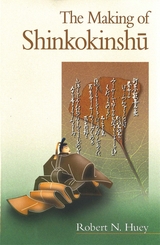 The Making of Shinkokinshū
Robert N. Huey
Harvard University Press, 2002 This study of the Japanese imperial court in the early thirteenth century focuses on the compilation of one of Japan’s most important poetry collections, Shinkokinshū. Using personal diaries, court records, poetry texts, and literary treatises, Robert N. Huey reconstructs the process by which Retired Emperor Go-Toba brought together contending factions to produce this collection and laid the groundwork for his later attempt at imperial restoration. The work analyzes how poetic discourse of the imperial court animated both other kinds of writing and other activities. Finally, it underscores the inextricable ties between the writing of poetry and court politics.
Shinkokinshū—the “New Kokinshu”—has been viewed as a neo-classical effort. Reading history backward, scholars have often taken the work to be the outgrowth of a nostalgia for greatness presumed to have been lost in the wars of the origins of the collection. The author argues that the compilers of Shinkokinshū instead saw it as a “new” beginning, a revitalization and affirmation of courtly traditions, and not a reaction to loss. It is a dynamic collection, full of innovative, challenging poetry—not an elegy for a lost age.
 The Making of Terrorism
Michel Wieviorka
University of Chicago Press, 1993 In this innovative study, Michel Wieviorka applies interventionist sociology to a comparative analysis of Italian, Peruvian, Basque, and Middle Eastern terrorist groups. Through staged confrontations between terrorists and their targets, and extensive interviews with both parties, he throws new light on the terrorists and their relationships both to the movements they represent and the social institutions they attempt to destroy.
Wieviorka demonstrates that the truly terrorist actor has become alienated both from the collective movement and society. The actor turns to the blind violence when he finds himself cut off from the very ideology which legitimates his actions. Pure terrorism, Wieviorka concludes, is more than simply a break between those who use it and those it targets; it is also a relationship—between the individual and the collective he represents—which has been rendered unrealistic or artificial. Thus, terrorist violence should be understood not as the desperate act of a faltering movement but as a substitute for a movement which has fallen away from the ideology in which it was forged.
For the revelations it offers on the roots and motivations of terrorism, for its innovative methods, and for its useful comparative analysis of terrorist groups in recent history, The Making of Terrorism will be an important resource across many disciplines for anyone interested in terrorism or political violence.
The Making of Terrorism
Michel Wieviorka
University of Chicago Press, 2004 Revised and reissued in light of recent events, this classic and now increasingly important book is an exception in the literature on terrorism. Based on complex observations of actual movement participants, Wieviorka's book addresses a broad spectrum of terrorist activity—from Italian left-wing terrorists to Basque nationalist groups to the international terrorism of Palestine and the Middle East. The result is an incisive analysis of what terrorists believe and what they hope to achieve through their actions. For this new edition, Wieviorka adds new material that remaps the state of terrorism after the events of 2001.
The Making of the Asia Pacific: Knowledge Brokers and the Politics of Representation
See Seng Tan
Amsterdam University Press, 2012 Critically surveying the power of narratives in shaping the discourse on the post-Cold War Asia Pacific, See Seng Tan examines the purposes, practices, power relations, and protagonists behind policy networks such as the Council for Security Cooperation in the Asia Pacific and the Pacific Economic Cooperation Council. The author argues that, filled with economic, social, and political meaning, the policy and academic discourses regarding the Asia Pacific and its subregions authorize and provoke certain understandings while preventing counternarratives from emerging.
 Making of the Auden canon
Joseph Warren Beach
University of Minnesota Press, 1957 Making of the Auden canon was first published in 1957. Minnesota Archive Editions uses digital technology to make long-unavailable books once again accessible, and are published unaltered from the original University of Minnesota Press editions. No poet writing in English is more representative of the intellectual trends of the thirties and forties than W. H. Auden. British born, Oxford educated, American by naturalization, and now returned to Oxford to occupy the chair of poetry, he is widely regarded as the spiritual guide and keeper of the conscience of the age, at the same time that he exemplifies the gradual passage from ideological left to right so characteristic of the period. This study of Auden's poetry and revisions has far-reaching implications for an understanding not only of Auden's own writing but that of his contemporaries as well. Considering that 1945 Collected Poetry as the Auden canon, or authorized version of the poems, Mr. Beach examines the process by which Auden selected poems to be admitted to the canon. He shows that the poet eliminated many that were at odds with his later style and thought, discreetly revised others to bring them into line, and, at the same time, left unaltered some of the pieces from his unregenerate days. Auden's system of selection and revision reflects the winding course of his thought, and, by tracing this course, Mr. Beach endeavors to penetrate the poet's diverse masks in an effort to get at the identity of t he man himself.
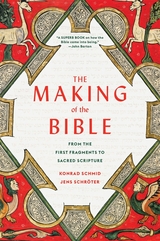 The Making of the Bible: From the First Fragments to Sacred Scripture
Konrad Schmid and Jens Schröter
Harvard University Press, 2021 “The Making of the Bible is invaluable for anyone interested in Scripture and in the intertwined histories of Judaism and Christianity.”
—John Barton, author of A History of the Bible: The Book and Its Faiths
The authoritative new account of the Bible’s origins, illuminating the 1,600-year tradition that shaped the Christian and Jewish holy books as millions know them today.
The Bible as we know it today is best understood as a process, one that begins in the tenth century BCE. In this revelatory account, a world-renowned scholar of Hebrew scripture joins a foremost authority on the New Testament to write a new biography of the Book of Books, reconstructing Jewish and Christian scriptural histories, as well as the underappreciated contest between them, from which the Bible arose.
Recent scholarship has overturned popular assumptions about Israel’s past, suggesting, for instance, that the five books of the Torah were written not by Moses but during the reign of Josiah centuries later. The sources of the Gospels are also under scrutiny. Konrad Schmid and Jens Schröter reveal the long, transformative journeys of these and other texts en route to inclusion in the holy books. The New Testament, the authors show, did not develop in the wake of an Old Testament set in stone. Rather the two evolved in parallel, in conversation with each other, ensuring a continuing mutual influence of Jewish and Christian traditions. Indeed, Schmid and Schröter argue that Judaism might not have survived had it not been reshaped in competition with early Christianity.
A remarkable synthesis of the latest Old and New Testament scholarship, The Making of the Bible is the most comprehensive history yet told of the world’s best-known literature, revealing its buried lessons and secrets.
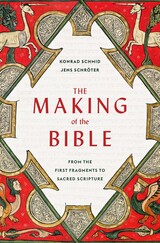 The Making of the Bible: From the First Fragments to Sacred Scripture
Konrad Schmid and Jens Schröter
Harvard University Press “A landmark…If you have time to read only one book on the Bible this year, make sure that it is this one.”—Katherine J. Dell, Church Times
“Excellent…With a sure touch, the authors lead the reader through the geopolitical context of the Hebrew Bible and the setting and background of the New Testament, finding something to say about practically every book’s origins and development.”—John Barton, The Tablet
“A remarkable deep dive into foundational books whose origins are often taken for granted.”—Publishers Weekly
In this revelatory account of the making of the foundational text of western civilization, a world-renowned scholar of the Hebrew scriptures joins a noted authority on the New Testament to reconstruct Jewish and Christian scriptural histories and reveal the underappreciated contest between them.
The New Testament, they show, did not develop in the wake of an Old Testament set in stone. The two evolved in parallel, often in conversation with each other, ensuring a continuing mutual influence of Jewish and Christian traditions. A remarkable synthesis of the latest Old and New Testament scholarship, The Making of the Bible is the most comprehensive history yet of the long, transformative journeys of these texts on route to inclusion in the holy books, revealing their buried lessons and secrets.
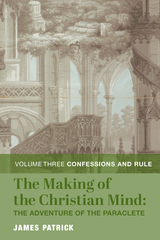 The Making of the Christian Mind: The Adventure of the Paraclete: Vol. 3: Confessions and Rule
James Patrick
St. Augustine's Press, 2022 In the third installment of The Making of the Christian Mind, James Patrick's Church history and 'adventure' series, we meet more towering figures of Christianity, among them Augustine and Benedict. The former, who abandoned rhetoric to become learned by Saint Ambrose, and the latter, whose Rule built a thousand monastic communities across Europe, were not isolated characters but beneficiaries of wisdom drawn entirely from the pursuit of holiness. What emerges is a culture of living and learning that flourishes on the foundations of prayer. This is the adventure of the Great Helper, who working throughout the passage of time post-Christ has come to guide not just the dreams and spirit of man, but his work and daily life.
Patrick's work is both fine scholarship and epic story-telling, a key component to both the education and fascination of the Christian mind, which in turn has shaped the world more deeply than any other influence in human history. "The Christian intellect will guide the heart to the place where the knee can bend and the eye see; the making of the Christian mind will continue from age to age, locating eternal truth in a human history that will endure as God wills so that many may be saved, pointing beyond itself to the reality that thoughts and words represent, making all things new."
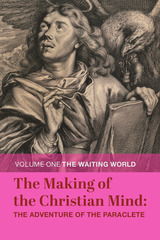 The Making of the Christian Mind: The Adventure of the Paraclete: Volume I: The Waiting World
James Patrick
St. Augustine's Press, 2020 Dr. James Patrick has spent his life teaching, and in this book he seeks to tell on a larger scale the story of the Christian mind as it developed according to what he refers to as the “adventure” of the Holy Spirit. Indeed, the Christian mind moved from faithful intuition to writing and composing original ideas of concrete truths, and this in turn led to inspired foundations upon which a new kind of world became possible. Patrick does not wish the reader to think the Christian mind has ever intended to create utopia on earth or to proselytize, rather that the dynamic Christian intellect indicates a human heart made new and from this newness still spring horizons of hope and culture.
This is not a history of dogma or systematic account of the building of doctrine. It is a narrative that follows the major moments wherein the Christian heart so in tune with the Paraclete has rendered the seminal texts and literature of this new culture, from the Didache to the Rule of Saint Benedict and The Consolation of Philosophy. Patrick succeeds in presenting a narrative that reads more like the experience lived by those directly involved in its realization, and although he cannot include every individual accomplishment of the major Christian writers, he illuminates the context in which Christianity was born and how faith grew and allowed itself to be shaped by its participation in the “adventure” and its grasp of objective truth. The Christian mind is, says Patrick, not only inspired and moved by the restless Paraclete, but revolves around the event of Jesus Christ. Christian history is therefore best understood not simply as chronology of events but as the vision of “the new heart in time,” one that strives to be like that of the one who sent the Spirit into history.
Patrick writes with a voice of a teacher, and although this work is very well referenced and accurate he does not intend this work to be a scholarly presentation of data and careful arguments, nor does he include every aspect of this intellectual faith journey of Christianity found in writing. As a comprehensive review, Patrick acknowledges the limitations of his own project to tell a complete story. Nevertheless, The Making of the Christian Mind accomplishes the no less formidable feat of illustrating the vivacious quality of the authentic Christian intellectual life. “Christianity is a survivor, not because it possessed the instruments of power but because, as Jesus of Nazareth said before Pilate, the foundation of the Kingdom is truth, its instruments of conquest are its renewing gifts, its consequences are the substitution of truth for error and ignorance, of faith for skepticism, humility for pride, and of charity and friendship for emulation, all this realized never perfectly but always as possibilities having the power to make all things new.”
This work is divided into three volumes, of which the present work is the first. Highlights of this first volume, The Waiting World, include following revelation as it first moved uncertain hearts to write and then to offer explicit witness. In this first installment, Patrick sets the groundwork for following the faith and history of Israel to Justin Martyr’s great claim that what is true belongs to Christians.
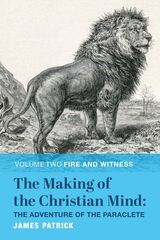 The Making of the Christian Mind: The Adventure of the Paraclete: Volume II: Fire and Witness
James Patrick
St. Augustine's Press, 2021 Fire and Witness is the second volume in James Patrick’s saga recounting the current of inspiration guiding, and at times sweeping, the Christian heart toward full integration of the mind in the experience of revelation. In the first volume, A Waiting World, Patrick like a true storyteller captures the wonder and anxiety that finally perceives design and canon.
The second installment presents the parallel struggle to build heart and mind, as heresy and temporal demands challenge the memory and vitality of what Christians have received. The writing mind in this sense sustains and gives purpose to the heart, pressed under the burden of doubt and worldly expectation. The reader knows that Christianity endures, but how did this happen? Patrick at every turn discloses the role of the Paraclete who remains the unseen protagonist. In this sense, Patrick surprises even those who think they know the story, and no one is safe from being exposed to a bit of the same inspiration that moves the characters in history passed. Indeed, the reader will feel like a part of this same narrative, in a new unwritten chapter but encountering the same Paraclete who has meddled in and marked events with holy breath that even Patrick cannot fully represent.
Highlights of Fire and Witness are Patrick’s presentation of pivotal yet forgotten works such as The Shepherd of Hermes, and his treatment of Origen and Athanasius in their respective social and spiritual contexts. This volume grants the reader a glimpse into a time when resolutions needed to be made and defended with argument, but also with silent witness and the flame of a resolve dimmed not even by death. Patrick’s description of imperial Christianity and the Christian imagination that ultimately fashions the proper image of Christian places is likewise stunning and not to be missed.
 The Making of the Civil Law
Alan Watson
Harvard University Press, 1981 This wide-ranging book is a comparative study of the civil law, primarily the legal systems of western continental Europe and Latin America. It attempts to account for the distinctive features of civil law systems and hence to contribute to an understanding of the forces that cause law to change. The author contends that the basic differences between civil-law and common-law systems derive from legal history rather than from social, economic, or political developments. Above all, he argues, it was the acceptance of the authority of Justinian's Corpus Juris Civilis that determined the future nature of civil-law systems and gave them their distinctive character.
Mr. Watson outlines the features of Roman law as codified by Justinian that made it adaptable in countries with widely differing political systems, social structures, and local court practices. His learned and lucid exposition encompasses the role and influence of professors of Roman law in medieval universities; the manner and extent to which the case law of various countries drew upon the Corpus Juris; the role of the Institutes as a model for the institutes of local law which were the immediate ancestors of most of the national codes; and the effect of the Corpus Juris on basic features of the civil law, such as the fundamental division between public and private law, with different courts for the two, and the separation of commercial law from the rest of private law.
Scholars may debate his thesis, but none will dispute Alan Watson's command of the sources and his mastery of legal material spanning many centuries and countries. His book will present a challenge to legal historians and students of comparative law, and it will provide Anglo-American lawyers with insight into the nature of civil-law systems.
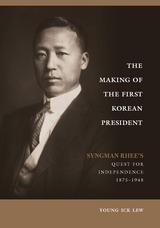 The Making of the First Korean President: Syngman Rhee's Quest for Independence, 1875-1948
Young Ick Lew
University of Hawaii Press, 2014 The only full-scale history of Syngman Rhee’s (1875–1965) early career in English was published nearly six decades ago. Now, in The Making of the First Korean President, Young Ick Lew uncovers little-known aspects of Rhee’s leadership roles prior to 1948, when he became the Republic of Korea’s first president. In this richly illustrated volume, Lew delves into Rhee’s background, investigates his abortive diplomatic missions, and explains how and why he was impeached as the head of the Korean Provisional Government in 1925. He analyzes the numerous personal conflicts between Rhee and other prominent Korean leaders, including some close friends and supporters who eventually denounced him as an autocrat.
Rhee is portrayed as a fallible yet charismatic leader who spent his life fighting in the diplomatic and propaganda arena for the independence of his beleaguered nation—a struggle that would have consumed and defeated lesser men. Based on exhaustive research that incorporates archival records as well as secondary sources in Korean, English, and Japanese, The Making of the First Korean President meticulously lays out the key developments of Rhee’s pre-presidential career, including his early schooling in Korea, involvement in the reform movement against the Taehan (“Great Korean”) Empire, and his six-year incarceration in Seoul Prison for a coup attempt on Emperor Kojong. Rhee’s life in the U.S. is also examined in detail: his education at George Washington, Harvard, and Princeton universities; his evangelical work at the Seoul YMCA; his extensive activities in Hawai‘i and attempts to maintain prestige and power among Koreans in the U.S. Lew concludes that, despite the manifold shortcomings in Rhee’s authoritarian leadership, he was undoubtedly best prepared to assume the presidency of South Korea after the onset of the Cold War in the Korean Peninsula.
Essential reading for anyone with an interest in modern Korean history, this work will serve as a lasting portrait of one of the pivotal figures in the evolution of Korea as it journeyed from colonial suppression to freedom and security.
Young Ick Lew is a former Chair Professor of Korean Studies, Graduate School of International Studies, Yonsei University in Seoul. Currently, he is T. H. Elema Chair Professor of Korean history at Handong Global University in P’ohang and a senior counselor to the Syngman Rhee Institute, Yonsei University.
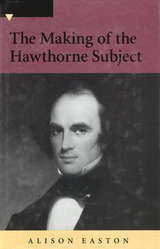 The Making of the Hawthorne Subject
Alison Easton
University of Missouri Press, 1996
This comprehensive study of Nathaniel Hawthorne's early writings analyzes the development of Hawthorne's work over the first twenty-five years of his career. Alison Easton studies that process in relation to current critical debates on subjectivity. By examining Hawthorne's novels, sketches, tales, letters, notebooks, reviews, and children's books up to the publication of The Scarlet Letter, Easton shows how Hawthorne tried to understand the complexities of the clash between desire (that which is unrecognized by the social order) and circumstance (the conditions under which one must live in society). The Hawthorne who emerges from this study proves to be a sophisticated theorist of subjectivity, whose project was central to his times.
The author contends that over the first half of his career Hawthorne explored, experimented, and negotiated his way toward a better model of the human subject than the ones that are usually seen as his cultural inheritance. This approach implies a complex, dialectic development in Hawthorne's work, arising from twenty-five years of accumulated experimentation and ongoing debate. Nearly all critics of Hawthorne have ignored this element of development, thus missing the complex evolution of the subject and the revealing intertextual play of meaning that is evident in everything Hawthorne wrote during this period. Easton's study is the first to supply a full chronology for the works written during these years, and the only one to consider in close detail the full and bewilderingly diverse range of his writing throughout this period and to find an overall pattern in the several stages of his intellectual and artistic enterprise.
Easton brings to scholars and students of nineteenth-century American literature a study of Hawthorne's work that is unique in both scope and perspective. The Making of the Hawthorne Subject offers a substantial and original contribution to the way we think about Hawthorne's work and the relationship of the human subject to the social order of mid-nineteenth-century America.
The Making of the Humanities: Volume II: From Early Modern to Modern Disciplines
Edited by Rens Bod, Jaap Maat, and Thijs Weststeijn
Amsterdam University Press, 2013
While it is clear that around 1800 the humanities as a discipline rose to prominence, it is less clear what the exact nature of this shift in academia was. Was it a sudden revolution caused by a momentary but powerful change in the zeitgeist or the turning point of a much longer process? In this volume, the editors have selected a series of essays that look at the origins of the humanities and find that long before 1800 the concept of the humanities was already at the fore. The shift around 1800 was thus mostly institutional, not theoretical. The Making of the Humanities traces this new finding through a broad range of disciplines including literary theory, linguistics, art history, and musicology.
The Making of the Humanities, Volume III: The Modern Humanities
Edited by Rens Bod, Jaap Maat, and Thijs Weststeijn
Amsterdam University Press, 2014 This comprehensive history of the humanities focuses on the modern period (1850-2000). The contributors, including Floris Cohen, Lorraine Daston and Ingrid Rowland, survey the rise of the humanities in interaction with the natural and social sciences, offering new perspectives on the interaction between disciplines in Europe and Asia and new insights generated by digital humanities.
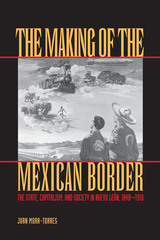 The Making of the Mexican Border: The State, Capitalism, and Society in Nuevo León, 1848-1910
By Juan Mora-Torres
University of Texas Press, 2001 The issues that dominate U.S.-Mexico border relations today—integration of economies, policing of boundaries, and the flow of workers from south to north and of capital from north to south—are not recent developments. In this insightful history of the state of Nuevo León, Juan Mora-Torres explores how these processes transformed northern Mexico into a region with distinct economic, political, social, and cultural features that set it apart from the interior of Mexico. Mora-Torres argues that the years between the establishment of the U.S.-Mexico boundary in 1848 and the outbreak of the Mexican Revolution in 1910 constitute a critical period in Mexican history. The processes of state-building, emergent capitalism, and growing linkages to the United States transformed localities and identities and shaped class formations and struggles in Nuevo León. Monterrey emerged as the leading industrial center and home of the most powerful business elite, while the countryside deteriorated economically, politically, and demographically. By 1910, Mora-Torres concludes, the border states had already assumed much of their modern character: an advanced capitalist economy, some of Mexico's most powerful business groups, and a labor market dependent on massive migrations from central Mexico.
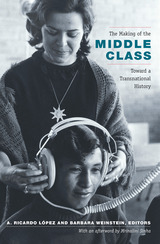 The Making of the Middle Class: Toward a Transnational History
A. Ricardo López and Barbara Weinstein, eds.
Duke University Press, 2012 In this important and timely collection of essays, historians reflect on the middle class: what it is, why its struggles figure so prominently in discussions of the current economic crisis, and how it has shaped, and been shaped by, modernity. The contributors focus on specific middle-class formations around the world—in Africa, Asia, Europe, the Middle East, and the Americas—since the mid-nineteenth century. They scrutinize these formations in relation to the practices of modernity, to professionalization, to revolutionary politics, and to the making of a public sphere. Taken together, their essays demonstrate that the historical formation of the middle class has been constituted transnationally through changing, unequal relationships and shifting racial and gender hierarchies, colonial practices, and religious divisions. That history raises questions about taking the robustness of the middle class as the measure of a society's stability and democratic promise. Those questions are among the many stimulated by The Making of the Middle Class, which invites critical conversation about capitalism, imperialism, postcolonialism, modernity, and our neoliberal present.
Contributors. Susanne Eineigel, Michael A.Ervin, Iñigo García-Bryce, Enrique Garguin, Simon Gunn, Carol E. Harrison, Franca Iacovetta, Sanjay Joshi, Prashant Kidambi, A. Ricardo López, Gisela Mettele, Marina Moskowitz, Robyn Muncy, Brian Owensby, David S. Parker, Mrinalini Sinha, Mary Kay Vaughan, Daniel J. Walkowitz, Keith David Watenpaugh, Barbara Weinstein, Michael O. West
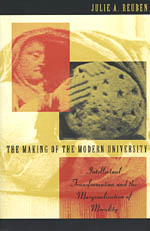 The Making of the Modern University: Intellectual Transformation and the Marginalization of Morality
Julie A. Reuben
University of Chicago Press, 1996 What is the purpose of higher education, and how should we pursue it? Debates over these issues raged in the late nineteenth century as reformers introduced a new kind of university—one dedicated to free inquiry and the advancement of knowledge. In the first major study of moral education in American universities, Julie Reuben examines the consequences of these debates for modern intellectual life.
Based on extensive research at eight universities—Harvard, Yale, Columbia, Johns Hopkins, Chicago, Stanford, Michigan, and California at Berkeley—Reuben examines the aims of university reformers in the context of nineteenth-century ideas about truth. She argues that these educators tried to apply new scientific standards to moral education, but that their modernization efforts ultimately failed. By exploring the complex interaction between institutional and intellectual change, Reuben enhances our understanding of the modern university, the secularization of intellectual life, and the association of scientific objectivity with value-neutrality.
 The Making of the Monroe Doctrine
Ernest R. May
Harvard University Press, 1975 In an extraordinary display of the historical imagination at work, Ernest May has reinterpreted the genesis of the Monroe Doctrine and written an exceptional study of the relationship of policymakers to political structure. The author shows how domestic politics, more especially the upcoming 1824 presidential election, dictated the content and meaning of the Monroe Doctrine. May accomplishes his task by systematically examining the ideological perceptions of American policymakers and the foreign policies of Great Britain, France, and Russia. He concludes that the policymakers had wide freedom of choice. He then makes a searching study of United States internal politics and finds that there were no interest group pressures influencing decision-makers—it was an era of non-issues. Effectively eliminating the usual forces that shape foreign policy, the author develops a subtle and sophisticated case for the controlling power of presidential politics. May builds a case of relentless logic, giving us a historical reconstruction that is as fascinating in its unfolding as it is convincing in its assumptions and conclusions.
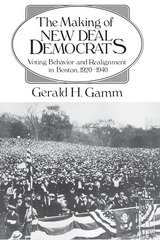 The Making of the New Deal Democrats: Voting Behavior and Realignment in Boston, 1920-1940
Gerald H. Gamm
University of Chicago Press, 1990 "Why is The Making of New Deal Democrats so significant? One of the major controversies in the study of American elections has to do with the nature of electoral realignments. One school argues that a realignment involves a major shift of voters from one party to another, while another school argues that the process consists largely of mobilization of previously inactive voters. The debate is crucial for understanding the nature of the New Deal realignment.
Almost all previous work on the subject has dealt with large-scale national patterns which make it difficult to pin down the precise processes by which the alignment took place. Gamm's work is most remarkable in that it is a close analysis of shifting voter alignments on the precinct and block level in the city of Boston. His extremely detailed and painstaking work of isolating homogeneous ethnic units over a twenty-year period allows one to trace the voting behavior of the particular ethnic groups that ultimately formed the core of the New Deal realignment."—Sidney Verba, Harvard University
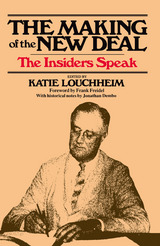 The Making of the New Deal: The Insiders Speak
Katie Louchheim
Harvard University Press, 1983 There has never been a phenomenon in American life to equal the invasion of Washington by the young New Dealers—hundreds of men and women still in their twenties and thirties, brilliant and dedicated, trained in the law, economics, public administration, technology, pouring into public life to do nothing less than restructure American society. They proposed new programs, drafted legislation, staffed the new agencies. They were active in the Administration, the Congress, the courts, the news media. They fanned out all over America to discover the facts, plan ways of easing the pain of their foundering country, and report on the results. Many of them went on to be rich, famous, and powerful, but their early experience in Washington was perhaps the most inspiriting of their lives.
Katie Louchheim was among those who arrived in Washington in the 1930s, and being a keen writer as well as the wife of a member of the SEC, she had a front-row seat for the spectacle of social progress. Now, a half-century later, she has gathered reminiscences from her old friends and colleagues, interviewed others, and woven them together into a lively, informal word-picture of that exciting time. Among the many insiders who recount their views are Alger Hiss, Robert C. Weaver, Paul A. Freund, James H. Rowe, Wilbur J. Cohen, Abe Fortas, David Riesman, and Joseph L. Rauh. This book, a singular and uplifting primary document of an extraordinary period, is destined to appeal across a wide spectrum of readers of American history.
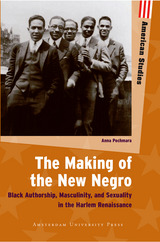 The Making of the New Negro: Black Authorship, Masculinity, and Sexuality in the Harlem Renaissance
Anna Pochmara
Amsterdam University Press, 2011 The Making of the New Negro examines black masculinity in the period of the Harlem Renaissance, a cultural movement that spanned the 1920s and 1930s in America and was marked by an outpouring of African American art, music, theater and literature. The Harlem Renaissance, or New Negro Movement, began attracting extensive academic attention in the 1990s as scholars discovered how complex, significant, and fascinating it was.
Drawing on African American texts, archives, unpublished writings, and contemporaneous European discourses, this book highlights both the canonical figures of the New Negro Movement and African American culture such as W. E. B. Dubois, Booker T. Washington, Alain Locke, and Richard Wright, and other writers such as Wallace Thurman, who have not received as much scholarly attention despite their significant contributions to the movement.
Anna Pochmara offers a striking combination of thorough literary analysis and historicist investigation in order to provide novel insights into one of the most important periods of black history in the United States.
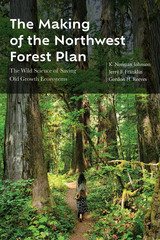 The Making of the Northwest Forest Plan: The Wild Science of Saving Old Growth Ecosystems
K. Norman Johnson
Oregon State University Press, 2023 Tree sitters. Logger protests. Dying timber towns. An iconic species on the brink. The Timber Wars consumed the Pacific Northwest in the late 1980s and early1990s and led political leaders to ask scientists for a solution. The Northwest Forest Plan was the result. For most of the twentieth century, the central theme of federal forest management in the Pacific Northwest had been logging old-growth forests to provide a sustained yield of timber. During the 1970s and 1980s, however, a series of studies by young scientists highlighted the destructive impact of that logging on northern spotted owls, salmon, and the old-growth ecosystem itself. Combining this new science with newly minted environmental laws like the Endangered Species Act, environmental activists obtained court injunctions to stop old-growth logging on federal land, setting off a titanic struggle in the Pacific Northwest to find a way to accommodate conservation imperatives as well as the logging that provided employment for tens of thousands of people. That effort involved years of controversy and debate, federal courts, five science assessments, Congress, and eventually the president of the United States. It led to creation of the Northwest Forest Plan, which sharply and abruptly shifted the primary goal of federal forestry toward conserving the species and ecosystems of old-growth forests. Scientists went from spectators to planners and guides, employing their latest scientific findings and expertise to create a forest plan for 20 million acres that would satisfy the courts. The largest upheaval in federal forest management in history had occurred, along with a precipitous decline in timber harvest, and there was no going back. In this book, three of the scientists who helped craft that change tell the story as they know it: the causes, development, adoption, and implementation of the Northwest Forest Plan. The book also incorporates personal reflections from the authors, short commentaries and histories from key figures— including spotted owl expert Eric Forsman—and experiences from managers who implemented the Plan as best they could. Legal expert Susan Jane M. Brown helped interpret court cases and Debora Johnson turned spatial data into maps. The final chapters cover the Plan’s ongoing significance and recommendations for conserving forest and aquatic ecosystems in an era of megafires and climate change.
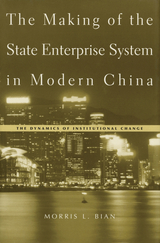 The Making of the State Enterprise System in Modern China: The Dynamics of Institutional Change
Morris L. Bian
Harvard University Press, 2005 When, how, and why did the state enterprise system of modern China take shape? The conventional argument is that China borrowed its economic system and development strategy wholesale from the Soviet Union in the 1950s. In an important new interpretation, Morris Bian shows instead that the basic institutional arrangement of state-owned enterprise—bureaucratic governance, management and incentive mechanisms, and the provision of social services and welfare—developed in China during the war years 1937–1945.
Bian offers a new theory of institutional change that explains the formation of China’s state enterprise system as the outcome of the sustained systemic crisis triggered by the Sino–Japanese war. This groundbreaking work combines critical analysis of government policies with case studies of little-studied enterprises in heavy industries and the ordnance industry. Drawing on extensive research in previously unavailable archives, Bian adds a valuable historical perspective to the current debate on how to reform China’s sluggish and unprofitable state-owned firms.
The Making of the Supply Chain: How Five CSCMP Supply Chain Hall of Famers Shaped the Industry
Remko van Hoek
Epic Books, 2024 In The Making of the Supply Chain, Remko van Hoek explores the stories of five very different supply chain pioneers—George Stephenson, Henry Ford, George Lauer, Elizabeth Dole, and J. B. Hunt—to demonstrate how innovations in supply chain management have changed the world by reshaping how we obtain our products and services. Van Hoek reflects on these leaders’ seminal achievements in supply chain management, relates their breakthroughs to current best practices and opportunities for the future, and chronicles how other leaders have converted lessons from these Hall of Famers into new breakthroughs. Informed by his work with the Council of Supply Chain Management Professionals (CSCMP) Supply Chain Hall of Fame,Van Hoek presents these inspiring stories in an engaging and highly accessible style.
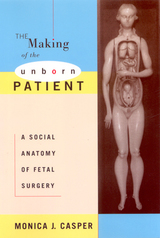 The Making of the Unborn Patient: A Social Anatomy of Fetal Surgery
Casper, Monica J
Rutgers University Press, 1998 Winner of the 1998 C. Wright Mills Award from the Society for the Study of Social Problems
It is now possible for physicians to recognize that a pregnant woman's fetus is facing life-threatening problems, perform surgery on the fetus, and if it survives, return it to the woman's uterus to finish gestation. Although fetal surgery has existed in various forms for three decades, it is only just beginning to capture the public's imagination. These still largely experimental procedures raise all types of medical, political and ethical questions. Who is the patient? What are the technical difficulties involved in fetal surgery? How do reproductive politics seep into the operating room, and how do medical definitions and meanings flow out of medicine and into other social spheres? How are ethical issues defined in this practice and who defines them? Is fetal surgery the kind of medicine we want? What is involved in reframing fetal surgery as a women's health issue, rather than simply a pediatric concern? In this ethnographic study of the social, cultural and historical aspects of fetal surgery, Monica Casper addresses these questions. The Making of the Unborn Patient examines two important and connected events of the second half of the 20th century: the emergence of fetal surgery as a new medical specialty and the debut of the unborn patient.
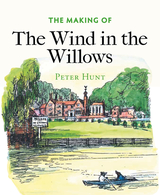 The Making of The Wind in the Willows
Peter Hunt
Bodleian Library Publishing, 2018 The adventures of Mole, Ratty, Mr. Toad, and Mr. Badger—and their tangles with the Weasels—have been adored by children for more than a century. Yet, with its oddly bureaucratic town dramas and the esoteric hobbies of its protagonists, The Wind in the Willows was originally intended almost entirely for adults. Though first inspired by bedtime stories Kenneth Grahame told to his son Alastair, as he wrote them down, the tales of these woodland creatures developed into something much more sophisticated.
Peter Hunt explores the unusual trajectory of The Wind in the Willows through previously unpublished archival materials, original drawings, and fan letters (including one from Theodore Roosevelt). He identifies the colleagues and friends on whom Grahame is thought to have based the characters of Mole, Rat, Badger, and Toad, and explores the literary genres of boating, caravanning, and motoring on which the author drew. He also recounts the extraordinary correspondence surrounding the book’s first publication and the influence of two determined women—publisher’s agent Constance Smedley and the author’s wife, Elspeth Grahame—who helped turn the book into the classic for children we know and love today. Generously illustrated throughout, this book celebrates one of the most beloved works of children’s literature ever published.
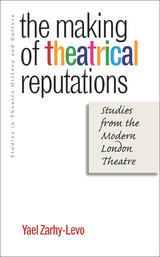 The Making of Theatrical Reputations: Studies from the Modern London Theatre
Yael Zarhy-Levo
University of Iowa Press, 2008 Today's successful plays and playwrights achieve their prominence not simply because of their intrinsic merit but because of the work of mediators, who influence the whole trajectory of a playwright's or a theatre company's career. Critics and academic writers are primarily considered the makers of reputations, but funding organizations and various media agents as well as artistic directors, producers, and directors also pursue separate agendas in shaping the reputations of theatrical works. In The Making of Theatrical Reputations Yael Zarhy-Levo demonstrates the processes through which these mediatory practices by key authority figures situate theatrical companies and playwrights within cultural and historical memory. To reveal how these authorizing powers-that-be promote theatrical events, companies, and playwrights, Zarhy-Levo presents four detailed case studies that reflect various angles of the modern London theatre. In the case of the English Stage Company's production of John Osborne's Look Back in Anger, she centers on a specific event. She then focuses on the trajectory of a single company, the Theatre Workshop, particularly through its first decade at the Theatre Royal, Stratford East, London. Next, she explores the career of the dramatist John Arden, especially its first ten years, in part drawing upon an interview with Arden and his wife, actress and playwright Margaretta D'Arcy, before turning to her fourth study: the playwright Harold Pinter's shifting reputation throughout the different phases of his career. Zarhy-Levo's accounts of these theatrical events, companies, and playwrights through the prism of mediation bring fresh insights to these landmark productions and their creators.
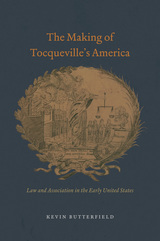 The Making of Tocqueville's America: Law and Association in the Early United States
Kevin Butterfield
University of Chicago Press, 2015 Alexis de Tocqueville was among the first to draw attention to Americans’ propensity to form voluntary associations—and to join them with a fervor and frequency unmatched anywhere in the world. For nearly two centuries, we have sought to understand how and why early nineteenth-century Americans were, in Tocqueville’s words, “forever forming associations.” In The Making of Tocqueville’s America, Kevin Butterfield argues that to understand this, we need to first ask: what did membership really mean to the growing number of affiliated Americans?
Butterfield explains that the first generations of American citizens found in the concept of membership—in churches, fraternities, reform societies, labor unions, and private business corporations—a mechanism to balance the tension between collective action and personal autonomy, something they accomplished by emphasizing law and procedural fairness. As this post-Revolutionary procedural culture developed, so too did the legal substructure of American civil society. Tocqueville, then, was wrong to see associations as the training ground for democracy, where people learned to honor one another’s voices and perspectives. Rather, they were the training ground for something no less valuable to the success of the American democratic experiment: increasingly formal and legalistic relations among people.
|
|


